

The True Cost of Living on a Sailboat: Our Monthly Expenses

As an Amazon Associate, we earn from qualifying purchases. We also earn from other affiliate websites. See our full disclaimer .
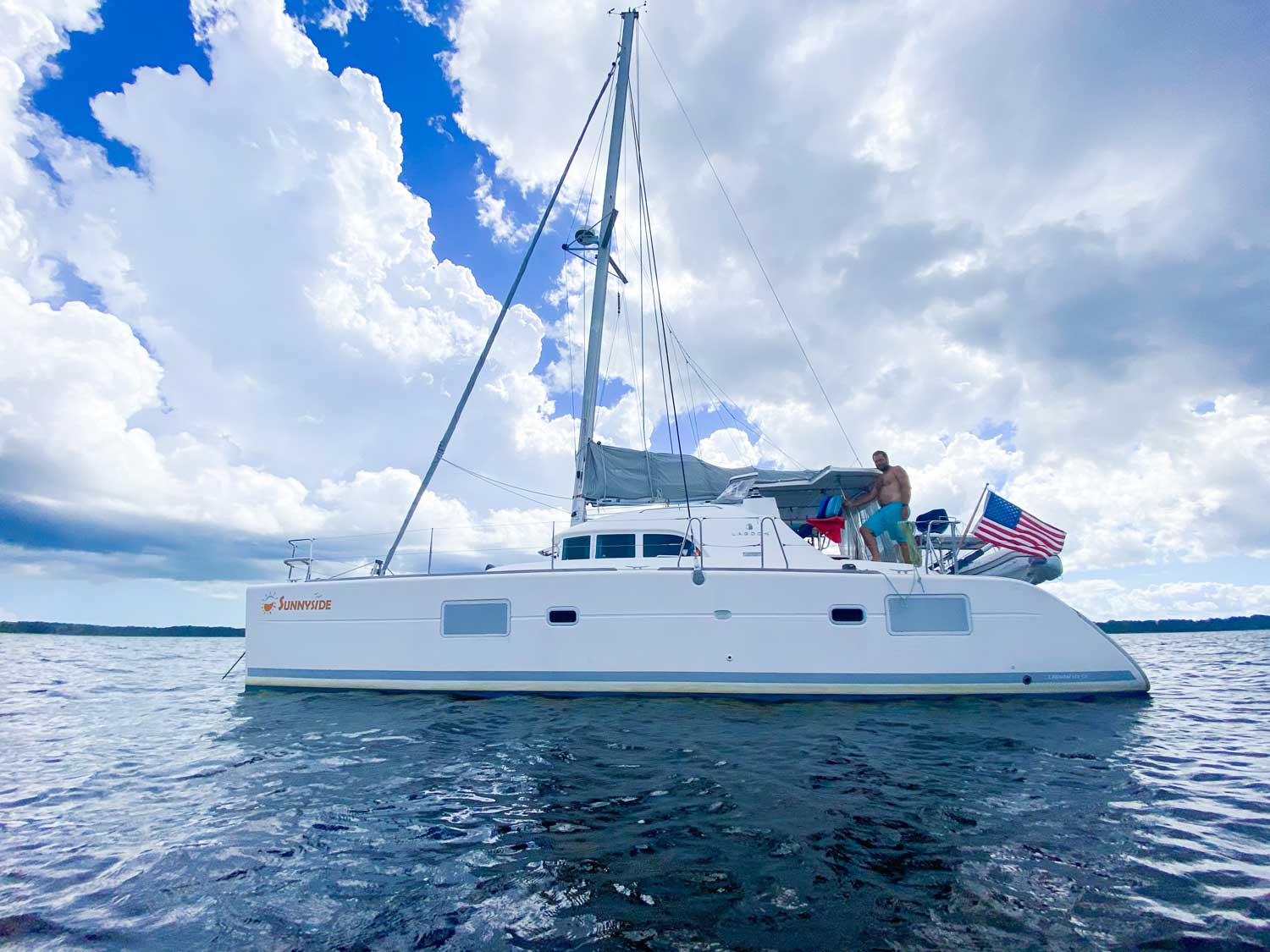
How much does it cost to live on a boat? This was my biggest question when we were planning and saving to cruise. I was clueless when it came to creating a budget for our future life aboard. I was looking for someone to tell me exactly how much it would cost ME to live on a sailboat full-time.
I quickly learned some people cruise for less than $1,000 a month and some for upwards of $10,000 a month. Most are somewhere between.
Not so dissimilar from living on land, different people cruise on all sorts of budgets.
For us, our cost of living on a sailboat isn’t so far from our land-based spending.
Part of this journey was learning to live with less, but we still maintain some creature comforts on the water.
Here is a breakdown of our cost of living on a boat full-time while cruising the US east coast.
Cost to Live on a Sailboat
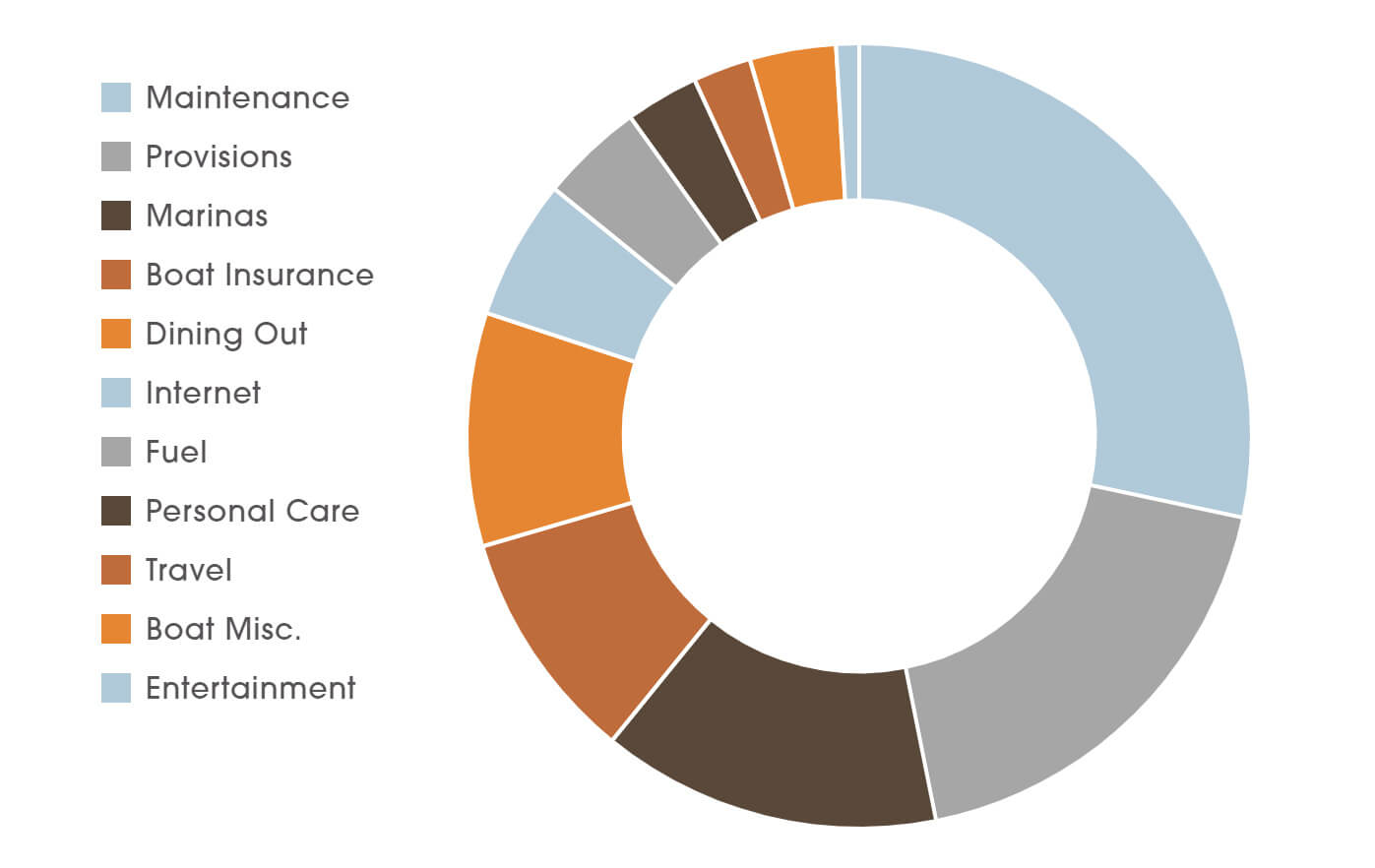
Average cost of $2,424 per month*
Sailboat Maintenance Expenses
Average cost $1,006.
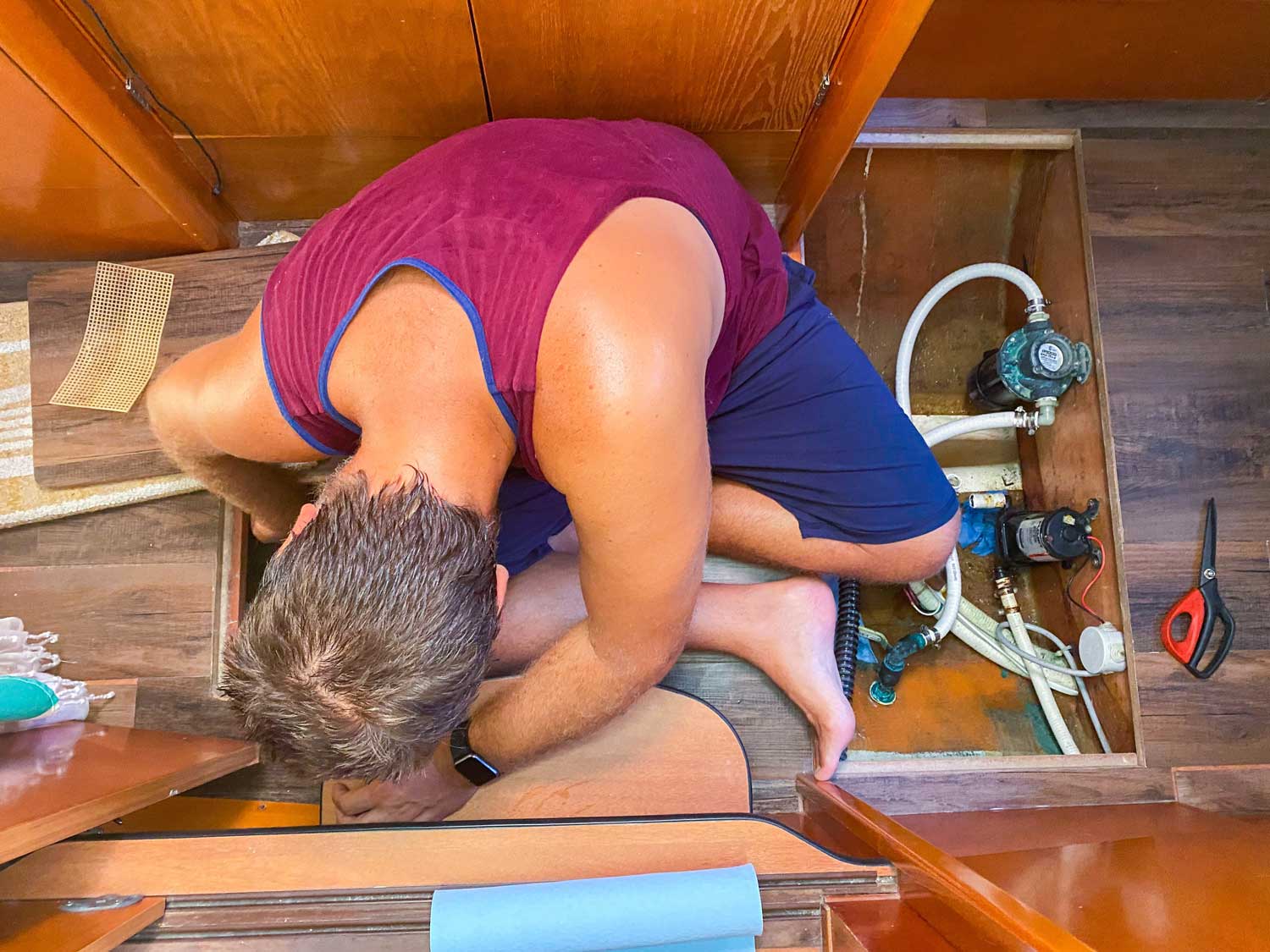
Maintenance, Parts & Tools ($687)
It’s no surprise boat maintenance is top of the list.
You will continuously be fixing broken things or maintaining things on a sailboat. You will also need different tools, spare parts, cleaners, etc., as you cruise.
There will be months when you won’t need much in the way of tools and parts (especially if you already have a lot of tools and spare parts onboard). Then in one month, you might spend 40% of the annual budget.
We make a strong effort to do most boat projects ourselves.
Shortly after we began cruising, our wallets learned the hard truth of paying people to work on your boat.
Since then, we’ve been our own plumber, mechanic, seamstress, and electrician.
You’ll always be learning. But if you can maintain and fix your vessel, you’ll save boatloads of cash (pun intended, I couldn’t resist).
READ NEXT: Check out our 9 Helpful Things You Need in Your Sailboat Tool Kit .
Insurance ($233).
If you are a newbie cruiser, your boat insurance options will most likely be limited. Insurance was a considerable expense in our first year. In our second year, the cost dropped from 2.8% of the boat’s value to 1.3%. (We now have restricted cruising grounds for July – November.)
Do your research and consider using a broker. Get quotes based on where you’ll be cruising and staying in hurricane season.
Miscellaneous ($86)
The miscellaneous category is everything else boat-related. This includes any small purchases we make for the boat (ex. rug for the salon), our USCG documentation, Amazon Prime membership, etc.
We also have a Boat US membership , which more than pays for itself. We get dockage and fuel discounts often. And, of course, the towing service is priceless when you run aground with only one engine. (What, just me?)
For a modest fee, this membership is a no-brainer for boat owners.
Marinas vs. Anchoring
Average cost $339.

Marina Costs
If you’ve been researching the cost of living on a boat, you know it is more economical to anchor than to dock in a marina slip. We love anchoring out, but it does come with a set of variables that dictate comfort and safety while you’re on the hook. Not to mention, it requires a lot more planning.
Marinas can be expensive, especially in popular cruising areas. Dockage is usually charged per foot, so the bigger the boat, the higher the costs associated with docking fees. However, you can find liveaboard boat marinas with slip fees that are paid monthly.
Many cruisers prefer to dock at a liveaboard marina during hurricane season and save anchoring for cruising season. This allows you to keep your cost per night at marinas down, and your overall costs balance out throughout the year.
READ NEXT: Check out our post on Liveaboard Marinas: Finding the Best One for You .
Anchoring challenges.
Dreaming of our cruising days, I had the idea we would anchor out and rarely pay for marinas.
In reality, that’s not what worked for us out of the gate. Being beginner sailors and newbies to cruising and boats in general – there was an enormous learning curve.
Learning to live this lifestyle is not always easy. And yes, marinas make it easier. Especially when you REALLY need it to be easier.
Anchoring out requires the captain to always be “on”. You must be aware of the weather, wind direction, currents, and tides. You also have to be aware of the boats around you. None of this stops when you leave the boat or when you sleep.
The reality is you need to slowly become more comfortable living on the hook.
With experience, you can build more confidence.
You’ll become more comfortable with boat systems, weather, and making repairs while on the anchor. Conserving power and water becomes more natural, and you learn how to stay warm in the cold and cool off in hot weather. With some practice, you can spend less time (and money) at marinas.
For folks dreaming of this lifestyle, I’m not saying you won’t be able to start living on the anchor immediately. But the stress level accompanying living on the hook will lower with time and experience.
Average Cost $449
Provisions are consistently one of our most significant expenses on the boat.
Anticipating my new life on the water, I knew I wanted to learn more about cooking, baking, and making things from scratch. And since we planned to live on a smaller budget, I also wanted to be conscious of spending on food.
A game I often play with myself is to see how long we can go until the next big provisioning trip.

You might be thinking – that sounds miserable. But we eat pretty darn well most of the time.
We ration veggies and fruits, ensuring we leave the hardiest for last. We start with fresh salads and other raw veggie meals, such as cilantro hummus bowls. As the freshest veggies thin out, we work our way to curries and stir-fries. Then, when the fridge grows empty, we move on to rice and bean dishes, pineapple and jalapeño pizza, and bean tacos with pickled onions and cabbage.
One skillset you develop living on a boat is the ability to eat more sustainably.
Learning to make bread, yogurt, and vegetable broth from scraps is super satisfying.
Spend time learning to make flexible meals. Use a balance of fresh, canned, and dried ingredients. Do this, and you can stretch your provisioning budget without sacrificing flavor.
You can also save money by minimizing disposables, such as paper towels, sandwich bags, plastic wrap, and aluminum foil.
READ NEXT: Check out our ideas for Flexible Meals on a Boat and our Best Zero Waste Swaps for Small Spaces .
Having sundowners is a bit of a staple in the boating community. It’s a common way to meet and greet other boaters in a marina or in an anchorage. Given that, we always like to have a few extra beers onboard or the ingredients for a simple cocktail.
We love good wine, but we managed to find some enjoyable boxed wines. (Bonus, lose the boxes at the dock, and there’s very little trash to contend with.)
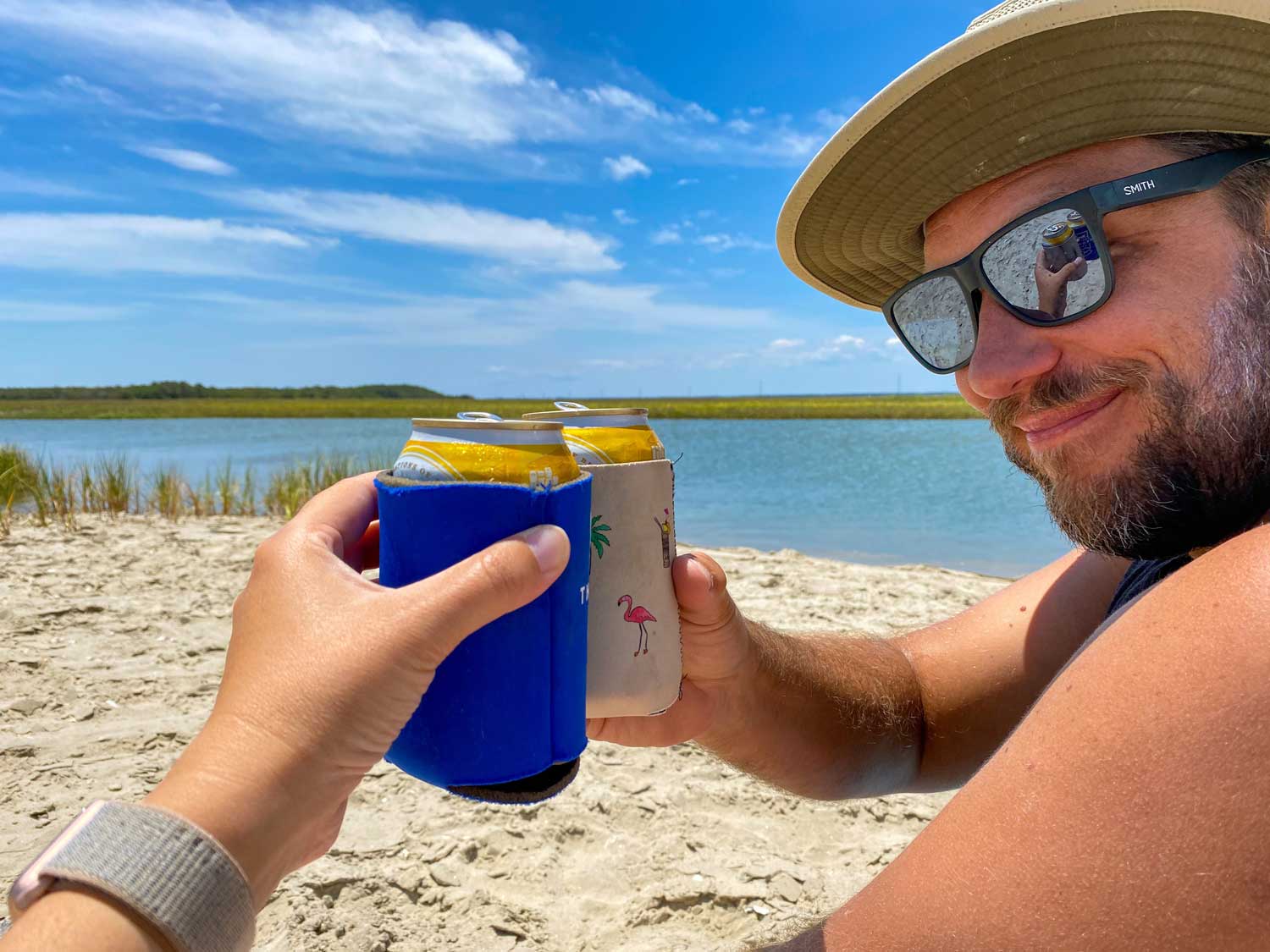
When we find a deal, we stock up on beer. Nothing hits the spot like a cold beer after the anchor drops. We even discovered a reasonably priced rum we enjoy. (No boat is complete without rum!)
Expenses here are based on personal taste. For us, it was possible to have more affordable beverages and still enjoy sundowner traditions!
Average Cost $233

As a couple who dined out regularly in our Colorado ski town, it was going to be tough to start cooking three meals a day living aboard.
I read a lot of advice that said, “if you like eating out, you probably won’t stop eating out because you move on a boat.”
There is truth to this. Whenever we are in a place where eating out is convenient, we tend to fall back into old habits.
However, when we dock in remote places or anchor away from shore access, there is less (or no) opportunity to eat out.
Instead, we experiment with different types of food to make meals onboard rewarding.
We still enjoy going out to experience the local cuisine, but it has become a treat instead of how we live.
A great way to cut costs is by dining out for a late lunch rather than dinner or skipping the alcohol. Opting for a refreshing drink on the trampoline while watching the sunset isn’t a bad way to close out a night.
Average Cost $103
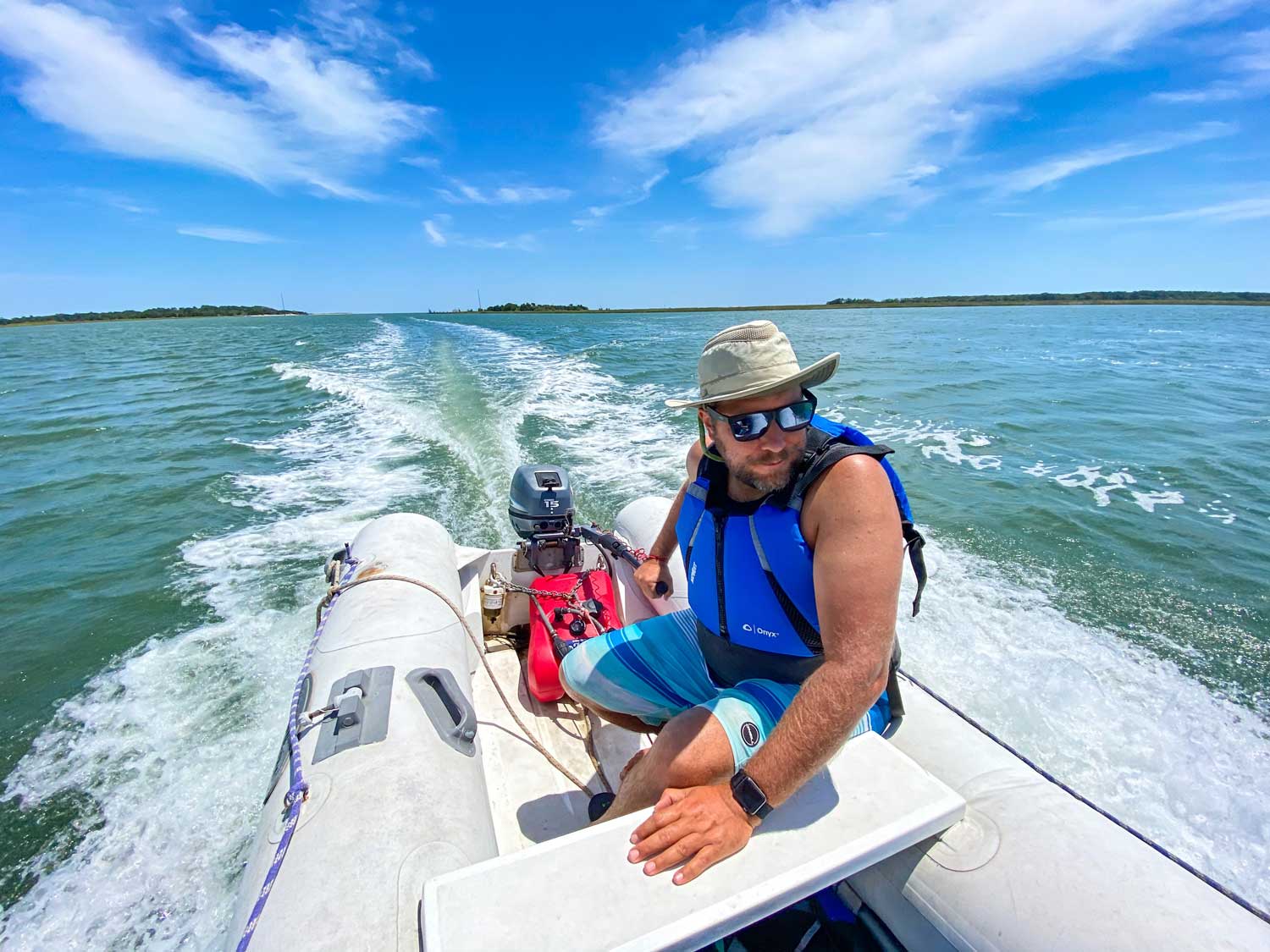
Diesel, gas, and propane are three resources you will continuously be aware of while living on a boat.
Here are a few adjustments we make to maximize our fuel efficiency.
- We use our sails. This isn’t easy as new sailors on a big boat. We have slowly become more confident, but it took us months of traveling on the water to start getting comfortable using the sails. We are still learning.
- We don’t put ourselves in a position where we are in a hurry or have a schedule. This almost always leads to running the engines more.
- We run on one engine. We can run one engine instead of two on our catamaran and only lose about 1 – 1.5 knots. On the ICW, we unfurl the jib to improve speed if the wind is right.
- We always make sure to travel at an optimal time for the current. Some areas of the Intercoastal Waterway can have a current that’s pushing 2-3 knots. Choosing a departure time around the current makes a big difference in travel time and fuel efficiency.
- Heating water with the electric kettle if the engines are running or we are on shore power.
- Using hot water from the engines (when we have it) to get water boiling.
- When cooking pasta, we use a minimal amount of water. We’ll often turn the propane off and let the noodles finish cooking in the hot water.
- Quality cookware makes a big difference. Once brought to a boil, some dishes can finish cooking with the lid on. This is helpful when coming into an anchorage. Often, I’ll kill the propane, and by the time we are anchored, dinner is ready.
- If we plan to make a few trips to shore, we’ll anchor closer to the dinghy dock. This doesn’t always work out, but being conscious of it has helped us stretch our gas budget.
- If it’s a short trip to the dock and we aren’t carrying supplies, we use the kayak. Paddling is free (and fun)!
Average Cost $140

When we were saving for the cruising kitty, we found ways to cut our mobile bill by using data on our home and work WiFi. When we moved aboard, our phone plan became the primary internet source. We quickly realized we would need to rethink our data plan.
There are a lot of options for unlimited data in the US, as well as hotspot data. I recommend having at least unlimited mobile data for research and logistics involved when cruising. If you need to work from the boat, you may also want to invest in an additional mobile service as backup or satellite internet. Starlink is starting to become popular in the boating community.
Our Mobile Plan
While cruising the east coast, we use T-Mobile. With this carrier, we get unlimited data and 40GB of hotspot data each month (20GB per phone). This is on the pricier end, and we have been looking into other options, but we enjoy having the hotspot data. Even after the 40GB, we still have hotspot data at 2G. When we cruise the Bahamas, we are planning to use My Island WiFi service .
Entertainment
Average cost $23.

This category is for consumable entertainment since most other entertainment on the water is free.
Music, movies, and books are popular forms of entertainment onboard. Even when we cut down on spending, we kept a few options that provided these services. Instead of ditching all the monthly streaming apps, we looked hard at our memberships and cut back or found free services to supplement.
- Spotify membership for music (we can download or stream) $11
- Movie library on an external hard drive created before we ditched our DVDs Free
- Hulu (included with Spotify) Free
- Disney Plus (prepaid for three years during a special offer) $4
- Nexflix (included with T-Mobile plan) Free
- Tubi (a free streaming app) Free
Spotify and Audible are great for downloading books and playlists for when you are out of service or on passage. You can also download movies and shows through many streaming apps for playback when you don’t have a signal or are running on a budgeted amount of mobile data. An external hard drive of your favorite movies is also a great source of video entertainment that will never let you down.
Personal Care & Clothing
Average cost $73.

Hair & Skin Care
Go more natural with skin and hair care. Most boats won’t have spare power for hairdryers and straighteners. On top of that, the sun and humidity will destroy makeup.
Start now researching ways to simplify your personal care regimens. It will make the transition abroad much easier.
Tips for Hair & Skin Care
- Get a tinted moisturizer with SPF for your face (I like Raw Elements ), a flexible eye shadow, and waterproof mascara. Opt for reusable makeup remover cloths to cut down on waste.
- Work on a natural look for your hair, and see if you can find a style you can cut yourself. Shampoo and conditioner bars are a great way to save space and are typically made with clean ingredients that won’t harm sea life.
- Opt for a simple personal care routine. The fewer products you use, the more space, time, and money you’ll save.
- We love to use UPF clothing in combination with sunscreen. The more you can cover up, the less sunscreen you’ll need.
For us, this area is where expenses remain similar to land life. There are no unique expenses with health or dental care, although finding healthcare coverage for multiple states can be challenging.
For the lady sailors, I recommend researching ways to have a zero-waste period. A menstrual cup is something I wish I had transitioned to before cruising. It will make your life easier, plus save you money and storage space.
If you can minimize laundry and wash some stuff on board, you can limit the need to find a washing machine.
Tips for Laundry on a Boat
- Wear clothes that are easy to wash and dry and can be worn several times between washes.
- In the summer months, wear UPF synthetics and bathing suits that can be washed by hand. This will also extend their life.
- In the winter months, wear merino wool and dress in layers to get the most wears out of your clothes before washing.
- Save sheets, towels, and bulkier clothing for when you have access to a washing machine. We aim to do machine washing about once a month.
Having a solid system in place for handwashing clothes helps limit our laundry budget. We average $8 per month spent on machines.
We try to buy high-quality clothing that is durable for boat life. Once you’ve created a boat wardrobe that works, you’ll find there is little you will need.
In six months, the only clothing I have purchased is a UPF shawl, a sun hat (to replace one I lost overboard), and a tank top. I previously spent a lot of money on clothes. Now I enjoy dialing in a functional, minimalist wardrobe for living on a boat.
READ NEXT: For more on clothing for boat life, check out What to Wear Sailing and How to Downsize Your Wardrobe .
Average cost $58.

For us, our travel budget for many years has consisted of only credit card membership fees. These help us earn points that pay for our travel.
Booking a flight or rental car without worrying about how it affects the budget is a nice perk in this lifestyle. There are times you need a car to get a project done or to book a last-minute flight to visit family.
We also get an annual travel credit with the Chase Sapphire Reserve credit card. We use a lot of the credit toward Ubers and Lyfts – great for when grocery stores aren’t within walking distance or you need to make a larger provisioning run.
Getting Started With a Cruising Budget

Here are some final thoughts when creating your future sailboat cruising budget.
- The above expenses are based on actively cruising on our 38-foot catamaran. For us, extended time at the dock is just a redistribution of funds. Maintenance and fuel go down, and marina expenses go up.
- Our maintenance costs are at about 4% of the hull value. Aside from the trampoline, we have not replaced any big-ticket items, so we expect this percentage may increase over the next couple of years.
- If you hope to stretch your cruising kitty, give yourself time to overcome the learning curve. Learning to maintain, operate, cook, and just be on a boat will take time. As you get more experience, your spending habits will improve. Be patient and keep moving forward.
- I highly recommend you continue researching and reading as much as possible about the cost of living on a sailboat. Get perspectives from different cruisers. This will help you create a cruising budget that will be unique to you.
Other Resources
- Gone with the Wynns created a very detailed article and video that breakdowns their cost of living on a boat.
- Sailing Kittiwake also has a great video on the cost of living on a sailboat on a budget .
*Costs not included in this overview are health insurance, taxes, business expenses, and gifts or donations. These expenses are particular to each individual’s situation and so are excluded from this article.
Want more tips on how to get started cruising on a boat?
For more information on the reality of boat life and tips for living on the water, view our complete guide.
Like this post? Save it on Pinterest for later.
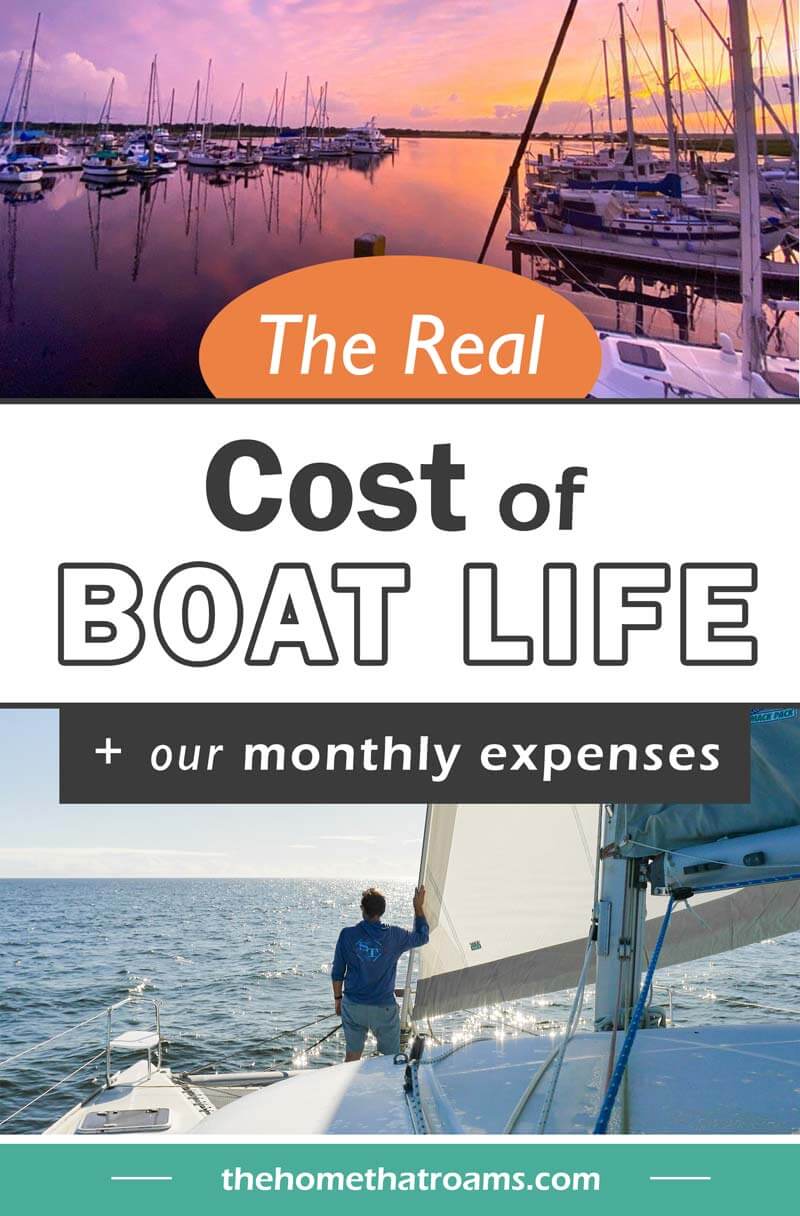
Or view our web stories.
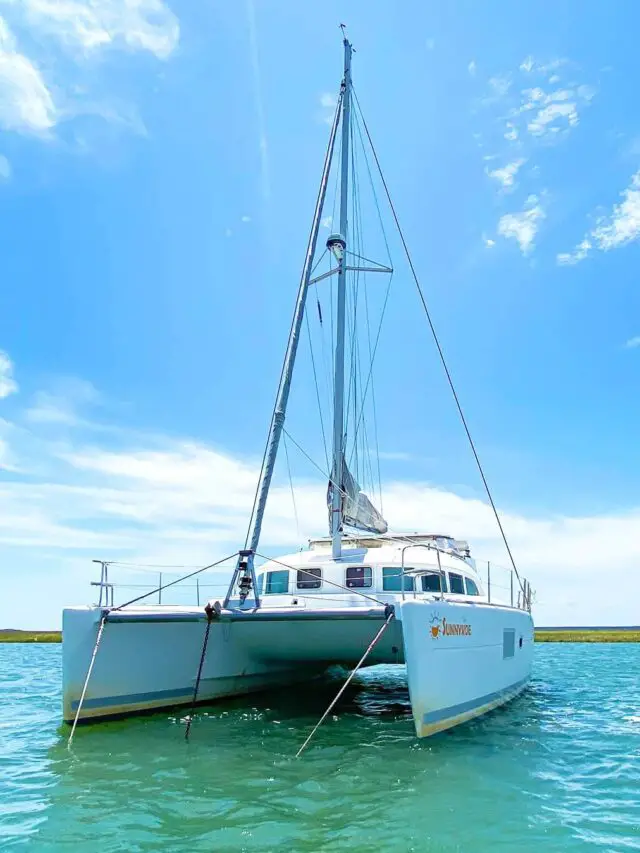
Morgan, the founder of The Home That Roams, has been living nomadically for over five years. She began her journey traveling across the U.S. in a motorhome and cruising on a liveaboard sailing catamaran. Currently, she lives full-time in a travel trailer, sharing resources on RV living and boat life to help others downsize their lives and thrive in an alternative lifestyle.
Excellent article. Thank you!
I started getting the urge to return to the sea not long after I got out of the Navy in 1974…. Started out on a 15′ Phantom…. Up to 21′ Keels, up to a 26′ Bristol and finally a 28′ Newport…. You learn alot of tricks of the trade at a working marina… Barter system, I used to go up the mast or anything Aloft in return for favors with anything that I had a problem with …. Had to give up the sailboat when I couldn’t sail it by myself anymore … Looking for a 35′-38′ trawler to live in the Tampa Bay area for the rest of my day…. From the Sea I came, back to sea I will return … Anchor’s Aweigh….
Hi George, it sounds like you have lived and breathed boats for a while! One of my favorite things about a good liveaboard marina is how everyone trades boat maintenance favors and helps each other out. I sure hope you find a good trawler to liveaboard in Tampa – sounds lovely!
Do you use a specific budgeting software or anything to track your transactions? Please share if so
Leave a Reply Cancel reply
Your email address will not be published. Required fields are marked *
Sign Me Up!
Learn how to live on a boat.
Get weekly tips on how to start traveling full-time on a boat.
View our privacy policy .
Privacy Overview

Cost of Living On A Sailboat (Monthly Breakdown)
The cost of living on a sailboat full-time is approximately $1,880 per month or $22,560 per year.
Please keep in mind that the cost of living on a sailboat can vary depending on your specific location, the condition of the vessel, the size of the boat and your boating experience.
The cost of living on a sailboat can be broken down into 9 monthly expenses including:
- Boat Marina Fees
- Boat Insurance Cost
- Boat Maintenance Fees
- Fuel Expenses
- Grocery Costs
- Boat Gear Costs
- Entertainment Costs
- Internet Costs
- Miscellaneous Costs
Below is a cost of living on a sailboat table summary.
1. Boat Marina Fees
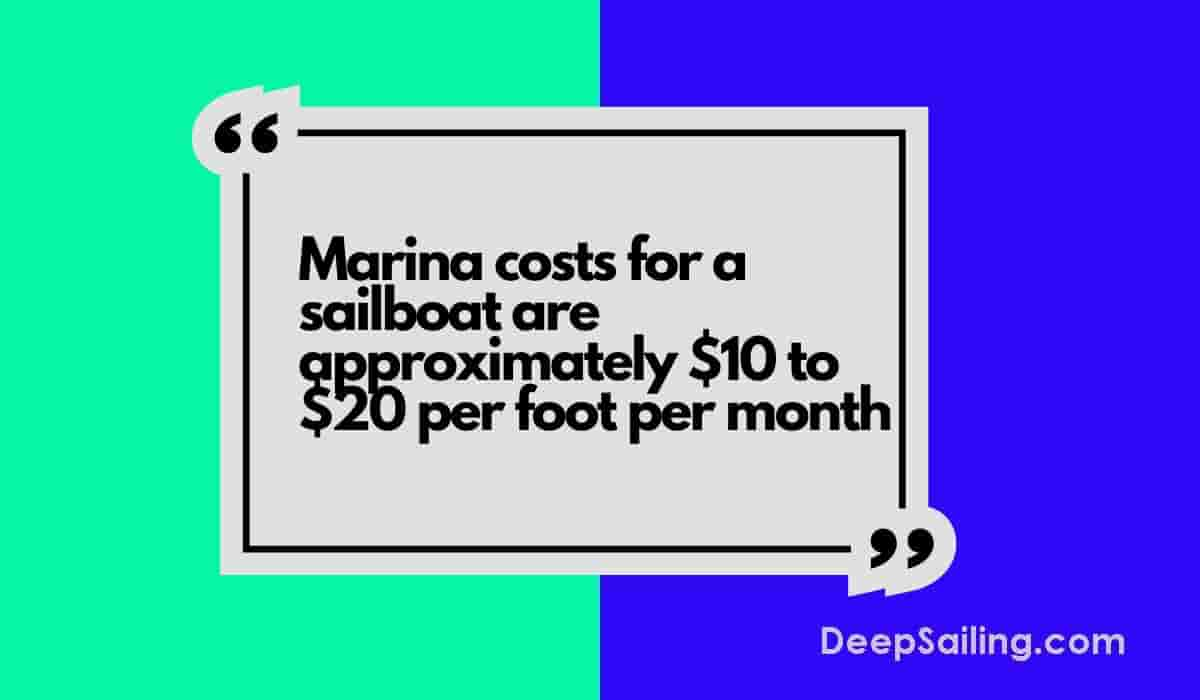
The first cost to consider when living on a sailboat is the marina fees/slip fees.
The marina costs for a sailboat are approximately $10 to $20 per foot per month.
For example, a sailboat owner with a boat size of 30 feet will typically pay between $300 and $600 per month in slip fees to stay at a marina.
A marina will charge a boat owner on a per-foot basis based on the length of the vessel.
The size of the boat and the location of the marina will have a large influence on the price charged to boat owners with marinas in Florida typically being the most expensive in America compared to other locations.
Paying marina fees gives boat owners access to boat cleaning services, electricity, internet access, pump-out services and facilities, waste removal services and a marine store.
Some boat owners prefer anchoring which is free of charge. Anchoring can be the best option during warmer months from April until November when marina facilities are needed less.
Boat marina costs can be reduced by mooring in cheaper marina locations, only using the marina when necessary or anchoring the boat off the coast away from the marina.
2. Boat Insurance Cost
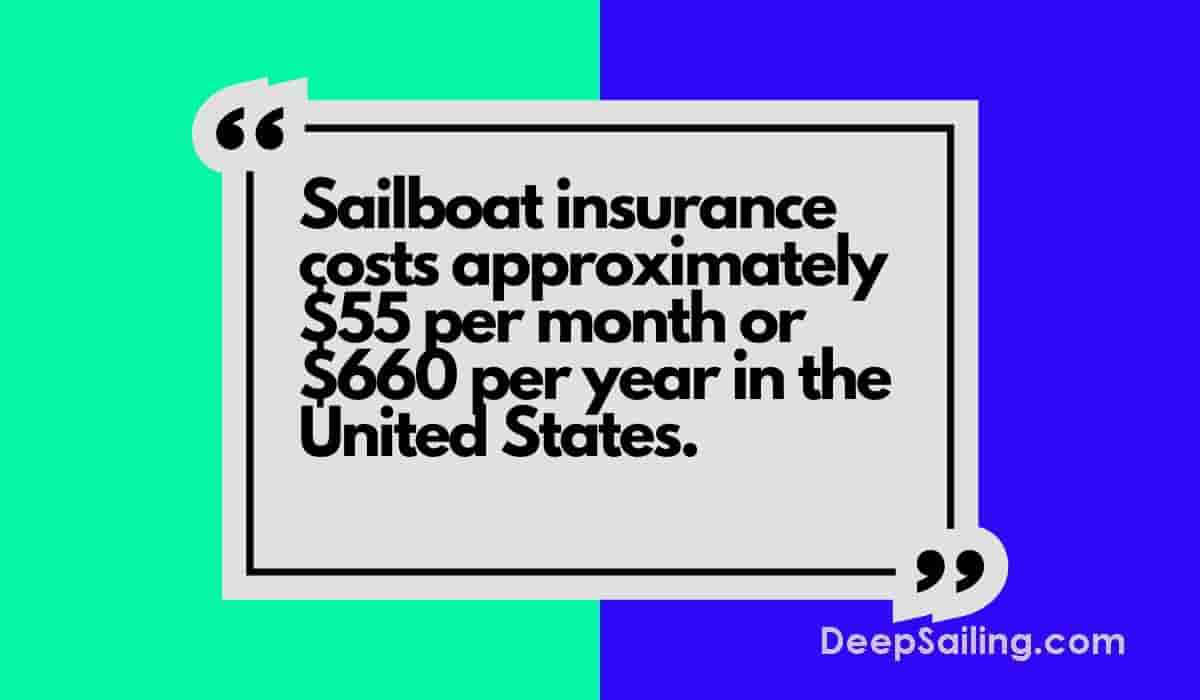
The second cost to consider when living on a sailboat is the boat insurance fee.
The cost of sailboat insurance is approximately $55 per month or $660 per year.
This is an approximate cost for the average sailboat owner living onboard their vessel in America.
According to Progressive , the annual Progressive boat insurance policy cost for the insurance policies they issued to boat owners in America ranged from $250 to $700 per year.
To get an accurate boat insurance cost for your specific sailboat, contact marine insurance providers for quotes.
The cost of boat insurance will vary based on the size, location and condition of the sailboat as well as a boat owner's experience and claims history.
Typically, the boat insurance cost will be 1% to 4% of the total retail value of your sailboat.
Boat insurance is the most expensive in locations that suffer from hurricanes like Florida and Texas.
Boat insurance costs can be reduced by browsing insurance providers, using cheaper sailboats, using the boat in lower-risk areas and increasing your boat experience.
3. Boat Maintenance Costs
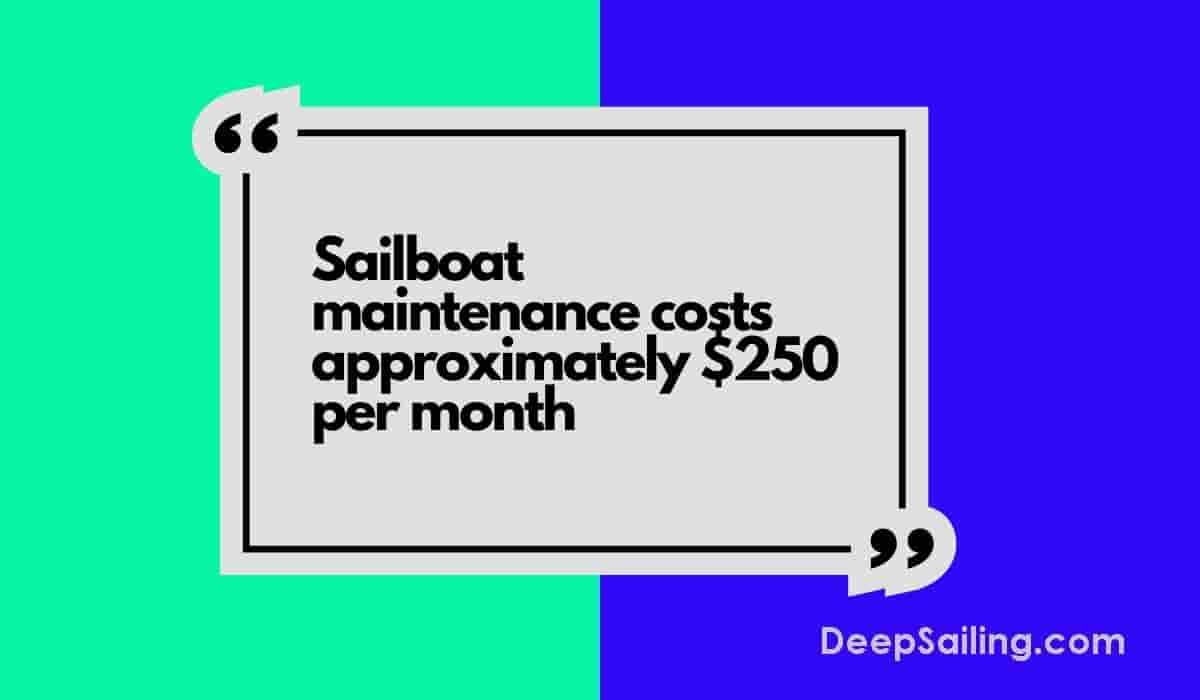
The third cost to consider when living on a sailboat is the maintenance cost.
The average cost of sailboat maintenance is $250 per month or $3,000 per year.
A sailboat's maintenance cost can vary based on the condition, size, age and location of the sailboat as well as the boat owner's experience with repairing and maintaining the boat.
Boat maintenance cost includes paying for spare parts, cleaning supplies, boat paint, engine services, repairing fridges, electronics, lines, cookers, windows, seats, toilets, deck materials etc.
Boat maintenance costs can be reduced by using second-hand parts, manually repairing the sailboat yourself and treating the boat with care.
4. Fuel Expenses
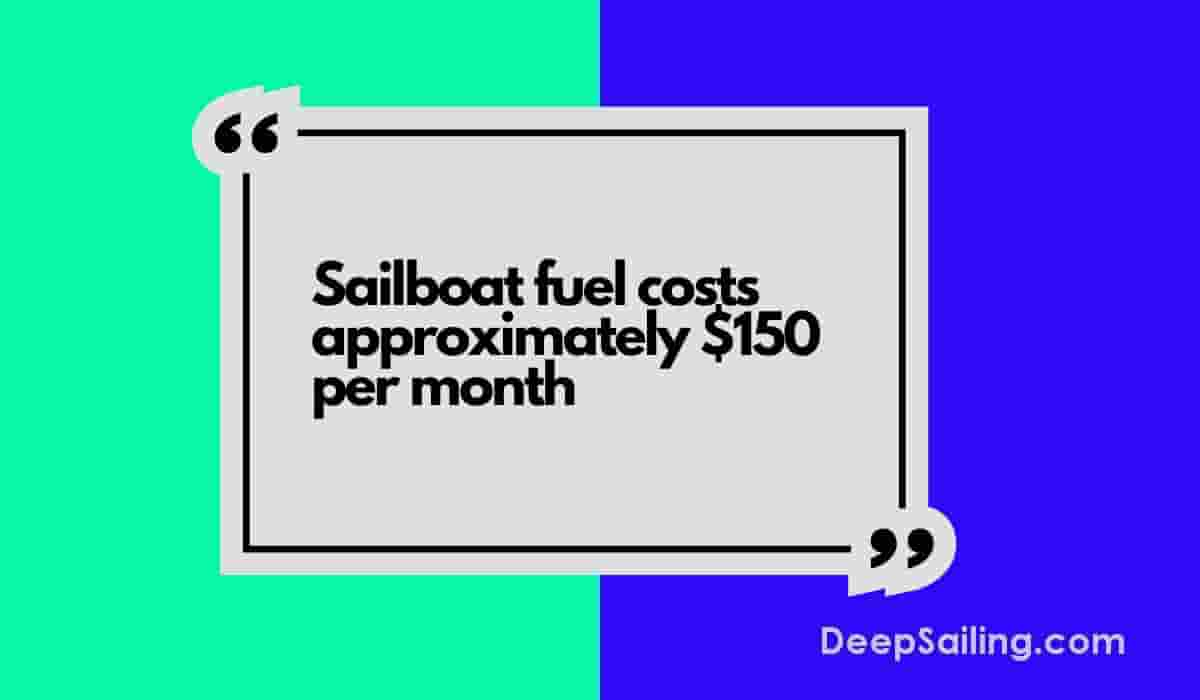
The fourth cost to consider when living on a sailboat is the fuel cost.
Sailboat fuel costs approximately $150 per month or $1,800 per year.
Sailboat fuel costs include paying for diesel or gas for the boat engine and buying propane fuel for sailboat heating and cooking while living onboard.
The factors that affect the sailboat fuel costs are the location, weather, size and condition of the boat as well as the frequency of use.
In the winter, sailboat fuel costs tend to rise whereas they are cheaper in the months from April until September.
To reduce the fuel costs of a sailboat, use the sails more often rather than the boat motor. Sailboat fuel costs can also be reduced by only traveling when it is the optimal time for the current which can make a large difference in fuel efficiency.
5. Grocery Costs
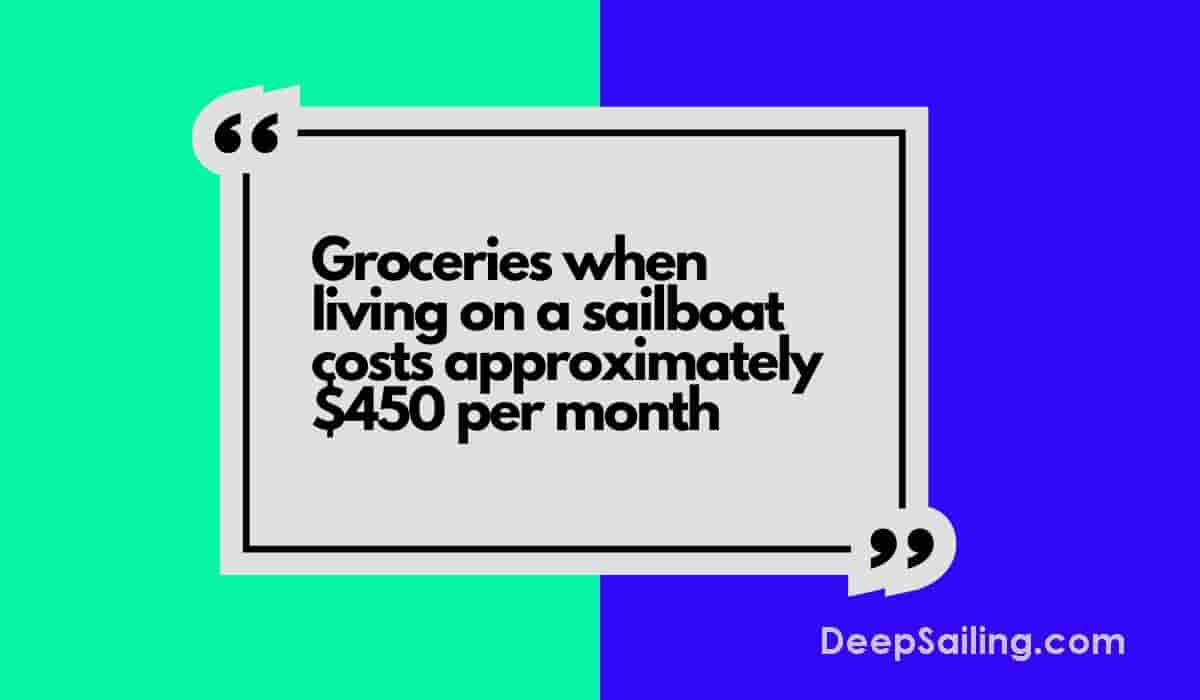
The fifth cost to consider when living on a sailboat is the groceries cost.
The cost of groceries when living on a sailboat is approximately $450 per month or $5,400 per year.
Grocery costs include paying for food, drinks, bathing supplies and kitchen cleaning supplies.
The grocery costs remain the same year-round. To reduce the grocery costs when living onboard a sailboat, boat owners can choose to catch fish by fishing from their boat. However, this will only cause a small reduction.
A saltwater-to-freshwater converter can be used to get a fresh supply of drinkable water without having to spend money on buying drinks. This will only cause a small reduction in costs too.
6. Boating Gear Costs
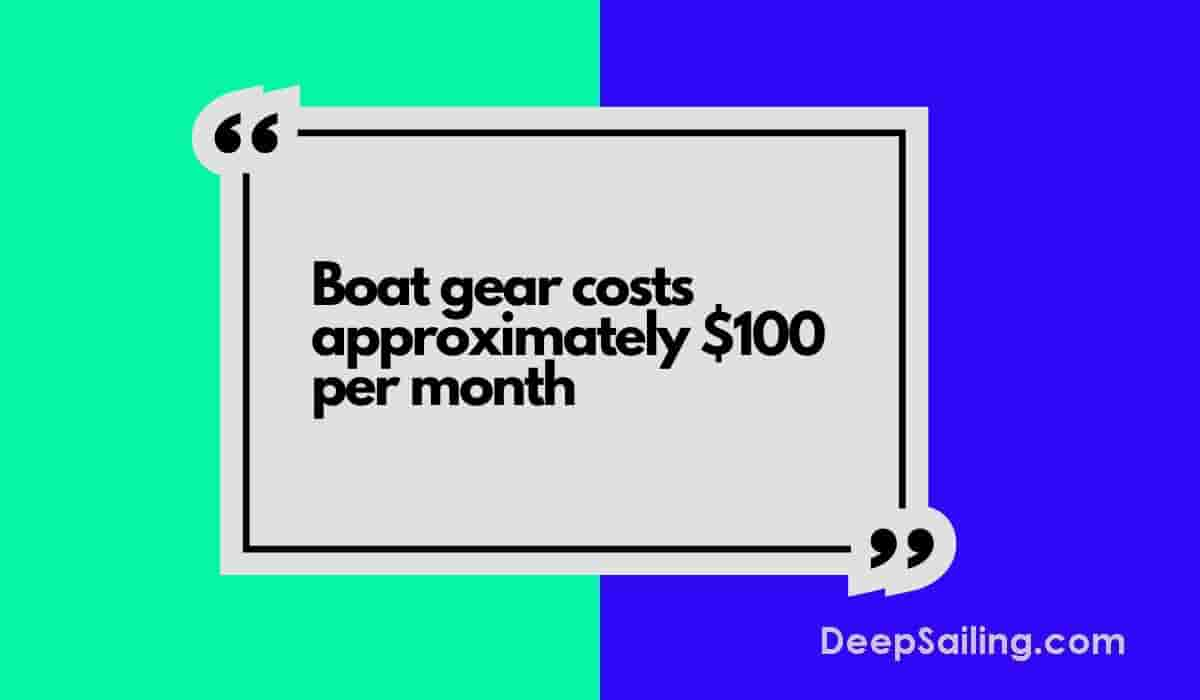
The sixth cost to consider when living onboard a sailboat is boating gear costs.
The approximate cost of boating gear when living on a sailboat is $100 per month or $1,200 per year.
Boating gear costs include paying for gear like sailing sunglasses, sailing jackets, swim gear, fishing gear, sunscreen, wetsuits, sailing hats, fire blankets, and general boating accessories.
The boating gear cost is the most expensive in the winter months when extra sailing clothing is needed to keep warm.
To reduce the cost of boating gear, take good care of your current boat gear to ensure it lasts longer and purchase high-quality boating accessories that will last for a long time.
7. Entertainment Cost
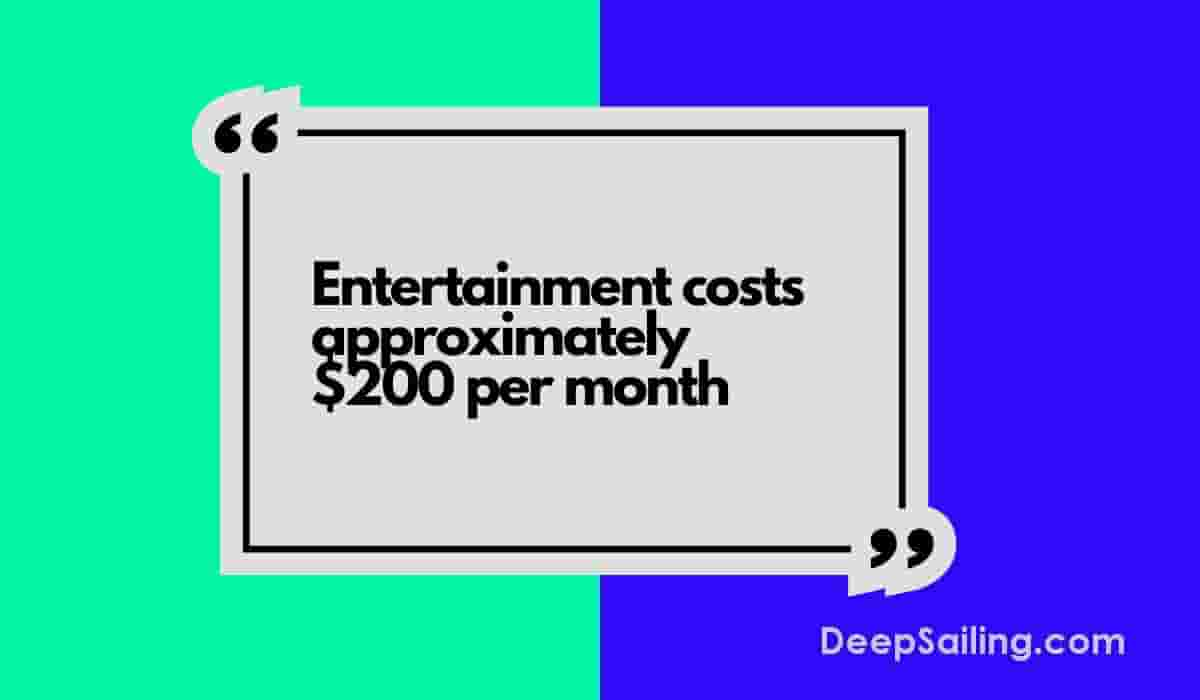
The seventh cost to consider when living onboard a sailboat is the entertainment cost.
The cost of entertainment when living on a sailboat is approximately $200 per month or $2,400 per year.
Entertainment costs include paying for tv subscriptions, board games, dining out, trips to the cinema, etc.
The entertainment costs will not change throughout the year.
To reduce entertainment costs, find free entertaining activities to do rather than spend money for entertainment.
8. Internet Costs
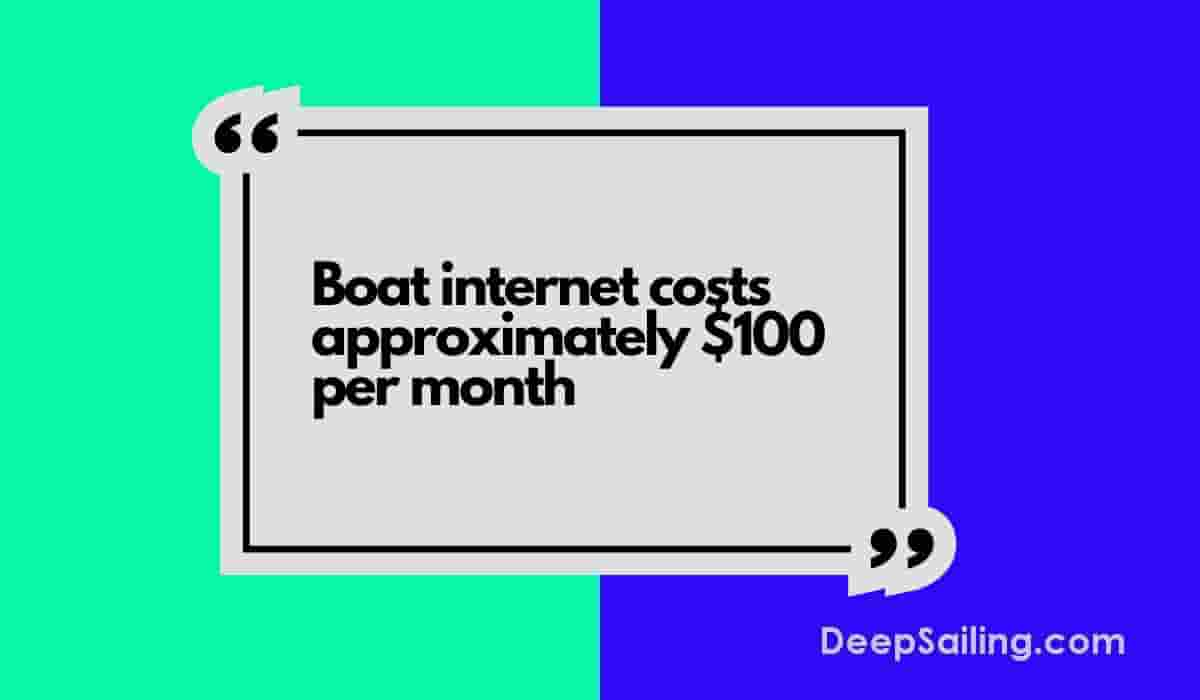
The eighth cost to consider when living on a sailboat is internet costs.
The cost of the internet when living on a sailboat is approximately $100 per month or $1,200 per year.
Internet costs include paying for a 4G/5G connection or satellite internet connection. It includes paying for a wi-fi router to connect to the sailboat too.
To reduce the internet cost on a sailboat, anchor the boat at marinas with a Wi-Fi connection included in the slip fees.
9. Miscellaneous Costs
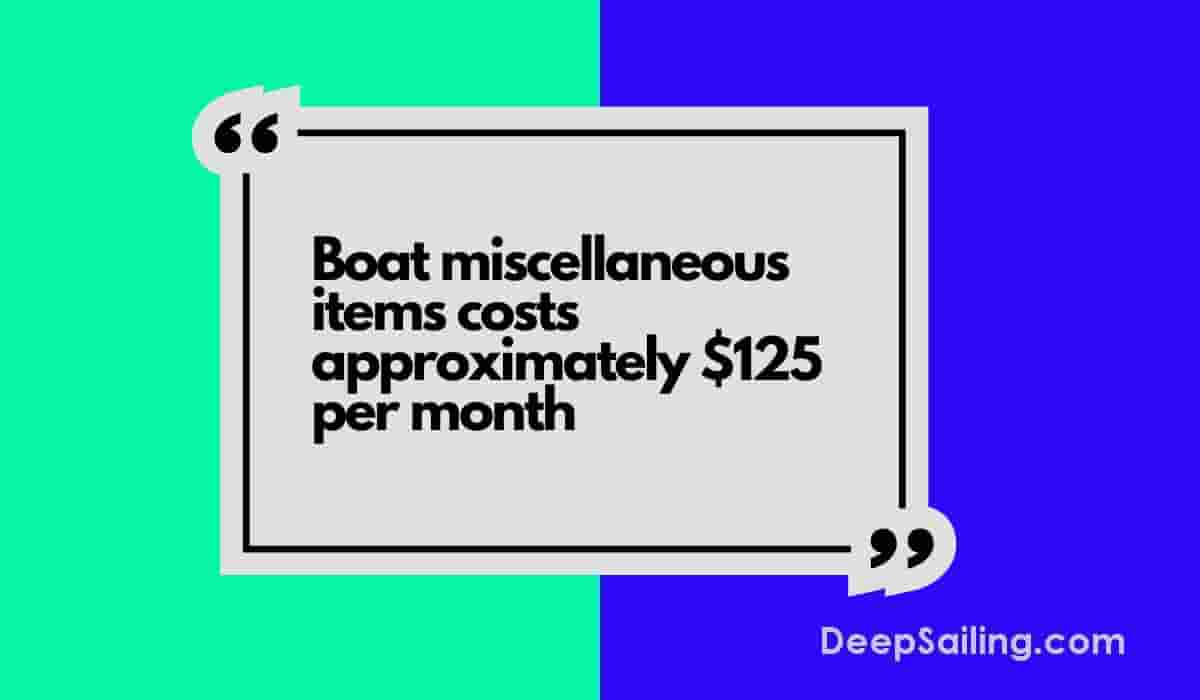
The ninth cost to consider when living on a sailboat is the miscellaneous costs.
The miscellaneous costs when living on a sailboat are approximately $125 per month or $1,500 per year.
Miscellaneous costs will typically remain the same throughout the year without much change.
Miscellaneous costs include costs associated with buying items like boat rugs, personal care items, boat care basics, coolers, boating decor, cooking utensils etc.
To reduce the miscellaneous costs, reduce the number of general boating items purchased and ensure the items that are purchased are of good quality so they last longer.
Frequently Asked Questions About The Cost Of Living On A Sailboat
Below are the most commonly asked questions about the cost of living on a sailboat.
How Much Does A Large Sailboat (Over 50ft) Cost To Live On?
The approximate cost to live on a large sailboat (over 50ft.) full-time is $3,200 per month or $38,400 per year.
What Is The Most Expensive Cost Associated With Living On A Sailboat?
The most expensive cost associated with living on a sailboat is the marina slip fees which are a monthly cost of $10 to $20 per foot of boat size.
How Can The Cost Of Living On A Sailboat Be Reduced?
The cost of living on a sailboat can be reduced by using the sails instead of boat fuel to power the boat when traveling, mooring the sailing vessel in a cheaper marina or anchoring outside a marina, browsing for cheaper marine insurance policies, ensuring care when using the vessel to keep repair costs low, downsizing to a smaller sailboat and keeping entertainment costs to a minimum by finding cheaper or free entertainment alternatives.
Life on a Sailboat: Everything You Need to Know About Living on a Sailboat Full-Time
Living on a sailboat full-time is often romanticized as a life of endless sunsets, gentle waves, and freedom on the open sea. Many dream of casting off the lines and setting sail for a horizon of adventure and tranquility. However, the reality of life aboard a sailboat can be as challenging as it is rewarding, as frustrating as it is relaxing, and, more often than not, as mundane as it is exciting.
This blog post aims to peel back the curtain on the picturesque scenes to reveal what daily life is really like when you call a sailboat home. We will dive into the motivations, preparations, joys, and challenges of living on a sailboat full-time, providing a realistic glimpse into a lifestyle that is far from ordinary.
Our Live-Aboard Life
Our dream of living on a sailboat was a distant one for many years. But as we watched plans and dreams fall by the wayside in the wake of COVID, we made the decision to make our dream a reality. Once the borders opened up, we made a beeline for the Mediterranean and have since spent each summer living aboard our little 29-foot sailboat Whisper. Without any experience sailing or living on a sailboat, we have taught ourselves to sail and manage life on the boat along the way.
Before we took up Sail Life, we had been living “van life,” and we’ve come to realize there are lots of similarities but quite a few differences between the two . However, on the whole, learning to live van life first put us in good stead to take on life on a sailboat. Unlike most people, we upsized when we moved onto a boat.
Despite the upgrade in living quarters, the learning curve and the adjustment to living on the sea were no less challenging. Nevertheless, the shift was not as scary as we thought it might be, and the reality of living on a sailboat full-time quickly became our new normal.
Initially, our plan was to buy a boat and spend one season aboard sailing the Mediterranean before selling the boat and settling down. Instead, it’s safe to say we have fallen in love with life on a sailboat. Now, as we enter our third season, we aren’t sure when we will be ready to furl the sails for good…
Get a Taste of Life on a SailBoat
We document some of the realities of living on a sailboat full-time on our YouTube Channel in our The Vanabond Sails series
Deciding to Live on a Sailboat
The journey to becoming a full-time live-aboard often starts with the desire for change.
Some people are transitioning from one stage of life to the next as careers wind up or children move out. Some yearn for adventure and excitement, while others seek a simpler way of life. Many are drawn to the promise of freedom, the allure of the sea, and the appeal of living more closely with nature. However, the decision to live on a sailboat full-time is not one to be taken lightly. It requires thoughtful consideration and planning.
For us, it was a long-held dream to sail and live aboard a sailboat. It was also a natural progression, having spent several years living and traveling by van. We were ready for a new challenge.
It began with a conversation, then a plan, and then trawling classifieds for second-hand boat sales. Before long, the decision was set in stone, and we were on our way to Croatia to buy a boat, learn to sail it, and move aboard.
Choosing the Right Sailboat
The type of sailboat you choose is critical and depends on your budget, sailing skills, and the kind of sailing you plan to do (coastal cruising, bluewater voyaging, etc.).
Will you prefer the size and stability of a catamaran, or will you prioritize the sailing experience of a monohull? Are you looking for something small that’s easily controlled and maneuvered by limited (and potentially inexperienced) crew, or do you require the space of a larger vessel? Are you interested in the clean lines and comforts of modern boat designs, or do you prefer the style of older boats? There are a thousand decisions to be made when choosing a boat, and your own aspirations for boat life and, of course, your budget will be critical when it comes to making this decision.
Spend as much time researching boats that are available in your price range, ask questions of sailors you know or on sailing forums, and, if possible, spend time aboard different types of sailboats to get a clearer picture of what life is really like on board before making a purchase.
Check out our full article on buying boat
Emotional and Practical Considerations for Sail Life
Living on a sailboat means embracing minimalism and being comfortable with the idea of having less space and possessions.
You’ll need to consider the impact of such a lifestyle on relationships with family and friends, as it can mean spending long periods away from loved ones.
The decision also involves considering how to manage work or income while living at sea, which might include remote work, seasonal jobs, or living off savings.
There are plenty of options for those planning on working remotely while sailing. With the rise of remote work, there has never been more opportunity to work and sail.
All of these considerations represent potential challenges to adjusting to life at sea, but they are certainly not insurmountable. You just need to be honest with yourself and decide if your love of the open water and the freedom of living aboard a sailboat will be greater than the inconveniences.
Preparations and Adjustments
Transitioning to life on a sailboat involves a series of preparations and adjustments, both practical and psychological, to ensure a smooth and sustainable living experience.
Training and Skills
If you are thinking about taking up the sailing life, you should, of course, invest time in learning to sail, navigate, and understand weather patterns. While this may seem like a daunting task it’s not an insurmountable one. Time on the water is the most important thing so its time to sign up for sailing courses, start planning trips with sailng friends, joining a local sailng club or seeking out opportunites to crew for other sailors.
Learning basic boat maintenance and repair is essential to manage the myriad challenges that come with life at sea.
Safety courses, such as first aid, sea survival, and radio operation, are also crucial for handling emergencies.
These skills are not only important for safe and comfortable sailing but are often legally required. Make sure you are aware of the legal requirements for sailors in the region you are preparing to sail in terms of licensing and registration.
In our case, I had experience sailing small dinghies as a child and thus some understanding of the fundamentals, while Kelli had zero experience. My existing marine license issued in Australia was recognized in Croatia, where we bought our boat. I only needed to acquire a VHF radio license to become adequately certified for inshore sailing in the Mediterranean.
We paid some local sailors to come aboard and teach us both the fundamentals of our new boat (lots of docking and anchoring practice).
Downsizing and Adapting to Limited Space and Resources
As mentioned, moving onto a boat was actually upsizing for us. With a second cabin, a flushing toilet, and a large indoor table, our relatively small 29-foot monohull seemed luxurious compared to the vans we had been living in until this point.
However, for most, moving onto a sailboat often means significant downsizing, and space becomes a premium commodity. The process of downsizing for sail life involves prioritizing essential items and learning to live without the comforts of a traditional home.
Space isn’t the only limitation on a boat. Reliance on water tanks (if you don’t have a watermaker) and solar, wind, or generator electricity often means a downshift in access to creature comforts we take for granted in a house on the grid.
Creativity in organizing and making the most of limited space and resources becomes a daily practice, requiring innovative storage solutions and multi-functional furniture. Most modern sailboats are well-designed with never space-saving measures and designs. Nevertheless, an adjustment will likely be necessary.
Financial Planning
Financial considerations are paramount, as the cost of living on a sailboat can vary widely depending on factors like marina fees, maintenance costs, and lifestyle choices.
Setting a realistic budget that includes regular maintenance, unexpected repairs, and living expenses is essential for sustaining life at sea.
Depending on your personal aspirations for boat life, this lifestyle can be as affordable or as expensive as you want to be. For us, as a couple in our thirties still in the building and saving part of our lives and careers, we are able to live on a boat in the Mediterranean affordably and comfortably for far less than we (estimate) we would spend living a more stationary lifestyle.
Check out our full article on the Costs of Living on Sail Boat Full-Time
Overall, adjusting to the confines and challenges of sailboat living demands not only physical preparation but also mental resilience and adaptability. The transition from land to sea is a profound shift, requiring a willingness to embrace simplicity, flexibility, and a sense of adventure.
Daily Life Aboard
While there is no typical day aboard, and experiences will differ wildly from person to person and day to day, we can describe what many of our days do look like.
As we work from the boat, our weeks are generally divided into work days, Monday to Friday Morning and weekends. The truth is that the novelty does wear off, and many days, especially during the working week, become just as mundane as any other lifestyle. However it never stays mundane for long, one exhilarating sail, a dolphin sighting, a picture perfect anchorage or even surviving an impromptu weather event and the thrill of living on a sailboat quickly returns.
A typical workday for us living on a sailboat often starts with the sunrise (or a little bit before if we have a lot on). Ideally, we are well rested after a still night without rolling swell or, worse, strong wind, but that isn’t always assured at sea. Mornings involve checking the weather first and foremost, all plans revolve around the direction and strength of the wind and waves.
If the weather is calm we usually try to work in the mornings when we are fresh and focused.
We travel slowly, often spending a few days in a quiet well, well-protected anchorage, on a town quay, or in a marina before moving on a short distance along the coast. On sailing days, we often sail in the afternoon when the winds are a bit stronger in the Mediterranean. On days we are staying put, the afternoon might be spent exploring a new town, getting provisions, swimming, or finding a beach to lie on and read a book. In the evening, we will cook dinner onboard and get some more work done or watch some TV.
Weekends look different, and we will take advantage of not needing to be close to reliable network services, completing longer passages along the coast, or visiting islands.
Daily Differences in Sail Life
Living spaces on a sailboat are compact and multifunctional, necessitating an organized and tidy approach to prevent clutter and ensure safety. Cooking in a small galley kitchen presents its challenges, from securing pots and pans on a constantly moving boat to managing limited ingredients and storage.
Meals often need to be simple yet nutritious, requiring creativity and planning. Our approach is to cook simple, one-pot, vegetarian meals like Dahl or vegetable curry two or three times during the work week and eat leftovers for lunch and dinner. On the weekend, we like to get more creative with our meals, seeking out local produce or fresh seafood and taking our time to prepare something special.
As mentioned, resource management is a critical aspect of daily sailboat life, especially when it comes to conserving water, fuel, and electricity. Efficient use of these resources is vital, whether it involves careful water usage, monitoring power consumption, or planning the next opportunity to resupply. For us, an electricity supply is mainly dependent on the sun when we are not under motor or plugged into shore power. Extended periods of cloud can alter our plans. Similarly, if we are not careful with water, more frequent visits to refill are required, which can be limiting.
Personal hygiene and privacy take on a new meaning in the confined space of a sailboat. Showers may be quick and infrequent, in our case we generally rinse off after a swim to bathe, and take proper showers during marina stops. Personal space is limited on a sailboat and managing personal relationships can have extra challenges.
Sleeping on the boat can take some getting used to, especially when on anchor. Even on a calm day, the constant rocking of the water can be disruptive at first, and novice sailors may find they get seasick, although these symptoms usually go away after a few days. When it’s windy or there is some swell, the noise, movement, and the ever-present worry that the boat may pull off its anchor with the movement can make it very difficult to get a good night’s sleep.
Unforecast storms, gear failure, or some other emergency can occasionally create scary and challenging scenarios, especially if disaster strikes late at night. These situations are part of the adventure but can certainly be stressful.
Despite the challenges, daily life on a sailboat is interspersed with moments of profound beauty and peace. Whether watching dolphins play in the bow wave, enjoying a sunset over the ocean, or stargazing on a clear night, these experiences often make the hardships worthwhile, offering a sense of freedom and connection to nature that is hard to find elsewhere.
The Pros and Cons of Living on a Sailboat Full-Time
+ pros: the joys of sailboat living.
Living on a sailboat brings a unique set of joys and rewards that can make the challenges seem insignificant.
+ One of the most significant benefits is the sense of freedom and adventure. Sailboat dwellers have the luxury of exploring new destinations, anchoring in secluded bays, and experiencing different cultures in a way that most people never will. The ability to call a variety of picturesque locations home, even if only temporarily, is a remarkable aspect of this lifestyle. Even compared to other forms of nomadic lifestyle, waking up in your own private bay or cove is hard to re-create.
+ The connection with nature is unparalleled in sailboat living. Being surrounded by the vastness of the ocean, witnessing marine life up close, and experiencing the rhythms of the sea create a deep sense of harmony and peace. The simplicity of life on a boat can lead to a greater appreciation for the small things, like the beauty of a sunset, the changing colors of the sea, or the silence of a night watch under the stars.
+ Community and camaraderie are also central to the sailboat lifestyle. The sailing community is known for its close-knit, supportive nature, with fellow sailors often ready to lend a hand, share advice, or offer companionship. This sense of community extends across harbors and anchorages around the world, creating a global network of friends and contacts.
+ The personal growth and self-reliance developed through sailboat living are profound. Navigating the challenges and unpredictability of the sea fosters resilience, problem-solving skills, and a strong sense of self-confidence. The lifestyle encourages continuous learning, from mastering sailing and navigational skills to understanding weather patterns and marine ecosystems.
The Cons: The Challenges and Hardships of Liveaboard Life
While the joys of living on a sailboat are plentiful, the lifestyle also comes with its fair share of challenges and hardships. These difficulties test the resilience and adaptability of those who choose this way of life.
– One of the most significant challenges is dealing with bad weather. Storms, high winds, and rough seas can be terrifying and dangerous, requiring skill, experience (which you can only get by …experiencing it), and a calm demeanor to navigate safely (perhaps the trickiest thing to achieve). The stress from poor weather can be mentally draining, disrupt work and put a strain on relationships.
– The learning curve required to become a confident and comfortable sailor is not small and can take many seasons, while mastering sailing can take a lifetime.
– The constant exposure to the elements also means that maintenance is a never-ending task, with saltwater and sun, causing wear and tear that must be regularly addressed to keep the boat functional and safe. Especially on an older boat like ours, fixing and maintaining gear and rigging is an endless cycle. Most systems and hardware on the boat are essential, and when it fails, often there is often no one around to help. Constantly sorting out jammed anchors, engine or electrical issues can quickly become tiresome and (if you are trying to work) quite disruptive. It can also be quite stressful when critical systems fail.
– Isolation is another aspect of sailboat living that can be challenging. Long periods at sea or anchored in remote locations can lead to feelings of loneliness and disconnection from land-based communities. The confined space of a sailboat can strain relationships, making it essential for the crew, be it a couple, a family, or friends, to communicate effectively and give each other personal space.
– The financial aspect of sailboat living can also be a hardship. Unexpected repairs and maintenance can quickly drain savings, and the cost of mooring, fuel, and supplies can add up. Sailors must be adept at budgeting and often need to be resourceful in finding ways to sustain their lifestyle, which might include picking up temporary jobs or remote work.
– The physical demands of managing a sailboat should not be underestimated. It requires strength, stamina, and a willingness to tackle everything from sail repairs to engine troubleshooting. The learning curve can be steep, and the responsibility of keeping the boat and its occupants safe is a constant pressure.
Despite these challenges, many sailboat dwellers find that the hardships are part of what makes the lifestyle rewarding. Overcoming difficulties and learning to live in harmony with the sea can provide a profound sense of achievement and satisfaction.
Final Thoughts About Life on a Sailboat
Living on a sailboat full-time is a journey that encompasses the full spectrum of human experience, blending moments of sheer joy and beauty with times of challenge and adversity. It’s a lifestyle that demands resilience, adaptability, and a willingness to embrace the unknown. While the romantic allure of sailing the high seas is undeniable, the realities of daily life on a sailboat are grounded in practical challenges and the necessity of continual learning and personal growth.
The decision to live on a sailboat should not be made lightly, as it involves significant changes in lifestyle, mindset, and social dynamics. However, for those who choose to embark on this adventure, it offers unparalleled opportunities for freedom, exploration, and connection with nature. The hardships encountered along the way are not just obstacles but also catalysts for growth, leading to a deeper understanding of oneself and the world.
If you have a question about living on a sailboat full-time, let us know in the comments below or shoot us an email anytime!
Fair winds and following seas!
In 2016, I had been dumped by my girlfriend, fired from my job, and the lease on my house was running out. Facing moving back in with my parents, 26, jobless and alone I decided to listen to the message the universe was trying to send me. I took off on my first solo backpacking trip, with a one-way ticket to Bangkok and a well-thumbed Lonely Planet guide. From there I wandered Southeast and Central Asia, traveled the Great Steppe, and made my way across Russia and throughout Europe.
In Estonia I met Kelli, who, despite having a less frantic travel style, shared my my restless spirit and passion for exploration. Together, we embarked on a new journey, van life. Over four years we travelled across three different continents with three different vans.
In 2022, as the world began to re-open post COVID we took an opportunity to realise a long held dream, to live aboard a sailboat. Since then we have spent two summers in the Mediterranean, sailing and living aboard our little sail boat Whisper. When we aren't sailing we continue to live our nomadic lifestyle, guided by a philosophy of slow travel and self directed adventure be it by van or backpacking.
We find excitement through our journey into the unknown, stillness and content in the beauty of the places we discover and we find ourselves in the vastness of our world.
Hopefully, we can help you find what you're looking for too. Get lost with us and find your own path.
Leave a Reply Cancel reply
Your email address will not be published. Required fields are marked *

My Cruiser Life Magazine
Living On a Boat Full Time — What to Consider Before Living Aboard
Let’s talk about real-life boat ownership and living on a boat full time. My wife and I have lived on our boat for nearly eight years, doing everything from full-time living on a boat in a marina to cruising The Islands of The Bahamas for months.
For starters, everything you’ve ever wondered about living on a boat probably doesn’t scratch the surface of everything you’ll learn. This lifestyle isn’t for everyone; for every wonderful day on the water, there’s a stressful situation or broken boat part.
So what does living on a boat full time look like? Here’s a glimpse into the world of the liveaboard.

Table of Contents
Should i live on a boat absolutely yes, here’s why (pros of living on a boat), never, in a million years, should anyone ever live on a boat (cons of living on a boat), there’s more than one way to live on a boat, there’s a steep learning curve, it’s kind of like camping, constant maintenance and cleaning, weather drama, the legalities of the live aboard life, cost of living on a boat, paths to moving aboard, living on a boat full time faqs, what are the pros and cons of living on a boat.
It is often said that there’s a wide gap between the romantic vision that many people have of the liveaboard lifestyle and the nitty-gritty reality.
Here are the pros and cons of living on a boat full time, taken from our personal experiences.
Living on a boat is sometimes even better than your most romantic vision. Dolphins frolicking while the sunsets, tropical drinks in your hands, and nothing but crystal clear water between you and the most spectacular island beach you’ve ever seen. Yes, that all happens, sometimes.
- Freedom to go where you want, when you want
- Travel as much or as little as you want
- Take your house with you as you move
- Changing scenery, waterfront property where ever you go
- Wildlife visits—seals, whales, dolphins, birds
- A friendly community of other boaters
- Learn to live more simply, with only the necessities
Everyone has good days and bad days. We’ve often described boat life as having high highs but very low lows. The peaks and valleys of boat life (crests and troughs?) are just much farther from baseline-normal.
For every dolphin, there is a broken toilet joker valve leaking sewage onto the bathroom floor.
For every idyllic island beach, there is a fouled diesel filter that needs changing.
For every smooth downwind passage, there is a sloshy, windless mess of flapping sails making everyone on board seasick.
The list could go on and on and on.
- Constant maintenance and cleaning
- Difficulty finding skilled, professional labor
- Small spaces, no storage, no privacy
- No dishwashers, washing machines, dryers (usually)
- Away from docks, you always have limited power and water
- Constant exposure to the weather
- Tax and insurance issues
Common Issues with Moving Onto a Boat
Here are some of the biggest issues we have noticed from our experiences and those around us. While everyone’s experience of living on a boat full time differs, everyone seems to have similar issues.
First, it has to be said that everyone’s experience is different. And that’s most obvious by looking at what sort of boat they choose and where they choose to live on it.
Many books have been written on the subject, and most like to divide boaters into three groups based on their budgets. There are the high-lifers who can afford to buy a new or newish boat that is large and comfortable. They can afford to live at a resort marina and likely hire professionals for most maintenance and cleaning tasks. They likely spend most of their time in marinas if they travel far.
Then there are the Goldilocks boaters—not too big, not too small—making up the “middle class” of boating. There’s a healthy mix of DIY projecting with some professional help on the big projects. They might liveaboard at a marina or travel full-time. They might live at docks, anchor, or a mix.
And then there are the budget boaters. Cheap boats are easy to come by if you’re willing to use DIY labor to fix them up. They are most likely to anchor out to minimize costs.
All these people live very different lives on their boats, but does it matter? The costs are astronomically different, but they could be visiting the same ports, seeing the same sights, and even sharing the same experiences.
What’s most amazing is how everyone perceives their liveaboard situation. I’ve been to dock parties where couples on 60′ catamarans complain that they have no personal space and must take a break from being on the boat together after a few months. Meanwhile, I know a family of five (plus two dogs) that live on a 40′ monohull with less than 1/3 the space of the catamaran. They have issues, but they’re pretty happy five years later.
(Speaking of catamarans, check out my recommendations for liveaboard catamaran options.)
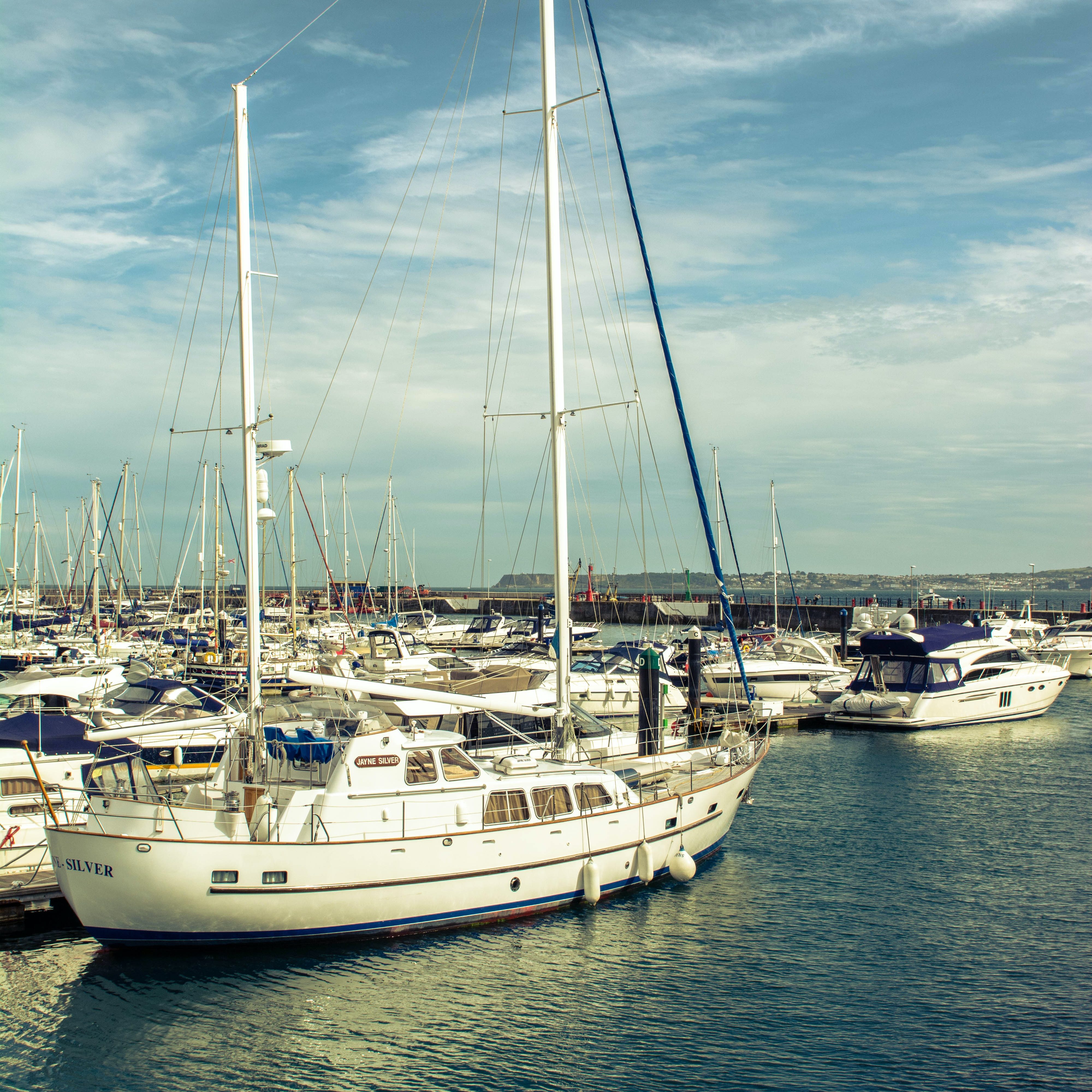
Year one of boating is the worst. There’s so much to learn; it’s all new and different than anything you’ve done before. There are all the sailing terms you must learn, but there are also boat maintenance tasks and understanding how all the systems on your boat work. Then there are the basics of seamanship and how to operate your vessel safely. It is a lot to take in.
And the basics of living on a boat are different from land life. Your kitchen (galley) is much smaller. The toilet doesn’t flush like a regular land toilet. You’re always thinking about minimizing water use when showering or doing dishes. If you turn too many electrical items on, circuit breakers pop. The list goes on and on, and when you’re new, it’s stressful.
Once you’ve got the kinks worked out, learned your boat systems, and successfully traveled and lived on your boat for a while, things get much better. You know more, your boat is set up the way you need it, and you have the confidence to start enjoying yourself. Some people take a few months, some a year, and, unfortunately, some never get there.
Boats are small spaces, but the truth is that living on a boat is more like camping than most boaters like to admit. You get by with only a few items in your wardrobe. You skip showers since you don’t always have hot water. You don’t have space for all the luxuries of home. No dishwasher. No washing machine. Everyone is occasionally uncomfortable onboard, whether from the weather or the cramped quarters.
Boats are also hard on relationships. While there’s something romantic about being cozy and alone together at sea, it isn’t so romantic on day five, or thirty, or sixty. Personal space is non-existent on most boats. It’s inevitable that your significant other—or anyone else—will drive you nuts after some time. Boats have ended more than one marriage that we know of.
The cramped living space on a boat poses other problems, too. Downsizing is important because you simply can’t bring it all with you—there’s no storage space. What is important, what’s nice to have, and what will you use on a boat? Living on a boat forces you to live with the minimum and acknowledge what you need to survive.
Living on a sailboat is, of course, drastically different than living on a luxury yacht. But all these problems seem relative, and no matter what size your boat is, everyone has the same complaints.
Boats are always trying to sink and fall apart. The ocean helps them with its corrosive saltwater and constant motion. The only thing keeping it afloat? You, the lowly and unprepared new boat owner. Yikes!
Even if you have mechanics and boatyard workers do most of the big projects for you, there’s still a ton that you’ll wind up doing on your own. Just day-to-day cleaning on a boat is a big deal. Everything is more difficult and takes longer than it does on a house.
Somehow, boats seem to get dirtier faster than houses do. From polishing the hull, shining the stainless, varnishing the teak, and scrubbing the scum line to everyday things like dishes, sweeping the floors, and cleaning the bathroom, boats are dirty, and it takes time to keep them clean.
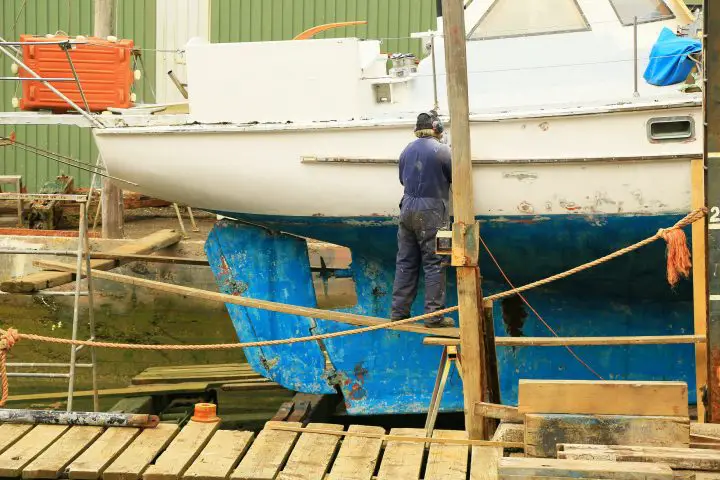
The weather plays a bigger part in your life than you’ll even imagine. Most of us pay remarkably little attention to the weather when we’re on land. If it’s hot, we might just minimize our time away from air conditioning. If it’s raining, it’s a minor inconvenience. We never think about the wind or tides.
But everything on a boat revolves around the weather. Every day we look at the weather for the upcoming week. Forecasts are often inaccurate, so we expect it to change. But what should we be ready for? When cruising, we often track weather systems over a week away and start planning.
This week, it says we might get gusts to 52 knots (!!!) from the southwest with heavy rain and thunderstorms. We’re anchored and away from the dock. Will our anchorage be protected from winds like that? Is the holding good here, or is there a safer place we should move to? Should we think about moving there early in case it fills up with boats?
We go through this exercise every week or two, no matter where we are. When approaching an anchorage, it’s all about the wind direction, tide level, and whatever else is happening. Are we okay with being stuck here for a few days if it’s foggy? A week? What if we need south winds to reach our next destination, but the forecast only has east winds? Do we wait or change our destination?
The amount of attention it takes and the flexibility of your schedule is mind-boggling to most landlubbers. When friends want to visit us, we tell them we can meet them in a specific place or at a specific time, but not both. If you want us to meet you, you’ve got to be flexible too!
What do you legally need to do to live on a boat full time? Most people’s home or apartment is their legal residence and domicile. It’s listed on their driver’s license, and it’s where they vote and pay taxes.
How will all these issues play out when you move onto a boat that moves around? There are mail forwarding services that allow you to set up residency. We use St. Brendan’s Isle in Florida since we were already Floridians, but there are also similar services in other states. This at least gives you the ability to have a driver’s license and vote.
Taxes are a little more complicated. You can register the boat at your address in Florida, but each US state collects its own use tax. If you use your boat in their state for over a few months, they want to tax it. It’s not a problem if you move around, but what if you want to leave your boat in New York for the summer? Then you might have to register it there and pay taxes.
Additionally, many counties in the US collect personal property tax on boats. We know of several places where if you are in the county on January 1 st , you’ll owe the county property tax. If you were one county away where the tax happens to be zero, you would owe nothing. Tricky!
Recreational boat insurance is another matter of concern. It used to be fairly easy to insure a boat, especially a cheap old boat. If you have a homeowner’s policy, you can easily add the boat. But if you’re a liveaboard with no real land address, getting insurance is becoming a problem. If the boat is too old, you’re traveling to distant ports, or the boat is very large, and you’re first time boat owners, it can be hard to find an underwriter.
Do you even need insurance? Many marinas and boatyards now require it. Gone are the days when you could sail the world and “self-insure.” But, honestly, those days never really existed. If your uninsured $5,000 sailboat drags anchor and puts a gash in a $5 million yacht, a serious legal headache will follow. Many owners of older vessels keep “liability-only” insurance, but even this is getting less affordable and hard to come by.
Many folks who want to try boat life are understandably curious about the average cost of owning and buying a liveaboard sailboat . Is it cheaper to live on a boat than a house? That’s a tough question to answer. For one thing, people’s expectations and their needs for comfort and security vary widely.
Both houses and boats can be found for about the same amount. If you’re in the market for a $250,000 house, you could find a nice boat for that amount. It would, of course, be much smaller and—unlike the house—be a terrible investment. So while you might be able to get a loan for a house (which makes excellent collateral for the bank), getting a loan for a boat would require a bigger risk on the part of the bank and therefore cost you a lot more.
On the cheaper end, you could find a fixer-upper boat on Craigslist or Facebook Marketplace for far less than a neglected house. A house will always have some value based on the land, whereas a boat can become valueless. It’s not uncommon to hear of people getting free boats abandoned in boatyards, making ridiculously low offers on neglected vessels, and getting large boats for a few thousand dollars. People are always wondering how to get rid of an old boat .
These fixer-uppers have their own stories, of course. Many YouTube channels are dedicated to the cheap boat fix-up scheme. Project boats can be wallet-shrinking and soul-sucking. Taking on a project is a good way to lose a lot of money, along with years of your life and any interest you ever had in boating. Project boats are not for most people.
Both boats and houses have taxes and insurance, so those costs are probably very similar. Tax laws vary by state and county. In some places, you won’t have to pay any tax on your boat except for the initial sales tax at the time of purchase. You will have to pay an annual personal property tax in other locales.
You’ll also have to pay for boat parking . Marina, mooring ball, or in the boatyard—all will come with a monthly bill. The house or apartment will not have storage fees, so there’s no equivalent here. But, if you bought a cheap boat for cash and are only paying monthly liveaboard slip fees, this might be less than a mortgage payment would be.
If you’re traveling and anchoring, you can generally do that for free. However, most cruisers spend a few nights a month at marinas. That averages about the same amount they’d pay for monthly dockage since nightly transient rates are high.
Both boats and houses have maintenance and upkeep expenses, but boats generally have more. It’s generally estimated that you should budget ten percent of the boat’s purchase price for annual maintenance. If you bought a $50,000 boat, this would be $5,000 yearly. That holds for most boats, but year one will be higher as you fix neglected items and make your upgrades.
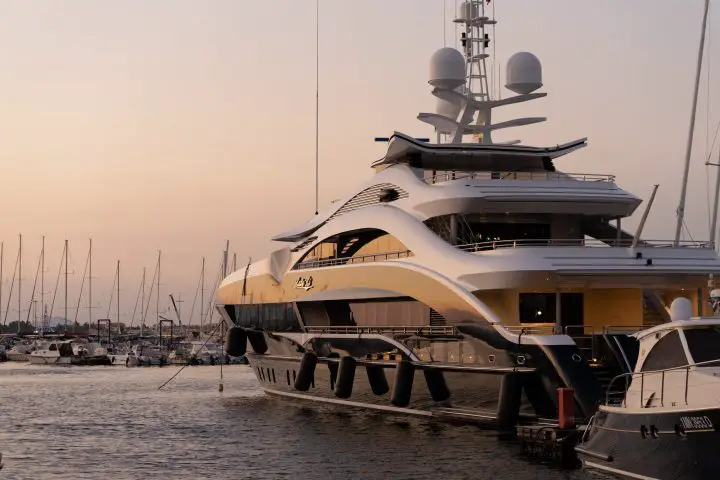
From our experience, we’ve seen people take two paths towards the liveaboard life.
- Some folks own their boat and use it for weekends or a week’s vacation here and there. They move aboard full-time as they transition to retirement, a work sabbatical, or remote work. Since it’s a gradual transition, these folks generally know what to expect.
- Then there are the folks who go all in—they know nothing about sailing or boats and sell it all and move aboard. For them, it’s a jump into icy cold water or learning a new language by moving abroad.
Which group is more successful? Group One generally knows what to expect, has worked out the kinks in their boat, and has already tackled the learning curve. There’s still a lot to take in, but they’re generally less stressed by it. If you can spend some time on your boat enjoying boating before moving onboard, it’s generally a good thing.
But, either way, being a full-time liveaboard is not a long-term lifestyle for most people. People who start from both groups seem to last an average of about one and a half to three years. After that, they’re ready to either sell the boat and move on or buy an RV or vacation land home that allows them to divide their time between boating and something else. People who last more than three years with only a boat are a very small minority.
One parting thought: Living on a boat full time and traveling is like having three or four full-time jobs. Each requires 30-40 hours per week when you include labor, research, and thinking and planning.
- Boat ownership — basic maintenance and cleaning
- Cruising full-time — destination and route planning, weather study
- Living aboard — cooking, cleaning, shopping, and everything else takes so much longer on a boat than in a house
- Your actual job — if you work aboard
How much does it cost to live full time on a yacht?
A lot depends on the size of the yacht. A small sailboat can be found fairly cheaply. For around $50,000US, you can get an older 35-foot sailboat in decent condition and move aboard with few problems. The biggest issue is finding a marina that allows live-aboard boaters. Slip fees will be your biggest expense and can be as high as $1,500 monthly in some areas. However, you can get monthly slips for as little as $300 in other places.
How to stay organized on a sailboat?
Sailboats have small spaces and not much storage, so keeping organized is key. The first step is to downsize your possessions to the bare minimum—only take what you absolutely need. The less you have, the easier your life aboard will be.
After that, it’s a matter of packing the boat so that everything has its place. Some boaters like to keep a spreadsheet of where they’ve packed everything away so they can find it quickly.
Is it cheaper to live in an RV or a boat?
Both of these activities are very dependent on location. Purchasing either one is very similar in cost. RV parks and marinas charge similar prices, but the cost varies depending on the location and services. In the end, however, moving an RV somewhere cheaper is easier and quicker, so you can live somewhere cheaply more easily.
Matt has been boating around Florida for over 25 years in everything from small powerboats to large cruising catamarans. He currently lives aboard a 38-foot Cabo Rico sailboat with his wife Lucy and adventure dog Chelsea. Together, they cruise between winters in The Bahamas and summers in the Chesapeake Bay.
Leave a comment
Your email address will not be published. Required fields are marked *
Save my name, email, and website in this browser for the next time I comment.
We’re in Myanmar right now and it’s SO epic… click here to follow along on Instagram.
- Meet the Team
- Work with Us
- Czech Republic
- Netherlands
- Switzerland
- Scandinavia
- Philippines
- South Korea
- New Zealand
- South Africa
- Budget Travel
- Work & Travel
- The Broke Backpacker Manifesto
- Travel Resources
- How to Travel on $10/day
Home » Budget Travel » Boat Life 101: How to Live on a Boat and Travel the World! (2024)
Boat Life 101: How to Live on a Boat and Travel the World! (2024)
Waves lap at the hull of the boat. Your feet are in the glassy water, a glass of rum in your hand, and a glorious sunset in front of you. Of course, the weather is perrrfect .
Just another day in the life of living on a boat.
Surely that’s not all what living on a boat is like though, right? What about the sea monsters ? What about getting shipwrecked and floating for days on end at sea awaiting rescue?
And as if a broke bum can really live on a sailboat. Come on!
Rest assured, greenhorn – I’ve got you.
I went from a baby sailor who almost blew up the boat, to hand steering my way across the Pacific Ocean using the Southern Cross as my bearing. And I did it all with very little cash to my name.
Now I’m here to pass on to you what it’s really like to live on a boat AND how to do it . It’s the how-to-poop, how-to-cook, how-to-sail – and the best places in the world to do it all in. PLUS how exactly you can put a budget on a dream.
Avast! I give you, how to live on a boat and travel the world.

Living on a Boat: What’s it Really Like?
How to live on a boat full time, best places in the world to live on a boat (and when to go) , the cost of living on a sailboat (and how to minimise it) , can you live on a sailboat for free, last tips for living the boat life.
“Indigo, where’s the F**CKING coffee?”
Yeah, you want to buy a boat. And then you’re going to sail off into the sunset – travelling the world without spending a dime – with twelve babes on one arm and the world’s greatest rum in the other. Oh, it’s going to be so lovely, isn’t it?
Welllllll , I’m not here to burst your bubble, but I am here to give you a wee reality check.
Living on a boat is not for suckers; it’s not for the impatient; it’s not for the stupid. I realise that many people who suck and are stupid, can and do sail. They give the rest of us a headache – don’t be them.
If you forget the coffee, the rest of the boat may very well feed you to the sharks. The only shop for the next 200 nautical miles is now a distant speck on the goddamn horizon, after all.
However, provided there is ample coffee, rum, and good conversation, there is nothing better than living on a boat. No, that is not a cliche.

Life on a sailboat is life at its most .
- The duality of boredom and near-death experiences.
- Harnessing the wind and moving soundlessly across the great blue spectacular.
- Fresh sashimi.
- Deep introspection.
- The oscillating moods of the crew that spread like the flu.
- Long stretches of time with no goddamn Instagram.
A boat becomes a very miniature village, and in this, you can touch on a very primal way of living; one that has been passed down to us from many millions of years of evolution.
The simplicity is not always poetic. But it will make you appreciate every damn cup of coffee – and isn’t that what life is all about?

Do You Want to Travel FOREVER??
Pop your email in below to get a FREE copy of ‘How to Travel the World on $10 a Day!’.
So here it is folks! The basic and hyperbole-filled how-to of living on a boat.
It’s just three simple things. (Sort of.) And then, the ocean is your oyster.
Hoist those sails and may the wind be ever in your favour.
Boat Life 101: Pooping

Don’t laugh! Pooping on a boat is your first lesson in how different living on a sailboat is to land life.
You have to think about the consequences of your every action: sustainable travel MATTERS . If it’s a small sailboat, it will likely have a manual pump instead of a flush. You do your business, and then pump, pump, pump.
And that’s not where it ends. You need to think about where exactly your poop is going.
It becomes very clear that all drains lead to the ocean.
Usually, your poops will be going into the boat’s holding tank, but they only hold so much. You need to know the regulations in the national waters of wherever the boat is because you can’t empty the holding tank until you’re far enough away from shore, certain mooring fields, and protected areas… for obvious reasons.
Now, I would argue you haven’t lived until you’ve dealt with a malfunctioning head (marine toilet). Nothing makes you appreciate modern sewerage systems like the sweet smell of shit.
Boat Life 101: Cooking + Provisioning
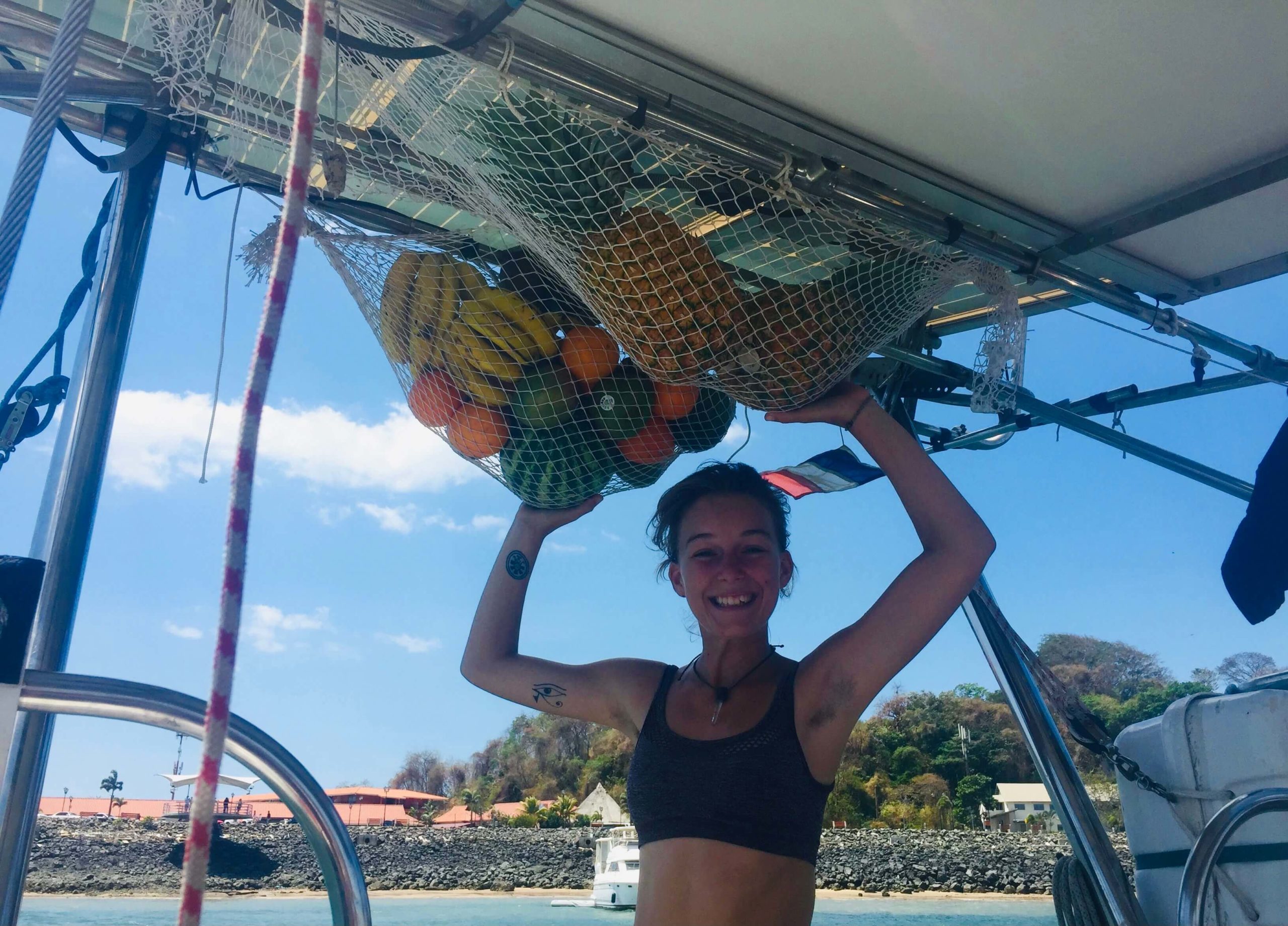
The consequences of your actions continue here. Even if you are sailing in proximity to shops or markets, the basic fact remains that the shops are on land and your boat is on the water.
That means there is no nipping to the servo for some extra milk that you forgot. You have what you have on the boat, and you make do.
So yeah, not bringing enough coffee for the passage? A dumb mistake you only make once.
Living on a sailboat has made me an organised (one might say obsessive, but one would be wrong) motherfucker. I am a HARDCORE list-writer, but you need lists when you live on a sailboat.

WRITE LISTS. And keep them going all the time.
- The food and supplies list.
- The fix-it list for maintenance.
- The visa requirements and beaurcracy list.
- The all-important books to read list .
If you go on an overnight sail and you know there’s food at the next anchorage, then you can get away with forgetting the coffee just this once. If you’re crossing the biggest ocean on Earth, that’s not gonna fly. You need to write a bloody list.
Also, food sometimes needs to be refrigerated. Refrigerators come with limited space and the frustrating tendency to gain sentience halfway through a passage. With sentience comes a severe attitude and willingness to ruin your food.
All I’m saying is, you gotta plan your meals, know how you’re going to store them, and write lists.
Oh, and it sounds obvious, but while sailing, the boat moves.
Yes, the stove on a boat is on a gimbal which means it swings with the motion of the boat and compensates for the movement. But when King Neptune feels the sailors on board have grown too comfortable, the soup says hello to the floor.
Boat Life 101: How do I sail this thing?

If you can take a shit and cook a meal while on a sailboat, you’re 90% done.
Collectively, we humans have been chucking some cloth on a bit of wood to capture the wind since the original discovery of Australia and the Solomon Islands (50 000 – 25 000 years ago).
Over the millennia, the process has become more refined. Now we can sail upwind and tack and all this fancy stuff. But ultimately, with a little patience and a lot of practice, anyone can learn to sail.
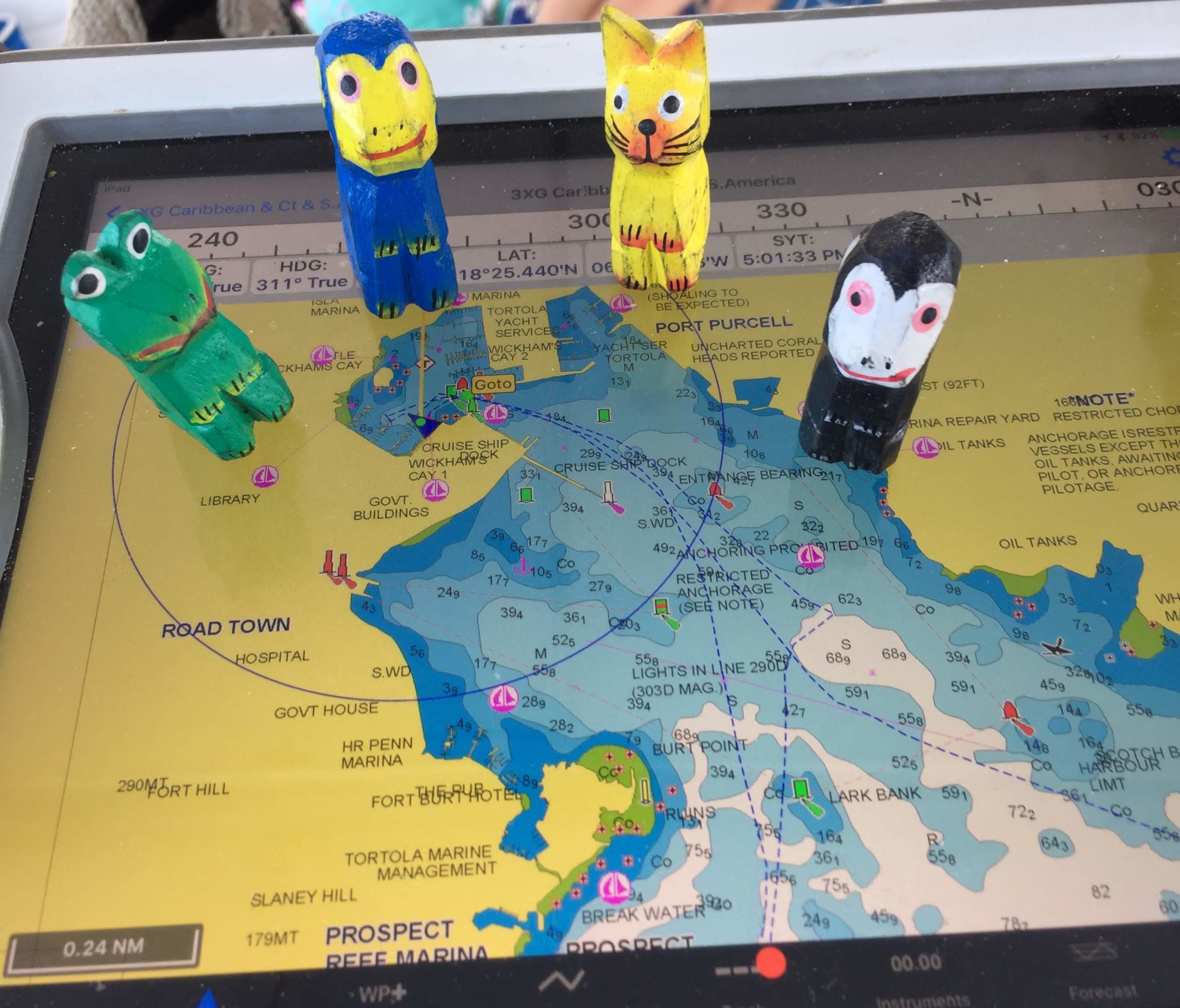
There is a multitude of electronic tools – chart plotters, AIS, GPS, Iridium GO – that help you keep a track of where the hell you are and give you detailed charts about where you want to go.
You can even get the weather sent in a tiny little electronic file via a device like the Iridium GO, even when you’re sailing across the Pacific Ocean . Very handy for avoiding boat-sinking storms!
Putting some sail on a mast and heading off has never sounded so sweet! But if you learn a thing or two about the trade winds , you can make your journey even sweeter.
The trades are these delicious winds that blow reliably from east to west, meaning you can access a reliable source of energy to propel you forward (provided you want to head west).
Trade wind sailing is famous for being fucking chill, with few gnarly storms and not too many becalmed days of boredom. The merchants of the tall ship days and the modern boat bum circumnavigating the globe both love the trade winds. Yes, for the easy sailing, and also for the good rum found at many of the ports along the way.
But when all else fails – say if your mast is struck by lightning and all your electronics are fried – there are still ways to orientate yourself on the big blue. These are methods that have evolved over our collective sailing history:
- Celestial (star) navigation : Using the constellations and a sextant, plus some maths, to figure out the boats latitude and longitude.
- Cloud navigation : Recognising the flat bottomed clouds associated with land to keep you on track back to terra firma.
- Reading the swell : This is just fascinating. This means understanding the persistent swell that move across world oceans and their relation to the star quadrants to estimate where your boat is and where it is going.
Test the Waters BEFORE You Sail – The Liveaboard Experience!
Another way you can get a taste of the boat life before you commit to a lifelong project is to charter a boat! Sailo does just that: Sailo lets you rent the boat life.
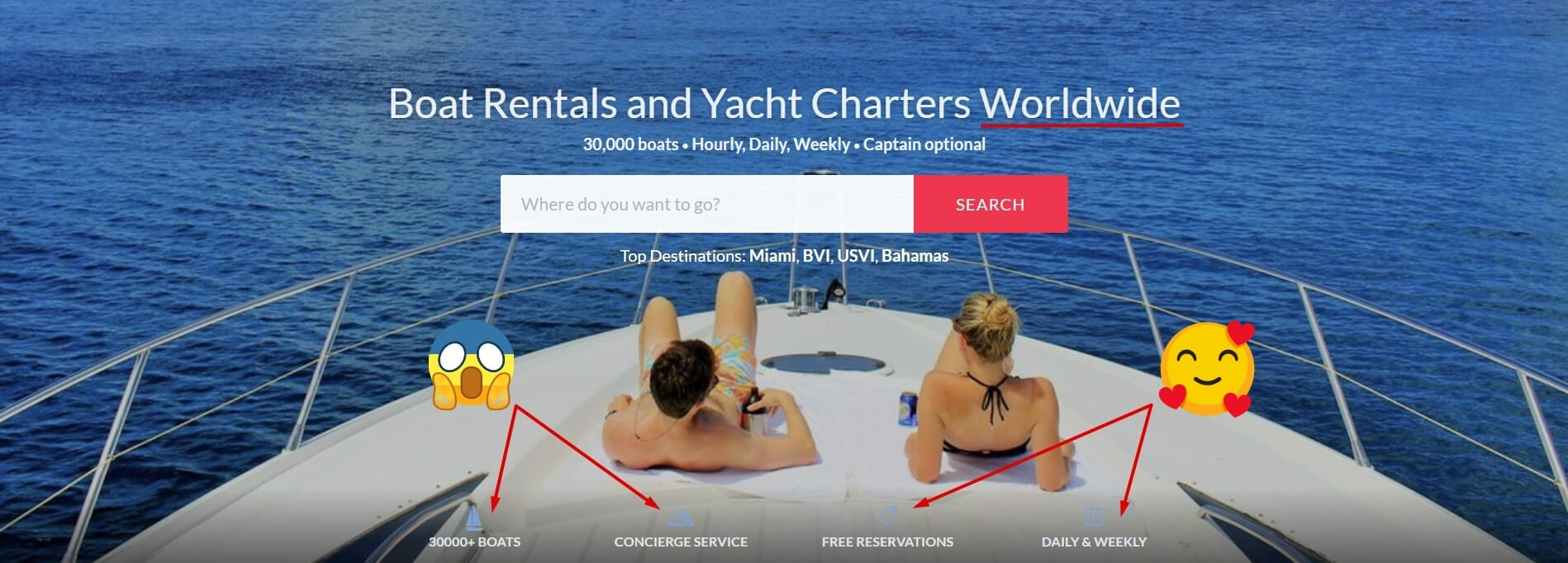
You get a boat, a sampler of the experience of living on a sailboat, and people on deck that actually know what the bloody hell they’re doing! With over 30,000(!) boats to charter from and a fabulous selection of the BEST places to live on a boat around, you’re guaranteed to find something that… floats your boat.
Sure, it’s not the no-frills boatbum style, but ultimately, you can choose to do it bareboat – with no captain and you bring all your own provisions. Or you can choose to have the boat crewed so you can sit back, relax and, learn a thing or two about boat life. (And drink champagne.)
Living on a boat comes with a host of challenges (and juicy rewards) that are made that much easier by picking a good place to do it in.
Access to quality boatyards, provisioning, internet connection – these are all big plusses for those living on a sailboat!
But also, all the stuff that made you want to partake in this mad boat lifestyle in the first place rate highly too. A plethora of remote beaches, magic sunsets, and a friendly cruising community of cool travel buddies (soon to become treasured friends) can make or break a dream destination.
I’ve also considered how easy it is to top up the cruising kitty with funds by rating how easy it is to find work in each place.
Australia + New Zealand

- When to go: November – May (NZ & southern Australia) April – September (northern Australia)
- Best suited liquor: EMU BITTER MAAAATE Whatever the Australians aren’t drinking.
I don’t care that the citizens of both these fine nations will be after me with pitchforks for lumping them in the same pile. Honestly, mate, bro, whatever, come at me. They’re both equally dope places to liveaboard your sailboat.
Yup, gonna say it right now, both these places can be expensive for the boat bum. But they also provide good-paying work opportunities if you can play the visa game right. So they are great places to slow down, pick up a travel job , and stack some cash for future ocean adventures.
You can also take a break from the boat life, and go on an epic backpacking adventure around New Zealand . You won’t know how much you miss the ocean until you take a break from her, trust me.
Also, the sheer diversity that I’ve so callously dumped in one heading is incredible.
Honestly, you can sail down to Stewart Island in the subantarctic waters and then back up to the Eden on Earth in the equatorial Torres Strait .
You could spend a whole, wonderful lifetime sailing between these two continents and still die regretting not having seen everything.
The long and the short of it:
- You can make bank here $$$!
- You can get your boat fixed properly here. Island nations like Australia and New Zealand have a wealth of boat building and fixing experience.
- There are well stocked supermarkets here, so you can stock up on bulk items that prove tricky to find in more remote locations.
- People are cool, remote beaches are cooler. And there is a metric shitton of incredible beaches here.
- There’s also an opportunity for non-boat adventures (like backpacking around Australia ) that will make you appreciate the ocean nomad life even more.
- Diversity! Of landscape and cultures.
- Dude, the first nations of Australia managed to cross over from Papua New Guinea (probably) 60 000 years ago. SIXTY THOUSAND (louder for those in the back). The knowledge on this ancient continent will humble you if you pause to listen.
- And the seafarers that made it to Aotearoa? The Maori are some of the most badass, friendly, wise, creative, HILARIOUS people you will ever have the privilege of meeting.
- $7 bottles of wine. Sorry. But like, yes please.
- There’s epic diving in New Zealand and all over Australia with endless (and scrumptious!) spearfishing opportunities.
- Living on your boat here is easy . Not without its struggles of course, but it’s always easier to struggle close to wifi connection.
The Caribbean

- When to go: The conventional advice says December – May, but you can sail here year-round if you know how to dodge hurricanes.
- Best suited liquor: Rum. Obviously rum. Maybe with a squeeze of lemon and a splash of cola.
If you can dodge the hangouts of the rich and the famous (or work out how to make money off them) sailing the Caribbean and living on a sailboat is very rewarding.
Salsa lessons in the streets of Puerto Rico , rum-soaked nights in the Virgin Islands , goat hunting, spearfishing , azure waters, and white sand beaches all the way down to Bonaire .
Getting into the charter boat game provides a great way to make dat money. During the high season, this is one of the most popular places in the world to charter a boat.
If you are happy to do your own boat repairs, a lot of fishing, and get clever with your travel budget , the cost of living in the Caribbean is not super expensive either. You just gotta know where to go for what.
Cheap coffee and rum can be brought in bulk in the Dominican Republic . There’s a Costco not far away in Puerto Rico , so you can get some bulk toilet paper. Then it’s onwards to a deserted island, a reef, and some endless fun in the sun.
- Cheap boat repairs are available in places like Rio Dulce, Guatemala. So, for those big projects you can save quite a bit of money by getting them done here.
- The rum. I mean, it has truly been perfected here.
- There are oodles of work opportunities in the charter business or in the superyacht world.
- Cheap flights back to the USA means you can feasibly travel between the USA and El Caribe guaranteeing you an endless summer.
- The glorious azure waters and their 27-degree celsius temperatures. Helllloo, nude night diving.
- Warm, deliciously WARM, diving.
- More people at the anchorages = a very social and welcoming community of cruisers. There is a great liveaboard culture that’s hard to replicate elsewhere.
- Easy trade wind sailing.
- Did I mention the rum?
The South Pacific

- When to go: May – October (You can arrive in the Marquesas in April with no problems.)
- Best suited liquor: A little vodka, a lotta soda, a squeeze of lime.
I won’t even try to hide my bias. I LOVE the Pacific.
Is it the best place to live on a sailboat for most people? Probably not. Because the distances between your boat and a grocery store are usually mind-boggling. It can be expensive. It can be lonely.
There’s just no way quite like travelling to places like French Polynesia the way you can on a boat. Out in the middle of the ocean life is not always easy, even if it is full of palm trees.
But fuck it, I love the Pacific, so we’re including it.
No, honestly, if you can mitigate the challenge of distance, you are rewarded with the best planet Earth has to offer. Incredible diving, a slow pace of life, some world-class hiking trails (and world-class peaks), lazy sunshiney afternoons. Perfect postcard sunsets. Mmmmm.
A full one-third of the globe is consumed by the Pacific Ocean, and scattered throughout this utter vastness are innumerable tiny little islands. Luckily for the bum of the seas, the trade winds can carry you from the Americas to these little flecks with few problems.
In fact, all the technical sailing here is relatively easy. As long as you don’t get becalmed at the equator thanks to the weirdness of the ITCZ band, it is easy sailing.
But you’re going to need a water maker and have a solid solar panel set up for power. Because between Panama and the Marquesas , there are approximately 3800 nautical miles – more if you go stop in at the Galapagos.
That’s a long way between places to buy coffee. And there’s not much in the way of supermarkets until you get to Tahiti , another 800 nautical miles away.
If you leave IndigoRadio on for long enough, inevitably Kiribati will come up. You can hide from hurricanes here. The South Pacific is defined by island life at an island tempo:
- You can get delicious fish on the end of your gidji real fast here.
- People-less anchorages.
- Dreamy atolls.
- And not a damn supermarket in sight.
Ok, not everyone’s idea of easy sailing, but certainly my idea of the best that living on a boat has to offer.
There is a multitude of lifetimes that could be spent escaping the rat race and kicking back in the Pacific. There is an awesome amount of diversity of landscapes and cultures here too, not to mention a proud seafaring tradition that we aspiring boat bums should shut up and learn from.
A Tip From One Pirate to Another
Okiedokie, you wild little circumnavigator-to-be! There are multiple ways to criss cross the globe. Resources like noonsite.com and Jimmy Cornell’s cruising guides will be invaluable to you in the planning and execution stages of your journey.
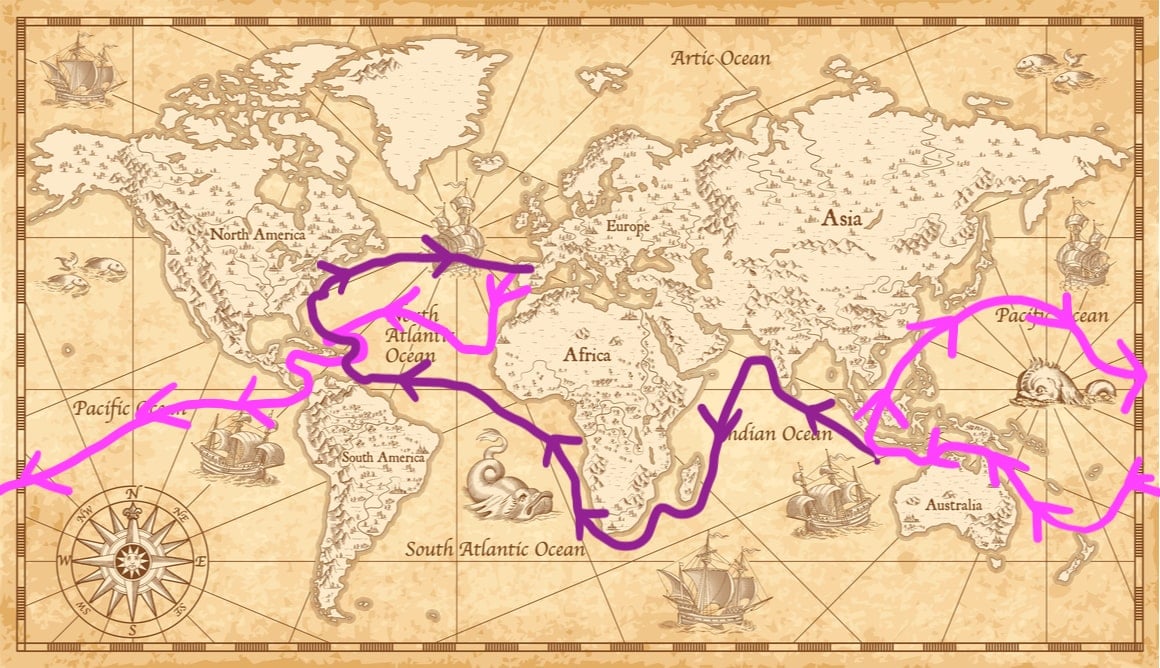
But at a glance : I would suggest starting in Europe and the mediterranean and picking up the trade winds west across the Atlantic in this order:
- Through the Caribbean and through the Panama Canal.
- Onwards across the South Pacific, kissing New Zealand and Australia before either…
- Circling through South East Asia and back across the Northern Pacific…
- OR continuing up past Sri Lanka then…
- Around the Cape of Good Hope before…
- Going back across the Atlantic and the northern coast of the USA and back home!
Use the trade winds to your advantage! Go west until you can go west no longer.

Things go wrong on the road ALL THE TIME. Be prepared for what life throws at you.
Buy an AMK Travel Medical Kit before you head out on your next adventure – don’t be daft!
No sugar coating here. Buying and maintaining a sailboat, no matter how much it resembles a tin can, adds up real fast.
But when the eternal sunshine and the lessons of the great blue spectacular call you – when King Neptune drafts you into his eternal service – it’s time to find a will and a way.
Here are a few tips to help you plan a trip that I’ve picked up from my short time making various vessels my temporary abodes:
- Don’t buy a project boat unless you want a project. It will cost you more to fix everything on a broken boat than it will to buy a boat that’s good to go.
- But, when you do need to repair, DIY. Endless learning, yay! Or, plan your sailing route to include time in places like the Rio Dulce where repairs are cheaper.
- Anchor more often than you stay in marinas. Marinas are devilishly expensive; anchoring is deliciously free.
- Volunteer on someone else’s boat before you get your own. 😉 If done right, this is win-win. You can take share in the labour of running a boat (for example by standing night watch) while learning the finer points of sailing from a master.
- Get seasonal work. There are so many options when it comes to this, from ‘backpacker’ staples like agriculture and hospitality to working on superyachts or as dive instructors.
- Or have residual or passive income if you’re real cool. If you’re on that elusive property ladder or earning money online , why don’t you have a boat? Just head off now and live off your automatic wealth. Be a cool kid.
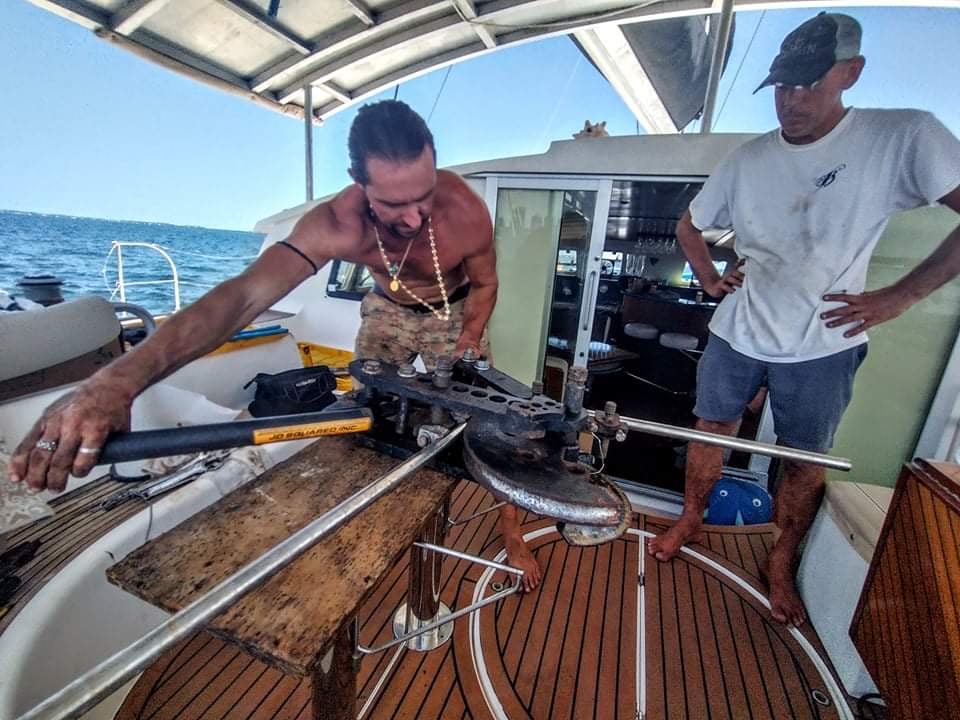
Of course, when a backpacker asks about the cost of living on a sailboat, they really want to know if you can live on a sailboat for free. When a family looking to take a sabbatical asks about the cost of living, they just want to know hard numbers and a budget breakdown.
At the end of the day, you can hoist a heavily patched sail on a jerry-rigged mast and work on the boat yourself, and eat only what you catch or grow. At the other end, you can set sail on a superyacht replete with full-time staff and jetskis.
We anchor in the same sand and watch the same sunset though, so you choose what you need to spend.
I would suggest being honest about your lifestyle. Consider being a little obsessive organised about your annual costs. Because costs are going to vary greatly from boat to boat.
How Much Does it Cost to Live on a Boat? (Pricing Breakdown!)
Obviously, the variables that go into the cost of running a liveaboard boat are vastly dependent on your style of living and where in the world you are sailing.
Generally speaking, it is cheaper to spend more time at anchor and in countries with a lower cost of living. However, insurance will still be 1% – 2% of the cost of your boat and port fees are port fees. Still gotta pay ’em, whether you’re a broke bum or a gazillionaire.
Sailing and Diving Go Together Like… Sailing and Diving!
A way to combine two of the best things on Earth is to indulge in a liveaboard experience .
This is exactly what it sounds like – you live aboard a boat, usually in some fantastic and tropical destination. You can indulge in some wonderous diving, and pick the brains of the crew about their tips on living aboard a vessel!
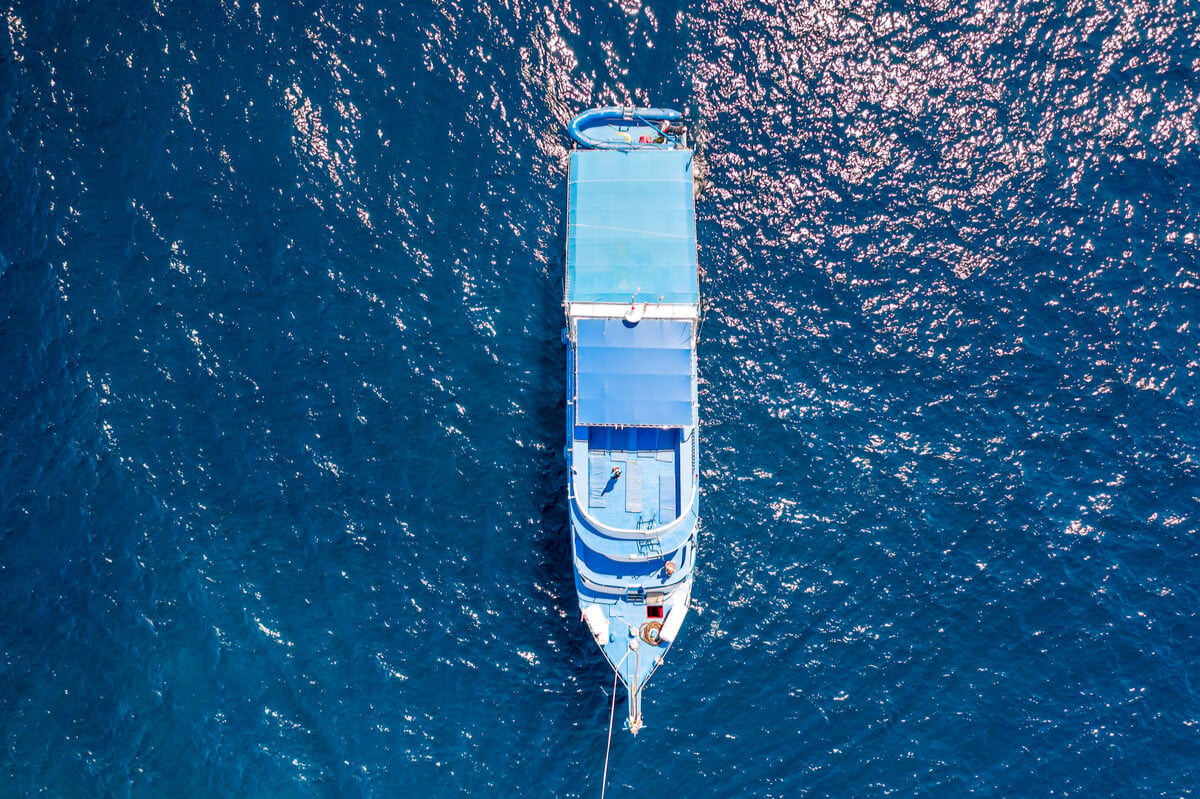
The focus of the liveaboards is the epic diving experiences in destinations that just aren’t as accessible when travelling in other ways. Also, it’s a great inspiration for you to hustle your way onto your own boat so that diving amongst reef sharks becomes as normal as your morning coffee.
Now the controversial stuff.
I’ve had someone say, a little tongue in cheek: damn yachties get the wind for free and now they want everything else for free!

While I think being resourceful and a bargain hunter is the best way to live your life, boat or no boat, it’s just as important to have a bitta respect. So when you hit the seas or the road, I don’t see the point in haggling hard over what amounts to 50 cents.
When it comes to boat stuff, in particular, break it down into your shelter, food, and fuel, and don’t aim to get everything for free .
Aim to sustain your lifestyle for as long as possible in a way that doesn’t compromise it for everyone else. In other words, be ethical about your damn budget travel. The most rewarding consequence of trying to keep costs down is creating a more or less self-sustaining yacht. Better for you and your personal growth; better for this pale blue dot we call home.
Sailboat Cost Cutter #1: Shelter
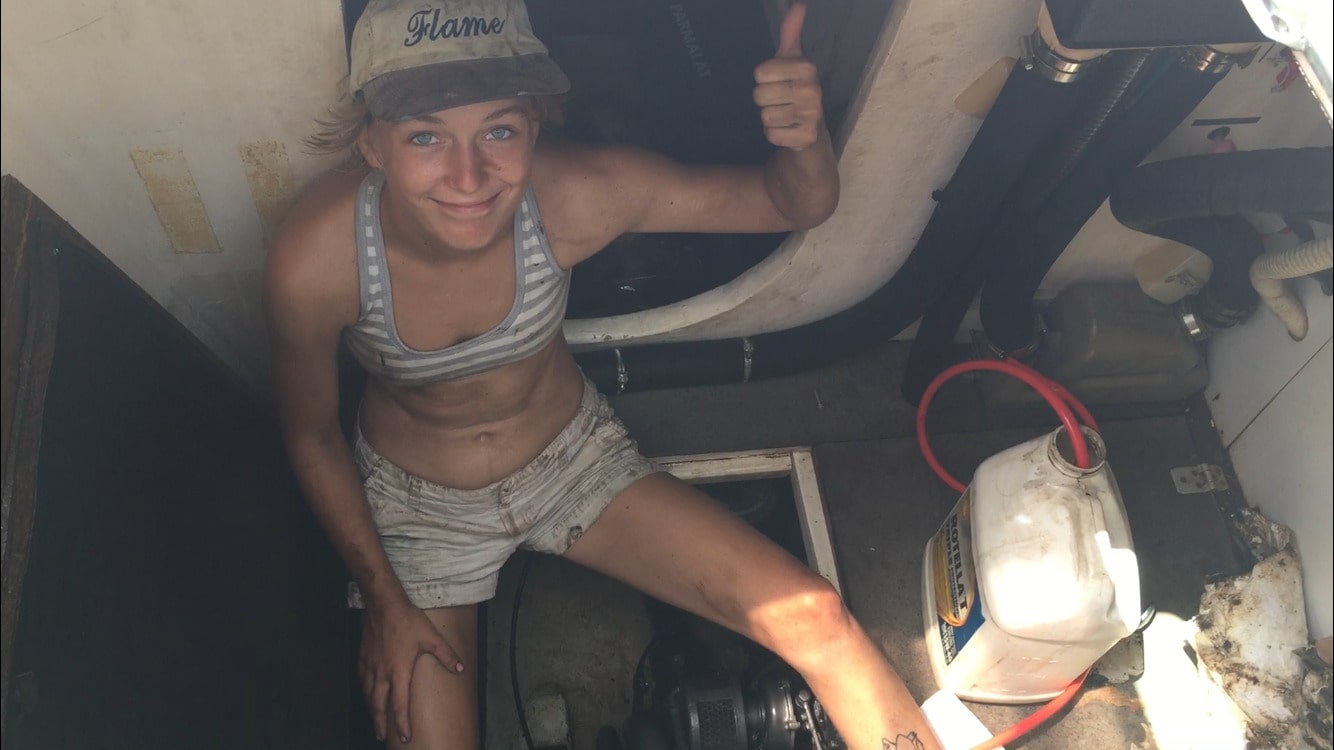
Maintaining your shelter (i.e. your boat) is not going to be a ‘free’ exercise. You will pay with money, or your own labour and time, to maintain it.
It will be an exercise in learning all kinds of systems – both mechanical and electrical – and time management. Do you want to pay for that task with money or your labour? Whatever you land on for each maintenance task that inevitably comes up, you will learn that to sustain this boat bum lifestyle you just gotta take care of your wee home and she will take care of you.
It is always free to sleep on your boat while underway. Well, it doesn’t cost any money anyway. You are investing a lot of time and energy into the passage, but you’re not paying to sleep on your boat!
Once you arrive, you can choose to stay in a marina, on a mooring, or at anchor. Anchoring will always be the cheapest (usually free) and so you don’t have to spend a lot to live in paradise. But don’t be a dick.
- Have the right visa.
- Be respectful of others in the anchorage.
- Don’t dump shit (literal or otherwise) overboard unless you are sure you’re allowed to.
- Be friendly and offer your neighbours a hand if they need one.
This lifestyle can bring out the best in us provided we’re responsible travellers , so lean into that.
Sailboat Cost Cutter #2: Fuel
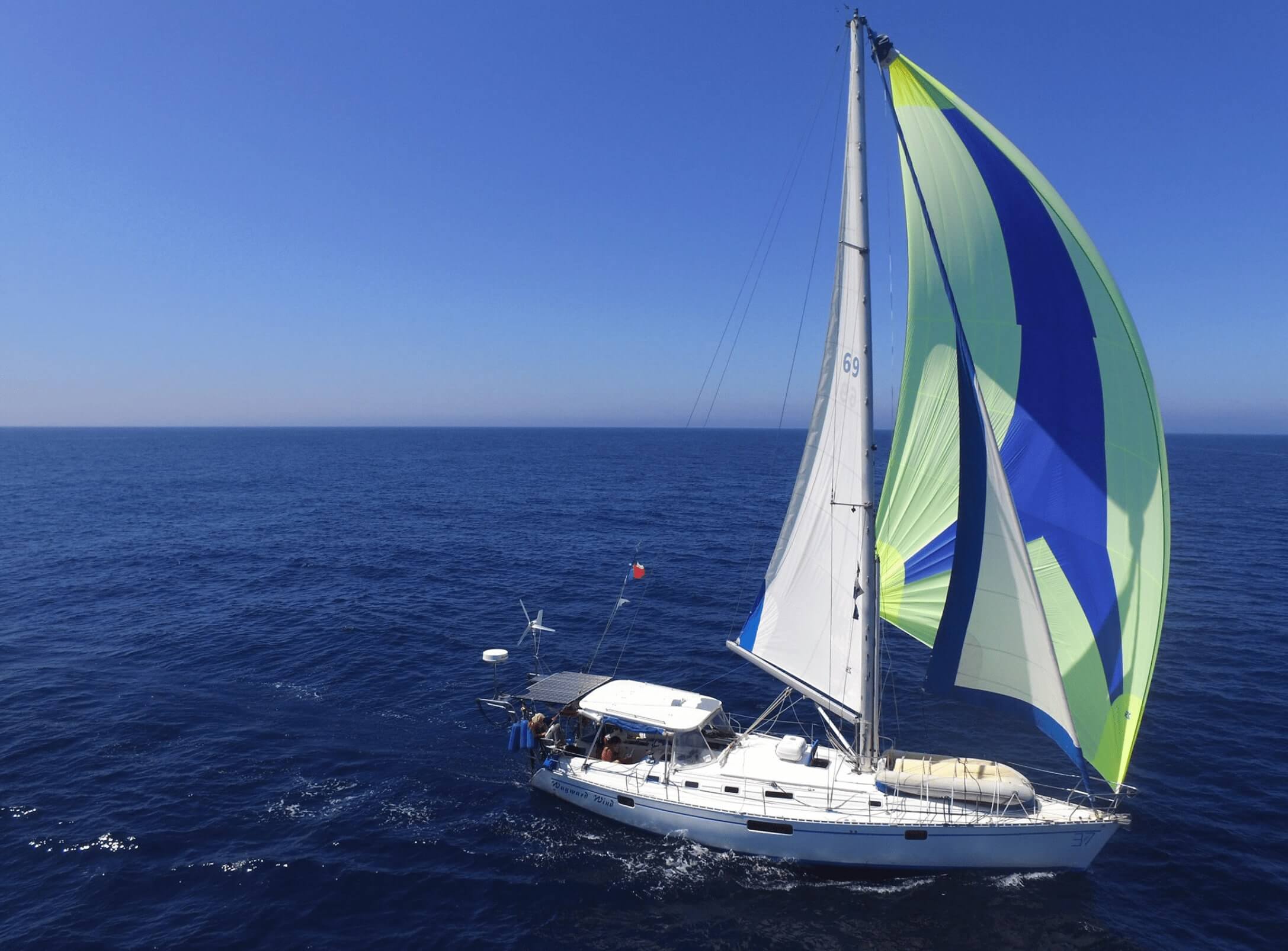
As my friend said, damn yachties get the wind for free! Much of the energy needed to go from A to B is yours for the taking, provided you can harness it efficiently with your sails. But as with DIY vs paying for repairs, sometimes you pay just as dearly with your time as you would have with your money.
If you are becalmed, the engine may be just the thing to help you out. When coming into a marina, you’re not going to want to be under sail. Likewise, in a storm, it is time to put the sail away and turn on the engine for stability. So having a little diesel onboard is necessary.
Compared to land life, people living on a boat can minimise their carbon footprint and live very simply. But it’s difficult to ask the Earth for none of its resources. Just be mindful about the way you live, be eco-friendly , and try your best to not waste resources.
You can recharge your boat batteries for electronics with the sun though – provided you can harness it with solar panels. And a lot of liveaboards will have a wind turbine for extra power on the less sunny days. This stops you from needing to use the engine so much. Yay for money, yay for the environment.
It’s never going to be completely free. You either pay with time or money. But you can certainly save a lot of money on fuel while living on a boat. This is a rewarding way to sustain your lifestyle and be kinder to the planet.
Sailboat Cost Cutter #3: Food
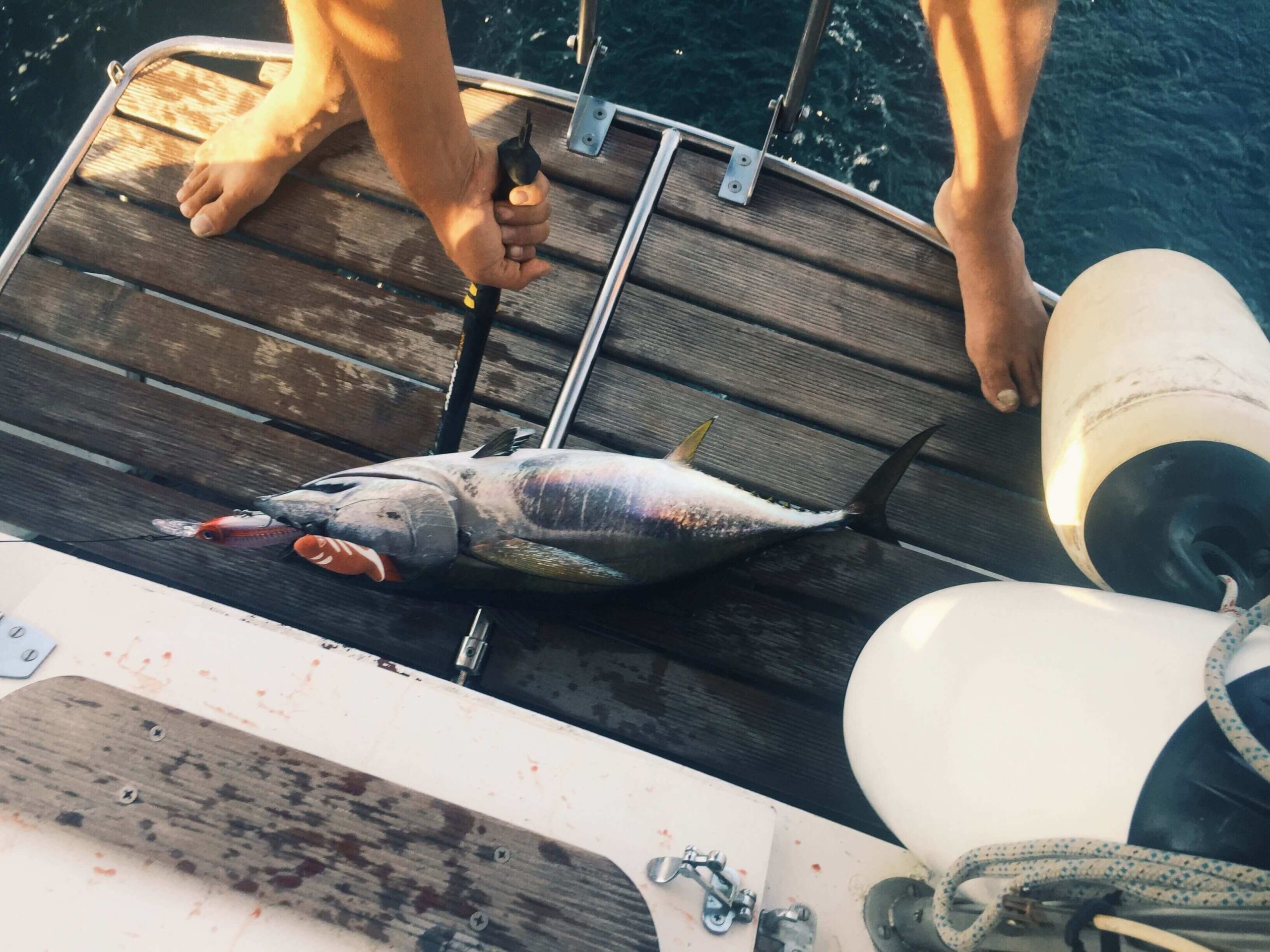
I apply the same principles to food as I do to food and shelter: you pay with money or you pay with time and labour. Also, don’t be a dick, and be good to the environment. What comes around goes around.
This means, when it’s available, I will spearfish and I will hunt. This is me paying for my food with my time and labour rather than money. But I would also argue that it’s fulfilling my other principles of:
- Not being a dick and…
- Being good to the planet.
Hear me out: I think vegans and hunters alike would agree that factory farming and the industrial scale of meat production are fucked up. It’s a waste of our water, arable land, and produces poorer quality meat. Furthermore, the animals suffer tremendously.
But if I’m kicking it in Kiribati, there is no way I’m going to be a vegetarian and still believe I’m doing a solid for the planet. The carbon footprint required to get my strictly vegetarian tofu to the remote islands is greater than the carbon footprint of me harvesting a fish every few days.

That fish has swum about its whole life having a good time doing cool fish stuff. And then, like all of us will, it died. I have immense gratitude toward this being for providing me with sustenance. I feel like I am part of a cycle of life that predates my puny existence.
In the same vein, to bring tofu to the Caribbean has required a process that is on the whole less ethical than going for a shoot and getting a feral goat for dinner.
The land cleared to grow the soybeans + the production of soybeans into tofu + the carbon cost of flying the tofu product into the island = YIKES.
The feral goats that destabilize delicate island ecosystems? They had a good goat-y life and then they became a good goat-y curry that fed 12 people.
Ok, I’m done. Eat meat or don’t; ethical animal tourism and all that jazz, however, morality is complicated. There are ways to reduce the money you spend on food and your carbon footprint without being a dick.
I’d also say that in the process of harvesting your own food, you gain a greater appreciation for life on this planet. And get a sense of urgency around stepping up to protect it. Give it a try; you might be surprised.
Epic Tips for Broke Boatpackers
- Know your knots. Apart from knots being fascinating in their own right (knots were probably invented alongside stone tools?! ), they are the foundation of boat life. Knowing a couple of basics , like a bowline, will give you a good leg up when joining a boat.
- Be able to cook at least two decent meals, also be clean. You aren’t only working, but living on this boat with someone. Take care of your space and bring some good food to the table and you will go a long way as a crew member.
- Go to docks and ask around. This is a good way to meet people – even if you just end up crew for a day sail. Be friendly, make yourself known, and find you’ll find yourself on a boat in no time.
- Facebook can be your friend. When walking the docks fails, there is a multitude of Facebook and other social media groups dedicated to connecting wannabe crew with boats!
- Know how to write about yourself on your Facebook adverts. But you’ve got to know how to sell yourself! If you can cook a bomb-ass puttanesca and can tie a reef knot – mention it! Don’t sell yourself short! That being said, don’t exaggerate and tell fibs about the sailing experience you (don’t) have. The truth will come out painfully during the first bit of real sailing you do, so be honest. There’s usually captains willing to teach the basics for a bit of company and a good meal.
- Knowing how to fillet a fish is handy. Sailors know how to sail. They don’t necessarily know how to fish. So if you can bring this skill to the table, you’re going to be a beloved crew member in no time!

Drink water from ANYWHERE. The Grayl Geopress is the worlds leading filtered water bottle protecting you from all manner of waterborne nasties.
Single-use plastic bottles are a MASSIVE threat to marine life. Be a part of the solution and travel with a filter water bottle. Save money and the environment!
We’ve tested the Geopress rigorously from the icy heights of Pakistan to the tropical jungles of Bali, and can confirm: it’s the best water bottle you’ll ever buy!
Sweet, glorious tips from a pro-pirate to a soon-to-be, the seas are calling, so go sail them!

Stay Safe, Boat Bums!
One thing that many intrepid little sailors are not good at? Estimating danger and the likelihood of death.
Maybe this is a good thing because you do have to be the right sort of mad to get into a sailboat and cross an ocean.
Maybe, just maybe, you should consider purchasing travel insurance before shit hits the fan though. But enough from me, hear it from a fellow adventurer.
ALWAYS sort out your backpacker insurance before your trip. There’s plenty to choose from in that department, but a good place to start is Safety Wing .
They offer month-to-month payments, no lock-in contracts, and require absolutely no itineraries: that’s the exact kind of insurance long-term travellers and digital nomads need.

SafetyWing is cheap, easy, and admin-free: just sign up lickety-split so you can get back to it!
Click the button below to learn more about SafetyWing’s setup or read our insider review for the full tasty scoop.
FAQs About Life on a Boat
Here’s what I know you want to know about living on a boat!
What is the cheapest place in the world to live on a boat?
This will depend on your spending habits, of course. If you give yourself a budget of $3000 per month, you will spend $3000 per month. That being said, travelling around Southeast Asia and South America is an exquisite choice. They have superb cruising and a low cost of living. The Philippines stands out as a paradise to explore while on a budget.
Can you live on a boat in a marina?
You absolutely can! Now, call me biased, but the point of living on a boat is to go adventuring so I’d keep marina stays strategic . Only stay as long as it takes to get repaired, or get provisions, and then take off into the sunset!
Can I sail around the world?
It doesn’t take much to put the sails out and follow a bearing. It also doesn’t take much to lose your mast in a surprise squall. Of course, you can sail a boat around the world, but you need to be organised. Provisions, finances, weather. The trip of a lifetime is not for the faint-hearted. Not that that should stop the intrepid adventurer!
SOMETHING REALLY IMPORTANT NOT TO FORGET
Follow instructions and ACTUALLY LISTEN. Put that ego aside, mate. The Captain ALWAYS has the final say, and if they say duck, you DUCK. The boat life can be real unforgiving. Oh, and learn how to handle your rum! It’s a pirate’s life and, well, nobody wants to be at sea with that guy…
Do sea monsters really exist?
Oh yes. Without a doubt. You just won’t meet the monster until you’ve been at sea for more than 25 days straight. The crew are tired of each other. The boat keeps breaking. There’s a storm on the horizon. It’s night watch again and the clouds are hiding the stars. You wonder if your mother is worried for you and when you might be able to call her again. Briefly, you lean over the side of the boat and wonder what it would be like to just walk off. Would you sink or swim? The sea monsters don’t live in the sea.
Fair Winds, Sailor!
Living on a boat will challenge you.
There is no other lifestyle that forces you to be attuned to weather patterns, engine maintenance, personal dynamics, ethical dilemmas at every mealtime; to consider watermakers and wind turbines; to completely surrender while also stepping up and getting shit done.
The nitty-gritty of how to live on a sailboat will not be fully revealed to you until you step onto one and do it. But, if you can poop and provision you’re halfway there!
You gotta lick your finger and hold it up to the wind. Ah yes, the trades blow west. Rum and a seriously sexy sunset await.

And for transparency’s sake, please know that some of the links in our content are affiliate links . That means that if you book your accommodation, buy your gear, or sort your insurance through our link, we earn a small commission (at no extra cost to you). That said, we only link to the gear we trust and never recommend services we don’t believe are up to scratch. Again, thank you!
Indigo Blue

Share or save this post

I truly enjoyed this read. I am under a government contract for the next while, but have a plan to retire and become a full timer somewhere warmer than Canada. I have been making my own notes and your writing gave me plenty more tips. Please feel free to email and keep me in the loop. Thanks so much and happy sailing!
Amazing read, thank you so much! I’m planning to get on with my own boat living dream and was curious if you (and fellow readers ) could share your thoughts on some of the big issues of boat living you have experienced? Much obliged 🙂 Keep up the good work!
First of all, welcome to the boat life! Biggest issues: Realistically the biggest issue is usually finances. The ocean is constantly wearing away at your boat and trying to sink it. Buying and maintaining a boat is expensive. That’s why so many boat lifers end up in the charter or delivery business – either as crew or as owner/operators – because it pays well.
Once you have your cruising kitty sorted, the next biggest issue is crew dynamics. Sailing alone is demanding, lonely, enthralling, and incredible all at once. Having crew on board and stepping up as captain is a trip in itself. Managing a team is always challenging – let alone when your team lives on a tiny sailboat and is constantly fighting the elements and can never take a break from each other.
The actual sailing and reading of the weather – that stuff becomes easy! This is why you should make yourself stop every so often and remind yourself how wild and wonderful it is that you’re getting around using the freaking wind! Also, the stars, man. If there’s one reason I’d cross the Pacific again for, it’s the stars.
Good luck and fair winds!
That is a f*cking great 101 boat guide! ahah Thank you Indigo for it and welcome to the writer’s team 🙂
Leave a Reply Cancel reply
Your email address will not be published. Required fields are marked *
Save my name, email, and website in this browser for the next time I comment.
Notify me of followup comments via e-mail.

Affordable Ways to Live on a Sailboat: Expert Tips for Cheap Living
Alex Morgan

Living on a sailboat can be an exciting and adventurous way to embrace a simple and cost-effective lifestyle. Whether you’re seeking a temporary escape or a long-term living arrangement, living on a sailboat offers unique benefits and challenges. Understanding the essentials, from choosing the right sailboat to reducing living costs, generating income, and embracing sustainable living practices, is crucial. Let’s explore the key aspects of living on a sailboat and discover tips for a comfortable and enjoyable sailboat lifestyle.
Introduction to Living on a Sailboat:
Living on a sailboat provides a sense of freedom and connection with nature. It allows you to disconnect from the complexities of modern life and embrace a minimalistic approach. It’s essential to be aware of the benefits and challenges of sailboat living before embarking on this journey.
Choosing the Right Sailboat:
Selecting a suitable sailboat is a crucial step in creating an affordable and comfortable living space. Factors such as size, layout, condition, and budget need to be carefully considered. Tips for buying a used sailboat can help ensure a wise investment.
Essential Equipment and Supplies:
Equipping your sailboat with the necessary tools and supplies is essential for a smooth sailing experience. Must-have equipment, along with stocking up on supplies, will help you navigate life on a sailboat with ease and preparedness.
Reducing Living Costs on a Sailboat:
Living on a sailboat can significantly reduce living costs compared to traditional housing. Minimizing marina fees, managing energy consumption, reducing water usage, thrifty grocery shopping, and DIY maintenance and repairs are key strategies to keep expenses low.
Generating Income while Living on a Sailboat:
Finding ways to generate income while living on a sailboat is essential to sustain your lifestyle. Remote work opportunities, offering boat-related services, and freelancing or starting a remote business are options to explore.
Living Sustainably on a Sailboat:
Embracing sustainable practices is not only beneficial for the environment but also contributes to a self-sufficient sailboat lifestyle. Utilizing renewable energy sources, reducing waste through recycling, and practicing local and sustainable fishing are ways to live harmoniously with nature.
Tips for a Comfortable and Enjoyable Sailboat Living:
Maintaining good hygiene, staying safe on a sailboat, and finding community and socializing are vital aspects of ensuring a comfortable and enjoyable sailboat living experience.
Living on a sailboat can offer a unique and fulfilling way of life. By understanding the fundamentals and adopting practical tips, you can embark on this extraordinary adventure with confidence and make sailboat living a memorable experience.
Key takeaways: 1. Living on a sailboat maximizes freedom and adventure: Living on a sailboat allows for a mobile and flexible lifestyle, with the ability to explore new destinations and beautiful coastal areas. 2. Living on a sailboat requires careful planning and consideration: Choosing the right sailboat and stocking up on essential equipment and supplies is crucial for a comfortable and successful sailboat living experience. 3. Living on a sailboat can be cost-effective: By minimizing marina fees, managing energy consumption, reducing water usage, practicing thrifty grocery shopping, and DIY maintenance and repairs, it is possible to live on a sailboat cheaply and sustainably.
Benefits and Challenges of Living on a Sailboat
Living on a sailboat offers a unique set of benefits and challenges. From the freedom and adventure of exploring different destinations to the deep connection with nature, living on a sailboat provides a fulfilling and fulfilling way of life.
One of the major benefits of living on a sailboat is the freedom it offers. You have the opportunity to sail to remote islands and discover hidden coves, experiencing new adventures along the way. This sense of freedom and adventure is unmatched.
Living on a sailboat also allows you to deeply connect with nature. Waking up to stunning sunrises, swimming in crystal-clear waters, and being surrounded by marine life enhances your appreciation for the natural world. The beauty and tranquility of the ocean become a part of your daily life.
Another advantage of living on a sailboat is the simplicity and minimalism it encourages. With limited space, you learn to prioritize essentials and let go of unnecessary possessions. This minimalist lifestyle leads to a more fulfilling and clutter-free life, allowing you to focus on what truly matters.
Living on a sailboat fosters self-sufficiency . You rely on your own skills and resources to navigate, maintain the boat, and manage energy and water usage. This cultivates a strong sense of independence and self-reliance .
Being part of the sailing community is another benefit of living on a sailboat. The sense of camaraderie among like-minded individuals who share your passion for sailing and adventure is unparalleled. You have the opportunity to connect with others who understand and appreciate your lifestyle.
Living on a sailboat also comes with its own set of challenges. Adapting to weather changes, handling maintenance and repairs, and managing limited resources require flexibility and problem-solving skills . This lifestyle demands adaptability and resilience .
Living on a sailboat means being weather-dependent . You need to plan your travels and daily activities around the wind and currents. While this can be challenging, it also adds a sense of rhythm to your lifestyle and allows you to appreciate the power of nature.
To make the most out of living on a sailboat, it is important to embrace both the benefits and the challenges. Maintain a positive mindset, continue honing your sailing skills, and be adaptable to enhance your experience on the water.
Choosing the Right Sailboat
Looking to embark on an adventurous lifestyle on the open sea? Let’s set sail and explore the key aspects of choosing the right sailboat. From factors to consider when selecting your vessel to valuable tips for buying a used sailboat, we’ll navigate through the sea of options and guide you toward making an informed decision. So, hoist the anchor and join us on this exciting journey to finding the perfect sailboat for your dreams of living aboard.
Factors to Consider when Choosing a Sailboat
When choosing a sailboat, there are several factors to consider. You should take into account the size of the sailboat, the number of people living on board, and the desired comfort level. It’s important to consider the number of cabins, berths, and storage space needed.
Sailing performance is another important factor to consider. You should assess the sailboat’s speed , maneuverability , and its ability to handle different weather conditions .
The construction material of the sailboat is also a crucial aspect to think about. You should consider whether the sailboat is made of fiberglass , aluminum , or wood . Each material has its own advantages and disadvantages in terms of durability and maintenance .
Before purchasing a sailboat, it’s essential to thoroughly inspect its condition. Look for any signs of damage or wear and tear . It may be beneficial to hire a professional surveyor to assess the sailboat before making a decision.
Age is another factor to take into account. Older boats may require more maintenance and repairs, so it’s important to consider the age of the sailboat before making a purchase.
It’s crucial to determine your budget and search for sailboats that fall within that range. Don’t forget to consider additional costs such as equipment, repairs, and marina fees .
The layout and amenities of the sailboat are also significant factors to evaluate. Ensure that the sailboat’s layout meets your living requirements. Consider amenities such as a functional galley , bathroom facilities , and comfortable seating areas.
Researching the reputation and resale value of the sailboat brand and model is also recommended. This will ensure that the sailboat retains its value over time.
By considering these factors, you can make an informed decision when choosing a sailboat that suits your needs and preferences.
Tips for Buying a Used Sailboat
1. When purchasing a used sailboat, it is important to thoroughly inspect the hull and deck for any damage or signs of wear. Look out for cracks, soft spots, or indications of previous repairs.
2. Don’t forget to check the rigging and sails to ensure they are in good condition. Keep an eye out for fraying, corrosion, missing or damaged parts that might need attention.
3. Before making a final decision, make sure to test the engine and other mechanical systems to ensure they are functioning properly. In some cases, it might be a good idea to hire a professional surveyor who can thoroughly inspect these systems on your behalf.
4. It is equally important to inspect the electrical and plumbing systems of the sailboat for any issues or potential problems. This step is crucial to ensure that these systems meet your needs and are safe to use.
5. In order to have a better understanding of the sailboat’s overall condition, take the time to research its history and maintenance records. This will help you identify any evidence of neglect or improper maintenance.
Pro-tip: Prioritize getting a sea trial before finalizing your purchase. This will allow you to assess the boat’s performance and handling on the water, giving you a better idea of its suitability for your needs.
Essential Equipment and Supplies
Living on a sailboat can be an exciting and cost-effective way to experience a different kind of lifestyle. In this section, we’ll explore the essential equipment and supplies you’ll need to make your sailboat life comfortable and stress-free. From must-have equipment that ensures smooth sailing to stocking up on supplies for a self-sufficient life at sea, we’ll cover it all. So, get ready to hoist your sails and embark on an adventure that’s both thrilling and budget-friendly!
Must-Have Equipment for Living on a Sailboat
– When it comes to living on a sailboat, must-have equipment is essential. This includes anchoring equipment, safety equipment, navigational instruments, communication devices, galley equipment, electrical systems, plumbing systems, and mooring and docking equipment.
– Anchoring equipment , such as an anchor, chain, and anchor line, is crucial for securely mooring the boat in various locations.
– Safety equipment is of utmost importance for ensuring the safety of everyone on board. This includes life jackets, throwable flotation devices, fire extinguishers, and first aid kits.
– Navigational instruments are essential for safely navigating the waters. These may include a compass, GPS unit, and charts to guide the sailor in the right direction.
– Communication devices , like a VHF radio or a satellite phone, are crucial for staying connected and seeking assistance from other vessels and emergency services.
– Galley equipment is necessary for cooking and storing food. Must-have items for the galley include a stove, refrigerator or cooler, pots and pans, cutlery, and storage containers.
– Electrical systems , including batteries, solar panels, and inverters, are important for powering lights, electronics, and other appliances on the sailboat.
– Plumbing systems are essential for access to freshwater and maintaining hygiene. This includes freshwater tanks, a water pump, and a marine toilet.
– Mooring and docking equipment , such as dock fenders, lines, and cleats, are necessary for safely securing the sailboat, protecting it from damage, and ensuring stability while docked.
Stocking Up on Supplies
When living on a sailboat, it’s important to have all the necessary supplies for your journey. Here are the key items you should stock up on:
– Food and Water : Purchase non-perishable food items that can be easily stored and prepared on the boat. Stock up on canned goods, dried fruits, nuts, and grains. Make sure you have enough fresh water for drinking and cooking.
– First Aid Kit : Prepare a comprehensive first aid kit that includes bandages, antiseptic ointment, pain relievers, and any necessary prescription medications. Don’t forget to include seasickness medication.
– Cooking Equipment : Bring along pots, pans, and cooking tools. Make sure you have a reliable stove or grill for cooking meals onboard.
– Safety Equipment : Have enough life jackets, signaling devices like flares or a whistle, fire extinguishers, and a well-stocked toolbox for minor repairs.
– Cleaning Supplies : Stock up on dish soap, sponges, laundry detergent, and garbage bags. Keeping your living space clean and organized is essential for comfort and hygiene.
By carefully stocking up on these supplies, you’ll be well-prepared for your sailboat living adventure.
Reducing Living Costs on a Sailboat
Living on a sailboat can be a thrilling adventure, but it’s important to minimize costs to make it sustainable in the long run. In this section, we will explore practical strategies to reduce living expenses on a sailboat. From minimizing marina fees to managing energy consumption, reducing water usage, thrifty grocery shopping, and DIY maintenance and repairs, we’ll uncover savvy techniques that will help you live affordably while enjoying the freedom and beauty of a life on the open sea.
Minimizing Marina Fees
Minimizing marina fees is of utmost importance to sailboat residents. Here are some effective strategies that can help reduce docking and mooring costs:
- Look for discounted rates: Many marinas offer discounts for long-term stays. It is wise to inquire about monthly or annual contracts as they can significantly reduce fees.
- Consider off-season rates: Marinas often have lower rates during the off-season. Taking advantage of these times can help minimize expenses.
- Share a slip: If you don’t need a full slip, consider sharing a space with another boat owner. Sharing expenses can save money for both parties involved.
- Anchor out: Instead of docking at a marina, you can choose to anchor out in a designated anchorage area. This option is either free or significantly cheaper than marina fees, but it does require more self-sufficiency.
- Join a boating association: Some associations offer member benefits, such as discounted dockage fees at partner marinas. Research and join these associations to avail of potential savings.
- Utilize transient slips: When passing through an area, opt for transient slips instead of long-term contracts. These are typically cheaper and allow for short-term facility use.
- Maximize efficiency: Keeping your boat well-maintained can help minimize costly repairs and upgrades. Efficiently managing energy consumption and reducing water usage can also result in savings on utilities.
By implementing these strategies, sailboat residents can effectively minimize marina fees and make their lifestyle more affordable.
Managing Energy Consumption
Managing energy consumption is crucial for a sustainable and efficient lifestyle on a sailboat. To effectively manage energy, here are some strategies you can incorporate:
1. Install solar panels: Solar power is a clean and renewable energy source that can meet your electrical needs.
2. Use energy-efficient marine appliances: Opt for appliances specifically designed for marine use that consume less power.
3. Utilize LED lighting: LED bulbs are energy-efficient and have a longer lifespan compared to traditional incandescent bulbs.
4. Implement a wind generator: Harness the power of the wind to generate electricity and supplement your energy requirements.
5. Maximize natural ventilation: Open windows, hatches, and vents to promote air circulation and reduce reliance on power-hungry fans or air conditioning.
In addition to these strategies, it is crucial to be mindful of your energy usage by turning off lights, electronics, and appliances when they are not in use. By adopting these energy-saving practices, you can reduce your carbon footprint, conserve battery power, and spend more time at sea.
Reducing Water Usage
Fixing leaks is an important step in reducing water usage. Regularly checking for and repairing leaks in plumbing fixtures and pipes can help prevent water waste. Installing low-flow showerheads and faucets can help to reduce water flow without compromising water pressure. Remember to keep your showers short, aiming for showers under 5 minutes, to conserve water. Another way to reduce water usage is by collecting and reusing water. Consider gathering rainwater or graywater for non-potable purposes such as flushing toilets or watering plants. When choosing appliances, opt for ones with high energy star ratings to ensure water efficiency. Remember to turn off faucets when they’re not in use to avoid unnecessary running water. Use your dishwasher efficiently by only running a cycle when it’s full, maximizing water use. When watering plants, do so in the morning or evening and use targeted watering methods instead of sprinklers to minimize evaporation. Regularly check for and promptly repair toilet leaks to prevent water waste. It is important to implement water-saving practices and educate everyone about water conservation. Encourage the adoption of water-saving habits to further reduce water usage.
Thrifty Grocery Shopping
When living on a sailboat, it’s important to practice thrifty grocery shopping to save money and maximize storage space. Here are some budget-friendly tips:
1. Plan meals and create a shopping list before going to the store. This avoids impulse purchases and ensures buying only what is needed.
2. Take advantage of discounts, sales, coupons, and loyalty programs to save money on groceries.
3. Buy in bulk when possible , considering storage space limitations on the sailboat.
4. Choose generic or store-brand products that are often as good as name-brands but cost less.
5. Shop for fresh locally grown produce at farmers markets and local grocery stores for lower prices compared to larger chains.
6. Opt for non-perishable and long-lasting foods like canned goods, dry pasta, rice, and beans to be more economical.
7. Avoid pre-packaged convenience foods that tend to be more expensive and contain unnecessary additives. Prepare meals from scratch using basic ingredients instead.
8. Consider fishing or foraging for food if skilled, as a cost-effective way to supplement grocery shopping.
9. Minimize food waste by using up leftovers and properly storing perishable items.
By following these thrifty grocery shopping tips, you can keep food costs down and make the sailboat living experience more budget-friendly.
DIY Maintenance and Repairs
When it comes to DIY maintenance and repairs on a sailboat, follow these steps to ensure everything is in working order:
1. Regularly inspect the hull for damage or wear. Look for cracks, chips, or delamination and repair as needed.
2. Check the rigging and rigging hardware for corrosion or damage. Replace any worn or broken components.
3. Clean and lubricate winches and other moving parts for smooth operation.
4. Inspect the sails for tears, fraying, or UV damage. Patch or replace damaged areas.
5. Check the electrical system for loose connections or faulty wiring. Test all lights and electrical devices.
6. Inspect the plumbing system for leaks or clogs. Replace worn hoses or fittings.
7. Regularly clean and maintain the engine , changing oil, filters, and spark plugs as recommended by the manufacturer.
8. Inspect and clean the bilge pump and bilge area to ensure proper function.
9. Check safety equipment , such as life jackets and fire extinguishers, for expiration dates and proper function.
10. Keep a well-stocked tool kit onboard for minor repairs or adjustments that may be needed.
Generating Income while Living on a Sailboat
Looking to generate income while living on a sailboat? We’ve got you covered! Discover a world of opportunities in this section. From remote work options to boat-related services and freelancing , we’ll explore ways to sustain your sailboat lifestyle. With the help of real-life experiences and practical tips, you’ll be well-equipped to finance your sailing adventures while enjoying the freedom of being on the open waters. So, let’s dive in and uncover the possibilities awaiting you!
Remote Work Opportunities
Remote work opportunities are a great way for individuals to earn income while living on a sailboat. Freelancing is a popular choice among professionals, including writers, graphic designers, and programmers, who have the ability to work independently. Virtual assistance is another option, involving tasks such as scheduling, email management, and social media management. Online tutoring provides the opportunity to teach subjects online. Digital marketing is a field that encompasses social media management, content writing, and search engine optimization. Consulting is yet another remote work option, allowing professionals to offer guidance from afar. When considering remote work opportunities, it is important to assess your skills, experience, and availability. By doing so, you can find the right remote work opportunity to sustain your lifestyle while enjoying the freedom of sailing.
Boat-Related Services
When living on a sailboat, various services can enhance your experience and ensure smooth sailing.
Boat-related services have been integral to the sailing community for centuries. Skilled boatbuilders and repairers ensured vessel seaworthiness and sailor safety. As sailing evolved from transportation to recreation, marinas and other services emerged to cater to sailors’ needs. Today, these services continue supporting the sailboat living community worldwide, offering convenience, expertise, and peace of mind.
Freelancing and Remote Business
Freelancing and remote business are two thriving opportunities for those living on a sailboat. The beauty of freelancing lies in the freedom it offers and the ability to take control of one’s earnings. Whether it’s writing, graphic design, web development, or marketing, success knows no bounds.
On the other hand, remote businesses open up possibilities such as boat maintenance and repairs, yacht chartering , and online coaching for sailing enthusiasts. Thanks to digital technology, connecting with clients and customers is now easier than ever, even while sailing. Working remotely allows for the exploration of new locations while still maintaining a steady income. Of course, a stable internet connection and the necessary communication equipment are vital.
By capitalizing on their skills and fully embracing the digital world, inhabitants of sailboats can truly flourish in both freelancing and remote business ventures.
Living Sustainably on a Sailboat
Living sustainably on a sailboat offers a unique and fulfilling lifestyle. In this section, we will explore ways to minimize our environmental impact while enjoying life at sea. Discover how to harness renewable energy sources, reduce waste through recycling, and adopt a sustainable approach to food by eating locally and practicing sustainable fishing . By embracing these practices, we can experience the beauty of sailboat living while treading lightly on our precious planet.
Utilizing Renewable Energy Sources
Utilizing renewable energy sources is crucial for sustainable living on a sailboat. Here are some ways to naturally incorporate these sources:
Solar panels: Installing solar panels is a great way to harness renewable energy on a sailboat. They use the sun’s power to generate electricity.
Wind turbines: Utilize wind turbines to convert the energy from the wind into electrical power, which can be stored and utilized as needed.
Hydro generators: Consider investing in hydro generators that use the boat’s movement through water to generate electricity, particularly when sailing at higher speeds or in strong currents.
Energy-efficient appliances: Opt for appliances that consume less electricity, maximizing the energy generated from renewable sources.
Energy management systems: Implement energy management systems that monitor and optimize your onboard energy usage. These systems provide insights to help you make informed decisions.
By utilizing renewable energy sources, you can reduce your dependence on non-renewable resources and minimize your environmental impact on a sailboat.
Fun fact: A typical solar panel can generate enough electricity to power a sailboat’s lights, electronics, and essential systems, enabling a more sustainable and self-sufficient lifestyle.
Reducing Waste and Practicing Recycling
Reducing waste and practicing recycling are fundamental for maintaining a sustainable lifestyle on a sailboat. To efficiently manage waste, it is important to follow these steps:
- Separate recyclable materials , such as plastic, glass, and metal, and utilize onshore recycling facilities whenever possible.
- Opt for reusable alternatives instead of single-use products. Remember to bring your own water bottle, utensils, and containers.
- Compost organic waste , such as fruit and vegetable peels, to reduce food waste and produce nutrient-rich soil.
- Minimize packaging by purchasing products with minimal packaging or using refillable containers , thus reducing plastic waste.
- Engage in beach or marina clean-up initiatives to prevent pollution and safeguard the marine environment.
Let me tell you a true story about Sarah , who lived on a sailboat and was deeply committed to reducing waste and practicing recycling. She made a significant investment in a composting system for her boat to properly dispose of organic waste. Sarah adhered to a strict recycling routine, correctly sorting and disposing of recyclable materials at the nearest recycling center. She also took the initiative to educate fellow sailors about waste reduction and regularly organized clean-up activities to maintain the pristine environment. Through these practices, Sarah and her community cultivated a sustainable lifestyle and positively contributed to the protection of the environment.
Eating Locally and Sustainable Fishing
When living on a sailboat, eating locally and sustainable fishing are important. Here are some suggestions:
– Source local ingredients: Choose fresh produce, fish, and seafood from local markets or fishermen. This supports the community and ensures fresher and more sustainable food.
– Learn local regulations: Know the fishing rules in the area you’ll be sailing. Follow size limits, catch limits, and protect species to preserve the marine ecosystem.
– Practice catch and release: If you enjoy fishing, release the fish after catching. This lets you enjoy fishing without depleting the fish population.
– Use sustainable fishing gear: Opt for eco-friendly gear like biodegradable fishing lines and hooks to minimize the environmental impact.
– Try sustainable fishing methods: Explore alternative methods like spearfishing with minimal impact on the marine environment.
– Support local fishermen: If you don’t fish, buy catch from local fishermen. This sustains their livelihoods and promotes sustainable fishing.
– Reduce food waste: On a sailboat, minimize food waste. Plan meals, use leftovers creatively, and compost organic waste.
By following these practices, you can enjoy fresh and sustainable meals on a sailboat while supporting local communities and preserving marine ecosystems.
Tips for a Comfortable and Enjoyable Sailboat Living
Living on a sailboat can be an exciting and liberating experience, but it also presents unique challenges. In this section, we’ll dive into some valuable tips that will make your sailboat living both comfortable and enjoyable. From maintaining good hygiene and ensuring safety on board to finding a sense of community and socializing with fellow sailors, these tips will help you make the most out of your sailboat life . So, grab your compass and let’s navigate the waters of sailboat living together!
Maintaining Good Hygiene
Maintaining good hygiene is crucial on a sailboat for the sake of a healthy and comfortable living environment. It is important to regularly clean and sanitize the living quarters, particularly the bathroom and kitchen areas, to prevent the growth of bacteria and uphold cleanliness.
Water conservation is also key to maintaining good hygiene. It is recommended to take quick showers using minimal water and use biodegradable soaps to minimize the environmental impact.
Proper waste disposal is another essential aspect. It is necessary to dispose of waste properly to prevent odors and contamination. One should make use of designated waste systems like marine toilets or composting toilets and dispose of trash at designated facilities on land.
Hand hygiene plays a significant role as well. It is imperative to practice good hand hygiene by regularly washing hands with soap and water or using hand sanitizers. This practice helps in preventing the spread of germs and maintaining personal cleanliness.
Laundry management is also vital due to the limited space and resources on a sailboat. It is advisable to use water-efficient methods like hand-washing or find access to laundry facilities onshore. It is important to ensure that clothes are thoroughly dried to prevent the growth of mold and mildew.
Moreover , personal grooming routines, such as brushing teeth, washing the face, and nail care, should be maintained to promote good health and well-being.
By adhering to these hygiene practices, individuals living on a sailboat can ensure a clean and healthy environment while enjoying the freedom of life on the water.
Staying Safe on a Sailboat
Staying Safe on a Sailboat is important for a smooth and enjoyable sailing experience. Here are some tips to consider:
1. Wear a life jacket: Always wear a properly fitting life jacket, especially when underway or in rough conditions.
2. Know your boat and its safety features: Familiarize yourself with safety equipment and features, including the location and proper use of fire extinguishers, first aid kits, and emergency signaling devices.
3. Be mindful of weather conditions: Stay updated on weather forecasts and avoid sailing in severe weather conditions, such as strong winds or storms.
4. Practice proper navigation and collision avoidance: Follow navigational rules and maintain a lookout for other vessels or potential hazards.
5. Maintain communication equipment: Ensure your boat is equipped with functional communication devices, like a VHF radio or mobile phone, for emergencies.
6. Learn basic sailing techniques: Understand basic sailing techniques to handle unexpected situations effectively. Take sailing courses or seek guidance from experienced sailors.
7. Plan for emergencies: Have a well-stocked first aid kit, emergency flares, and a float plan. Inform someone ashore about your plans.
By following these safety guidelines, you can have a safe and enjoyable sailing experience. Prioritizing safety is key to a positive and memorable time on your sailboat.
Finding Community and Socializing
Living on a sailboat can be an adventurous and fulfilling way of life. It is crucial to find a sense of community and engage in social activities . If you are living on a sailboat and want to connect with others, here are some helpful suggestions:
1. Join sailing communities: To meet fellow sailors and engage in group activities or events, consider joining local sailing clubs , marinas , or online forums . These communities often arrange regattas , excursions, and social gatherings, providing ample opportunities to connect with like-minded individuals.
2. Attend sailing events: Stay updated about sailing events, boat shows, or workshops happening in your area. These gatherings offer a chance to network, learn from experienced sailors, and bond with others who share your passion for sailing.
3. Engage in social media groups: Take part in online communities and groups dedicated to sailing, boating, or the liveaboard lifestyle . These platforms provide a space for asking questions, sharing experiences, and organizing meetups with fellow sailors.
4. Volunteer or join sailing organizations: Consider volunteering with sailing organizations or non-profits. This not only allows you to contribute to the community but also provides an opportunity to meet and connect with other sailors. You can get involved in activities such as sailing programs for underprivileged youth or environmental conservation projects.
5. Engage with locals: When you anchor in new locations, make an effort to interact with the local community. Explore local establishments, attend cultural events, and participate in community activities. This will help you form connections beyond the sailing community.
Remember, finding community and socializing on a sailboat requires active participation and a willingness to engage with others. Embrace opportunities both on and off the water to make sailing a social and fulfilling way of life.
Some Facts About How To Live On A Sailboat Cheap:
- ✅ Living on a boat for free is theoretically possible, but it requires becoming self-sufficient and finding free resources. (Source: Our Team)
- ✅ To achieve a cost of living of $0 on a sailboat, it is important to spend upfront on a suitable liveaboard boat, a solar or wind turbine system for free energy, and a watermaker for free water. (Source: Our Team)
- ✅ Other solutions for living on a sailboat cheap include DIY maintenance, using free moorings and international waters for docking, and moving to states that don’t charge property tax for avoiding taxes. (Source: Our Team)
- ✅ The upfront costs for living on a sailboat for free include the boat itself, the solar system, a chartplotter, fishing equipment, a vegetable garden, a watermaker, and a dinghy. (Source: Our Team)
- ✅ The monthly cost of living for free on a sailboat ranges from $200 to $500, which includes maintenance, fuel, canned food, and a MiFi device. (Source: Our Team)
Frequently Asked Questions
1. how can i live on a sailboat cheaply.
To live on a sailboat cheaply, you need to carefully manage your budget and expenses. Start by auditing your bank statements to understand your income, savings, and recurring expenses. Regularly track your finances and find ways to save money. Consider investing in a sailboat that fits your budget and monthly loan payments. Reduce utility expenses by utilizing shore power with a marine extension cord, conserving water and power, and using propane for cooking and heating. Find marinas with reasonable docking fees and look for free mooring options.
2. What upfront costs should I consider when living on a sailboat?
To live on a sailboat, you’ll have upfront costs such as purchasing a suitable liveaboard boat, installing a solar or wind turbine system for free energy, and obtaining a watermaker for free water. You’ll need to budget for a chartplotter, fishing equipment, a vegetable garden, a dinghy, and other necessary equipment. The estimated total initial cost is $29,500, but this can vary depending on your specific needs and preferences.
3. How can I manage my income while living on a sailboat?
Managing your income while living on a sailboat involves creating a budget that considers all your financial needs and obligations. Dedicate a portion of your monthly income to cover boat payments, maintenance costs, fuel expenses, and utility bills. It’s also important to have an emergency fund of at least $10,000 to cover unexpected expenses that may arise while living aboard. Consider remote work or freelancing opportunities to generate income while enjoying the sailing lifestyle.
4. What are the considerations for maintaining utilities on a liveaboard sailboat?
Living on a sailboat requires managing your utilities effectively. Sailboats store water and sewage in tanks, which may need to be pumped out at separate locations. Some marinas offer water and sewage hookups, while others may require you to access these services independently. It’s important to practice water and power conservation to ensure availability on your sailboat. Hooking up to shore power using a marine extension cord can provide electricity, but it’s essential to budget for docking fees that cover utility expenses.
5. How can I minimize maintenance costs while living on a sailboat?
To minimize maintenance costs while living on a sailboat, adhere to regular maintenance and inspection schedules. This includes checking and maintaining rigging, sails, furling systems, winches, and other sailing hardware. Allocate funds for safety equipment, engine maintenance, hull scraping and painting, deck maintenance, wiring, hauling out, and necessary chemical supplies. Having a few thousand dollars set aside for unexpected repairs is also recommended.
6. How can I avoid taxes and insurance costs while living on a sailboat?
If you want to avoid taxes and insurance costs while living on a sailboat, consider moving to states or countries that don’t charge property taxes or require insurance for boats. Adopting a cruising lifestyle that involves spending time in international waters or remote areas away from touristy regions can significantly reduce your tax and insurance obligations. It’s important to research and comply with the legal requirements of the specific jurisdiction where you plan to reside.
About the author
Leave a Reply Cancel reply
Your email address will not be published. Required fields are marked *
Save my name, email, and website in this browser for the next time I comment.
Latest posts

The history of sailing – from ancient times to modern adventures
History of Sailing Sailing is a time-honored tradition that has evolved over millennia, from its humble beginnings as a means of transportation to a beloved modern-day recreational activity. The history of sailing is a fascinating journey that spans cultures and centuries, rich in innovation and adventure. In this article, we’ll explore the remarkable evolution of…

Sailing Solo: Adventures and Challenges of Single-Handed Sailing
Solo Sailing Sailing has always been a pursuit of freedom, adventure, and self-discovery. While sailing with a crew is a fantastic experience, there’s a unique allure to sailing solo – just you, the wind, and the open sea. Single-handed sailing, as it’s often called, is a journey of self-reliance, resilience, and the ultimate test of…

Sustainable Sailing: Eco-Friendly Practices on the boat
Eco Friendly Sailing Sailing is an exhilarating and timeless way to explore the beauty of the open water, but it’s important to remember that our oceans and environment need our protection. Sustainable sailing, which involves eco-friendly practices and mindful decision-making, allows sailors to enjoy their adventures while minimizing their impact on the environment. In this…
Better Sailing
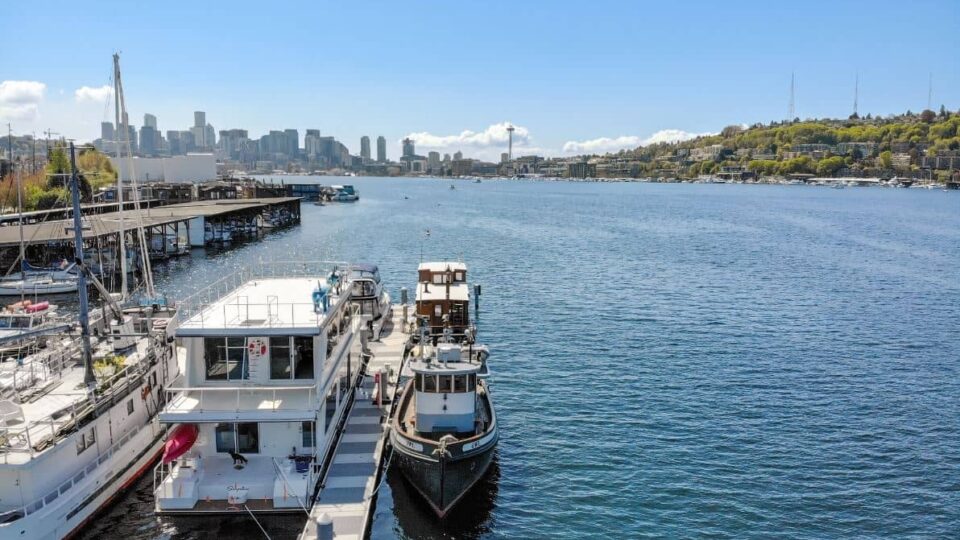
Living on a Boat in California: What you Need to Know (Best Liveaboard Marinas, Costs, etc)
Living aboard your sailboat in California is probably the dream of your life. Or, a target you want to accomplish and then head to another marina or state. In any case, you want to know more information about life aboard in California. There’s no doubting that the liveaboard lifestyle can appeal to a wide range of people, both boaters and non-boaters. California is also a favorite place by many sailors and some of its marinas are preferred for the liveaboard life. With California’s housing crisis, many people have been scurrying to find alternate housing options. Some of them accept living on a boat rather than departing the state in pursuit of a more modest dwelling. So, keep reading in order to know more information about liveaboard life in California!
Introduction: Liveaboard Life in California
In general, living aboard a boat entails a simpler existence. It forces you to put your life on a diet. You place a greater emphasis on the fundamentals, whereas you are less concerned with material possessions. The necessity of downsizing forces one to go in that path. Moreover, it’s a more intimate way of life. You are aware of whatever anyone is doing, especially if you have kids. However, this isn’t always an advantage for the liveaboard life but it can be depending on your perspective. You can definitely tell the other person’s moods, manner, and more about what was going on in their life.
Being able to live comfortably aboard a boat necessitates having enough space. A wise person once stated that a boat shrinks by one foot every day, especially at sea. While this is an overstatement, boats definitely appear to be getting smaller over time. As a result, I advise choosing a boat that you will not outgrow rapidly, perhaps one size larger than the type you believe will suffice. It’s not supposed to be a camping trip, but it is about living comfortably and having enough space. A common question concerning most people about liveaboard life is if liveaboard slips are available and how much they cost. For instance, within Marina del Rey, there are around 15 different anchorages, each with its own set of norms and rules, including living aboard. Some don’t allow it at all, while others have a minimum size requirement, such as 35 feet.
Each marina has its own set of regulations and offers a variety of amenities such as pools, community areas, and parking. When it comes to living aboard, yacht clubs are a popular alternative. Note that the marinas normally charge an additional fee of around 50% for the liveaboard privilege, which helps to offset the increased energy, water, and other costs.
Generally, California is one of the most desirable places to reside . There are several causes for this. California is one of the most entertaining states in the country. Weed is legal, the population is youthful and diverse, and the economy is doing great. Moreover, there are many activities for sports and nature lovers as well as many marinas to choose from. The economy and the weather are the two most important factors.
And, if you plan to live aboard your boat, the weather is very important. This is because there are only about 33 days of rainfall in California each year. In other words, less than once a week. If you live on your boat, the exterior spaces make up a significant portion of your living space. You are effectively losing half of your home if you are forced to live below deck due to inclement weather. In California, this isn’t an issue.
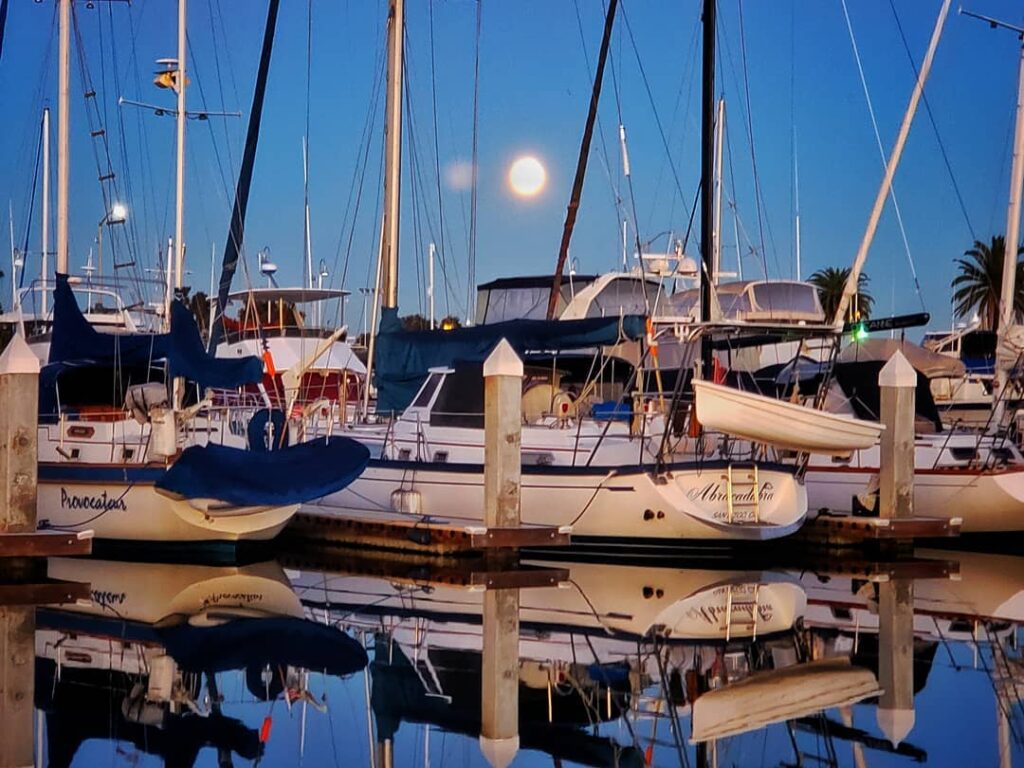
>>Also Read: Best Boating Destinations in California
Costs of Living Aboard in California
California, particularly Los Angeles, is a liberal state. However, your personality and preferences will play a big role in determining whether or not this is right for you . Note that your political beliefs should not determine where you choose to live. Los Angeles, on the other hand, is arguably the most left-wing metropolis in the country. This is neither good nor bad; it is simply something to be aware of. Furthermore, depending on the type of climate you choose, the temperature might be viewed as a positive or negative factor.
It’s time to think about where you’d like to reside once you’ve determined whether or not California is the state for you. For example, San Diego is significantly different from San Francisco in terms of lifestyle. There’s a lot to think about when comparing cities, much alone specific marinas. Renting a marina slip is similar to renting an apartment in terms of commitment. As a result, ensuring you choose the proper one is crucial. You can rent on a weekly basis without a contract, but you will lose your renter’s rights and it will be more expensive. Most marinas will give you a better deal if you sign a long-term contract. Both of you will benefit from the increased security.
The most important costs about the liveaboard life are slip fees, boat insurance, boat mortgage payments, gas, waste management, food, and water. Determining and sticking to a budget is the most effective strategy to control spending. Boat insurance can be as expensive as home insurance, depending on the size and value of the vessel. Because you won’t be heating, cooling, or lighting as much room, property taxes and electricity will be lower. You’ll almost certainly save money on waste management, gas, and water. Maintenance is an area where prices skyrocket. Marine parts and labor are typically more expensive than their domestic counterparts, sometimes by as much as 20%. Keep in mind that slip fees vary considerably depending on the county you will choose to live in.
Best Liveaboard Marinas in California
Liveaboard Marinas in Northern California:
- Safe Harbor Loch Lomond, San Rafael
- Eureka Public Marina, Eureka
- Vallejo Municipal Marina, Vallejo
- Safe Harbor Ballena Isle, Alameda
- Grand Marina, Alameda
- Antioch Marina, Antioch
- Safe Harbor Emeryville, Emeryville
- Napa Valley Yacht Club, Napa Valley
- Tiki Lagoon Resort & Marina, Stockton
- Stockton Downtown Marina
- Owl Harbobr Marina, Isleton
- Delta Bay Marina, Isleton
- Suisun City Marina
- Westpoint Harbor, Redwood City
- Glen Cove Marina
- Stan’s Yolo Marina, Clarksburg
Liveaboard Marinas in Southern California:
- Redondo Beach Marina
- Ventura West Marina
- Safe Harbor Ventura Isle
- Oceans West Marina, Ventura
- Half Moon Marina, San Diego
- Sun Harbor Marina, San Diego
- Harbor Island West Marina, San Diego
- Safe Harbor Cabrillo Isle, San Diego
- Santa Barbara Harbor, Los Angeles
- Marina Harbor Anchorage, Marina Del Rey
- Alamitos Bay Marina, Long Beach
- Shoreline Marina, Long Beach
- California Yacht Marina – Chula Vista
- Loews Crown Isle Marina
- Avalon Harbor, Santa Catalina Island
- Belle Isle Marina, Georgetown
- Vue Marina, Newport Beach
- Seabridge Marina, Oxnard
- Safe Harbor Anacapa Isle, Oxnard
- The Marina at Dana Point
- California Yacht Marina, Cabrillo Marina, San Pedro
- California Yacht Marina, Port Royal Marina, Redondo Beach
- Island Yacht Anchorage, Wilmington
- Cerritos Yacht Anchorage, Wilmington

>>Also Read: Is it Dangerous to Sail from California to Hawaii?
Liveaboard Lifestyle in California
In general, it is rewarding to live on the ocean. You have the freedom to travel, a community living at the docks, and a simple lifestyle to follow. Of course, living on a boat comes with its own set of difficulties. Rain and wind, for example, might pose some difficulties. Also, it’s possible that your next-door neighbor is less-than-ideal at times. It could be difficult if you’re next to someone who is loud or has an untidy boat. Most boating communities, on the other hand, are made up of people who are friendly, respectful of one another’s privacy, and collegial. For instance, the marinas in Ventura Harbor are quite welcoming to liveaboards, giving them a sense of a real boating community. Many liveaboards also have access to the Channel Islands National Park in the west and the mountains in the east.
Being a liveaboard helps to reduce the clutter that is common in land-based dwellings. It’s much simpler on a boat. You realize you don’t require much of the extra belongings you think you need. As a result, you’ll have more money to spend on other things. Outside of the country, you can do a lot of traveling. Living aboard a boat necessitates a willingness to let up material possessions. Learning to live tiny is the most difficult change, but it is also the most liberating, as dock parties, dinners, and events are all prevalent among most Californian marinas. You form friendships with folks you’ll meet during dinner with others.
Most liveaboards state that maintaining a boat can be difficult in California, but that with patience and hard effort, many concerns can be resolved. Everything has a learning curve to it. I don’t think you need to know much about boats to do it; all you need to do is be at ease with yourself and recognize that this isn’t a house; it’s different, and you just have to go with the flow.
The monthly costs of being a liveaboard might vary from one liveaboard to another. A liveaboard who lives aboard a 40-foot sailboat in a marina with a $20 per foot slip fee would pay the marina $800 per month. Electricity, bottom cleaning, topside cleaning, sewage, maintenance, insurance, and taxes are other important costs. These charges could increase monthly living expenses by $500 to $600 or more. Payments on the vessel, if any, are another potential monthly expense.
The Pros and Cons of the Liveaboard Life in California
Moving onboard can be a time-consuming procedure. You have to get rid of everything that won’t fit aboard the boat. This is because you intend to travel for a few years and don’t want to worry about storing your belongings. You might don’t care for the marina’s position as much as others, but the amenities and the community fulfill your needs and preferences. Other times you might really like the location but the marina doesn’t offer cheap slip fees or adequate amenities.
Being a liveaboard does have its drawbacks, however, the precise drawbacks differ from boater to boater. Being a liveaboard can be less expensive than living in a land-based home or apartment. But, the cost of living on a sailboat is ultimately determined by marina fees and the kind, size, and condition of the boat. For example, it’s not easy to find a liveaboard slip at any of the Port of Los Angeles marinas. Living aboard a boat is limited to 5% of available spots at each marina by the Port of Los Angeles. On the other hand, those who choose to live near the Cerritos Channel and the Port of Los Angeles’ East Basin will discover a unique blend of charm and challenges.
Another advantage of the liveaboard life is that you’re always on the water and aware of the weather conditions. Liveaboards may also choose specific marinas in order to make friendships, get away from the hustle and bustle, or just to change their way of living. A very important consideration for liveaboards is safety and security in the marina they choose to live in. Liveaboards detect if a boat is taking on water or if there is a boat that doesn’t belong here because they go by the marina every day. Liveaboards will notify the Port Police if they notice suspicious activity in their marina or the surrounding region because they are familiar with the area.
These are some of the most important questions you have to ask yourself. Is this the right way of life for me? Can I afford to properly maintain and repair my boat? Will I be able to work on board or from the marina of my choice? Is the marina where I want to live offering liveaboard slips right now? How long should I expect to have to wait to become a licensed liveaboard? Is my boat large enough for a family to live on? Will my family be at ease onboard? Will we be ready if something goes wrong with our boat, such as a costly repair or irreversible damage?
For individuals hoping for a quick resolution to their problem of high rent, living on a boat may cause more problems than it solves. Ocean enthusiasts with boating experience (or a desire to gain experience) and a desire to be a part of a close community – as well as patience and a willingness to be open-minded during the process of applying for liveaboard status – will find this a gratifying experience.

Permits and Prices in Certain California Marinas
Note that in all of Long Beach’s marinas, up to 230 liveaboards are permitted. Shoreline Marina in downtown Long Beach has the most liveaboards, with three vessels in Rainbow Harbor/Marina also serving as primary residences (3.5 percent of slip count). Avalon Harbor is home to a small number of boats, who enjoy active summers and occasionally stormy winters. Only a few liveaboard licenses are available on the central Orange County coast, and liveaboards are only allowed on the city’s offshore moorings. A liveaboard may occupy no more than 7% of all offshore moorings in Newport Harbor, according to city regulation. A couple of liveaboards can be found at Sunset Aquatic Park in Huntington Harbour.
Note that the cost of a liveaboard slip in Wilmington is generally lower than that of a marina in Long Beach or San Pedro. The Port of Los Angeles exclusively admits liveaboards for safety and security reasons. Only a few marina managers are liveaboards, and no marina owners dwell at these marinas.
Orange County’s southernmost harbor is in Dana Point Marina. To receive a liveaboard permit in Dana Point, a potential tenant must meet specific standards and pay the required rent and cost. For example, a liveaboard vessel has at least 140 square feet of usable area for one person and an extra 40 square feet for each tenant. The charge for a liveaboard is 40% of the basic slip rate. So, the owner of a 35-footer, the smallest boat allowed in a liveaboard spot, would pay $622 in rent plus $248.80 in liveaboard fees, in Dana Harbor. Liveaboards are also authorized in Redondo Beach and Marina del Rey; however, at Redondo Beach’s King Harbor Marina, liveaboards are not permitted to be near to or across from one another.
Owning the Right Boat, Being in the Right Place
Boats are costly, sometimes exceeding the average cost of a home in the United States, particularly if they meet the criteria for liveaboard status in some marinas. Aside from routine upkeep, persons interested in becoming liveaboards must choose the type of boat that will best meet their needs. Most marinas will have minimum boat size requirements for liveaboard status: it might be as small as a 25-footer or as large as a 30 or 35-footer, depending on the marina. Everything depends on the marina.
There are several trawlers and other boat designs available today that would make living onboard comparable to living in a floating condo, but those boats may come at a cost. If you buy a used boat for a low price, keep in mind that it may require a lot of maintenance. New boats that provide the comfort that some are looking for could cost more than $100,000, with some of the newer vessels costing significantly more than the typical home price. The size of the vessel may also be determined by the number of people living onboard. For example, for a single person, 25-foot vessels are preferable, however for a family of two or more, scaling up may be more convenient.
If you’re thinking of living on a boat, consider saving up enough money to get a newer boat. Spend a few hundred dollars on a marine surveyor once you’ve found the one you want. Like this, there will be no surprises down the road.
Every marina will have its own process for applying for liveaboard status. Some are run by municipalities, while others are run for profit by private companies. Depending on the popularity of the location, municipally-owned harbors will often have a significantly lower restriction or percentage of liveaboards. Note that in order to get a slip, you’ll usually have to wait a lengthy time.
One thing to keep in mind while deciding whether or not a liveaboard is good for you or your family is that while you own the boat, you do not own the boat slip. The marina is essentially renting the slip, which implies there may be an increase in slip rental prices at times. While owning a home provides equity, the value of a boat may depreciate over time. With slip payments, a boat payment (if you don’t own the boat outright), maintenance costs, and so on, living aboard a boat might be comparable to Southern California’s median rental expenses. In other words, living aboard is by no means a cheap or simple alternative.
Living on a Boat in California – The Bottom Line
Hopefully, you now have a solid idea of whether California is the right place for you. In the United States, there are a plethora of wonderful spots to live aboard your sailboat. And, California is unquestionably one of the best states in the country. However, prices can be really expensive. California is not cheap to live in, but you get what you pay for. Good weather, delicious food, and a plethora of activities. If you’re not sure if you want to live there full-time, spend your next holiday anchored at one of the marinas in order to get a grasp of things. It can offer you a taste of what your life might be like if you decide to go ahead and make the move.
So, are you interested in becoming a liveaboard in California? Many marinas provide detailed information to boaters regarding some of the factors involved, such as monthly rates and amenities available. Some marinas have quotas or other restrictions on how many liveaboards are allowed. Make sure to check each harbor’s or marina’s website to see if liveaboards are permitted. What are the rules for liveaboard tenants? Is there a liveaboard slips waiting list? What is the cost of a liveaboard? Also, ask about parking, security, restrooms, showers, communal areas, WiFi access, and proximity to restaurants, freeways, and shopping.
I wish that this article was helpful to your research about living aboard your sailboat in a Californian marina or harbor. Wish you all safe & pleasant voyages!
Peter is the editor of Better Sailing. He has sailed for countless hours and has maintained his own boats and sailboats for years. After years of trial and error, he decided to start this website to share the knowledge.
Related Posts

Sailing with Friends: Tie Knots, Navigate the Seas and Create Unforgettable Memories

Atlantic vs Pacific: Which is More Dangerous for Sailing?

Why Do Sailboats Lean?

How Does a Boat Sail Upwind? Unveiling the Mechanics of Against the Wind Sailing
- Buyer's Guide
- Destinations
- Maintenance
- Sailing Info
Hit enter to search or ESC to close.

Cost To Live On A Sailboat In The Caribbean

Last Updated by
Daniel Wade
June 15, 2022
So, you've decided that you want to commit to living on your sailboat, and, you've chosen the Caribbean.
Why wouldn't you? It's beautiful, warm, the people are friendly, the food is great, the fishing is top-notch, and their entire way of life is relaxing.
The Caribbean is an awesome place to live, especially if you are lucky enough to do so on your sailboat. There are some things you might want to consider before moving out there, though. Such as, can you afford it? The chances are you could afford a marina slip, at least if you could afford one in America. But is the marina going to be up to the standards you were hoping for? Will you even be able to afford it without working, or with reduced income. Is the Caribbean even the right place for you? This article answers all of that and more!
Table of contents
How much does it cost to live on a sailboat in the Caribbean?
Living in the Caribbean isn't quite as cheap as most people expect it to be. It isn't going to be crazy expensive, at least it doesn't have to be. You can get a pretty nice marina slip in the Caribbean for about $1000 a month. This is going to get you some security, some decent amenities, and a nice location. You could "slum it" and get a far cheaper marina slip near where the locals will dock their boats, but you aren't getting all the added pleasantries and amenities. You might also find yourself quite far out of town. To put that in perspective, a year's worth of accommodation in the Caribbean will only cost you about $12k. Far less than rent might be, and certainly far less than organizing some sort of vacation accommodation. If you choose to live in one of the smaller, for lack of a better word poorer, island nations you will find that your money goes a lot further. You could rent a luxury marina slip for just a few hundred dollars a month. The Dominican Republic is a good example of this.
You must also consider how you are going to be paying tax when you are living here. If you are only technically visiting (just a few months) and are still technically living in the US, you can avoid paying income tax in your host nation. This isn't ethically or legally wrong so long as you do only stay a few months here and a few months there. If you plan to pick one country and live there long term, make sure you register with the country. It is easiest to do this before you go but can be done locally in most cases. If you are unsure what to do, you can always give the American consulate a call. They should be able to help you out. Maintenance is also something that many people fail to consider fully before making the move.
When you move to a new country you need to find a new everything. A new doctor, dentist, mechanic, grocery store, gym, etc. This is part of the fun of moving, at least it is for most people. The problem is when you move somewhere new with a sailboat you must immediately find a good boat repair yard and storage dock. These costs vary from island to island, of course. But you will find it is generally cheaper than the US. Don't be thrown off by low prices when looking at repairs. Labor is much cheaper here. Use your gut instinct when deciding if a boat repairman seems legit. Storage is also something you will need to consider, especially if you plan on going on vacation without the boat. And, perhaps the rainy season if you plan on sticking around. A good storage facility will be about $10-$15 per foot. Much less than you might be paying in the states. (perhaps about $40 per foot).
The cost of living should drop pretty drastically. Food, liquor, and basic amenities will be far cheaper than you have likely ever seen before. But, some of the brand names "luxury" items that you may not want to live without might end up costing you an arm and a leg. Do you want Lucky Charms for breakfast? Because there is a good chance they won't have them. And if they do, they'll fleece you for as much as they can. This is how any country operates with products a select few people want and are also hard to come by. If you are a flexible person, making this adjustment shouldn't be too hard. Who knows, perhaps you'll find a new favorite!
Why would you want to live on a sailboat?
There are lots of great reasons to live on a sailboat in the Caribbean. It allows you to sail around and go where you please. The island nations of the Caribbean are all spectacularly beautiful and pretty relaxed when it comes to immigration. You will be changing countries whenever you arrive at a new island (usually), but many won't even ask for a passport on arrival. You should have one, of course. But it is nice that you can take it easy. Living on your sailboat can also give you the peacefulness and quiet you are very likely seeking. You can drop anchor anywhere you like, in any of the calmer water at least, and just relax and unwind. Living on your boat also gives you the adventure so many of us crave. Being able to explore those historic islands, following the routes of long sunken trade ships from pre-industrial Europe. What an opportunity. Something very few people can do.
Why would you want to live in the Caribbean?
There are so many great reasons for living in the Caribbean. If you have never been, the way of life can be a little hard to describe. It is a unique pace of life. People there value things differently. I think it is fair to say that they are generally more relaxed and welcoming to outsiders than most other countries. In part, because they are inherently friendly people. And also, because such a large amount of many of the island's income is reliant on tourists. Being friendly, and being safe, is of paramount importance. That's why the islands are such a great place to live. Or vacation. When you are living there, the two almost blend into one.
The Caribbean is also incredibly diverse. So many countries bustled up together with tourists from the world over has created a true cultural melting pot. If you want a chance to meet people from all over the world, this is the place to do it. Plus, you likely won't see them again. At least not often. The benefit of making friends with tourists, they are very casual relationships. This can be good or bad depending on your perspective. This also means there are endless places to eat, cuisines to try, and cocktails to sample. The islands try to accommodate everyone, this is aimed at tourists of course, but you can take advantage of it all the same.
The Caribbean is also quite reasonably priced. Everything that isn't aimed at tourists is priced for the locals, meaning it is pretty cheap. This doesn't help you with the luxury items, but the everyday essentials you are good to go. Having a good job and moving to an area where your dollars stretch further is a good way to either save money or live a life that was normally out of your means. That choice would be up to you - if it were me though, I would go for the extra savings. Maybe put that extra money towards some luxuries on the boat. Like a TV and a SatPhone or a satellite internet router.
What are some things you should know about sailing in the Caribbean?
The Caribbean is a great place to sail. The waters are normally pretty calm, the conditions are generally good, and the maritime laws are relaxed enough that you can feel at ease but strict enough that it isn't total mayhem. One thing to consider is the depth of your hull. You see, the Caribbean waters are rather shallow. At least close to the mainland. The waters are shallow and the sea bed is made of sharp shale. The chance of you scuppering yourself is quite high. This is why so many ships swap out their fin keels for a torpedo-shaped one. Or, they simply cut half of the fin off. Learning to navigate shallow waters is a good idea before you arrive. That and having a decent depth finder onboard.
You will also want to be wary of the rainy season. That is May to October for most places. The rain itself isn't a problem, so long as you don't mind being confined to your ship for a short while. The real problem is the storms. Cyclones are not uncommon. They arrive multiple times during the rainy season. If you have lived on the east coast of America, you are likely used to getting cyclones to blow in from far out at sea. Well, most of those storms make landfall in the Caribbean first. Meaning what you have seen in America is only a taste of what's to come. This is fine if you live on the island. Storm shutters, a fully stocked pantry, and a backup generator are enough to see you through the worst of it. On your sailboat though, you are at serious risk of capsizing. You may want to find a friend who will allow you to wait out the storm in their home. Or book yourself into a hotel. That will save you, but your ship is at the mercy of the storm.
Tips for sustaining yourself while living/working in the Caribbean
If you are planning on living in the Caribbean, the best advice would be to secure a remote working job (or jobs) before you go. Wages on the islands reflect the general economy. They are poor paying, to say the least. Unless you can get a high up job at one of the hotels or one of the few business firms. If you plan on moving around, from island to island, the best idea is to start your own business that can be run from home. One that doesn't need a physical presence, just a wifi connection. Having a hefty savings account before you go is the best way to ensure you have some breathing room. If you are lucky enough to have already retired, well your pension check should be enough to cover you. And then some!
Conclusion:
Hopefully, this article has given you a good idea about how much it can cost living in the Caribbean. And, how feasible living there truly is. If you don't have a source of income pre-planned you aren't ready to move. Having a nice savings account and at least $1000 a month to spend on the marina slip is a good starting point. The scale of value in the Caribbean is pretty great. Meaning, a $1000 marina in the Caribbean will be amazing. A $2000 one will be out of this world. You will get far more for your money than you would in most places in the US. If you are looking to cut costs, bring some good fishing rods with you. The fishing in the Caribbean is phenomenal. You'll have a blast. Good luck with the move, make sure you are fully prepared financially before you set sail. And remember - Don't forget your passport!
Related Articles
I've personally had thousands of questions about sailing and sailboats over the years. As I learn and experience sailing, and the community, I share the answers that work and make sense to me, here on Life of Sailing.
by this author
Destinations
Financial and Budgeting
Most Recent

What Does "Sailing By The Lee" Mean?
October 3, 2023

The Best Sailing Schools And Programs: Reviews & Ratings
September 26, 2023
Important Legal Info
Lifeofsailing.com is a participant in the Amazon Services LLC Associates Program, an affiliate advertising program designed to provide a means for sites to earn advertising fees by advertising and linking to Amazon. This site also participates in other affiliate programs and is compensated for referring traffic and business to these companies.
Similar Posts

Best Bluewater Sailboats Under $50K
December 28, 2023

How To Choose The Right Sailing Instructor
August 16, 2023

Best Sailing Destinations In BC
June 28, 2023
Popular Posts

Best Liveaboard Catamaran Sailboats

Can a Novice Sail Around the World?
Elizabeth O'Malley

4 Best Electric Outboard Motors

How Long Did It Take The Vikings To Sail To England?

10 Best Sailboat Brands (And Why)
December 20, 2023

7 Best Places To Liveaboard A Sailboat
Get the best sailing content.
Top Rated Posts
Lifeofsailing.com is a participant in the Amazon Services LLC Associates Program, an affiliate advertising program designed to provide a means for sites to earn advertising fees by advertising and linking to Amazon. This site also participates in other affiliate programs and is compensated for referring traffic and business to these companies. (866) 342-SAIL
© 2024 Life of Sailing Email: [email protected] Address: 11816 Inwood Rd #3024 Dallas, TX 75244 Disclaimer Privacy Policy

IMAGES
VIDEO
COMMENTS
Insurance ($233) If you are a newbie cruiser, your boat insurance options will most likely be limited. Insurance was a considerable expense in our first year. In our second year, the cost dropped from 2.8% of the boat's value to 1.3%. (We now have restricted cruising grounds for July - November.)
The first cost to consider when living on a sailboat is the marina fees/slip fees. The marina costs for a sailboat are approximately $10 to $20 per foot per month. For example, a sailboat owner with a boat size of 30 feet will typically pay between $300 and $600 per month in slip fees to stay at a marina. A marina will charge a boat owner on a ...
Sample Liveaboard Budget. Now that we've covered the basic expenses to expect when living aboard, we'll put together a sample liveaboard budget. The figures are based on someone making a monthly income of $4,000 docking a 30-foot sailboat at a reasonably priced marina. Monthly Expense.
How Much Does Living on a Sailboat Full-Time Cost? Living aboard a boat will generally cost somewhere between $500 and $10,000 per month at either extreme. For most, it's probably somewhere close to $1,500 - $5000. We spend somewhere around $2,500 per month living on a boat in the Mediterranean.
The cost of living on a sailboat can vary depending on individual preferences and circumstances. Some people spend less than $1,000 a month, while others spend upwards of $10,000. On average, the monthly cost is around $2,424, including expenses such as maintenance, insurance, provisions, marina fees, fuel, internet, entertainment, personal ...
Living on a sailboat offers freedom and flexibility: It allows individuals to have a nomadic lifestyle and explore different locations at their own pace. Living on a sailboat is a cost-effective lifestyle: Compared to traditional living arrangements, the expenses associated with living on a sailboat can be significantly lower.
Financial considerations are paramount, as the cost of living on a sailboat can vary widely depending on factors like marina fees, maintenance costs, and lifestyle choices. Setting a realistic budget that includes regular maintenance, unexpected repairs, and living expenses is essential for sustaining life at sea. ...
The cost of living on a sailboat full-time is approximately $1,880 per month or $22,560 per year. (Source: deepsailing.com) Marina fees for a sailboat range from $10 to $20 per foot per month.
Living on a sailboat is possible if you find the right boat, stay organized, manage maintenance and utilities effectively, make an income, and choose a suitable marina. Anyone who follows these steps can live a frugal and comfortable life on a sailboat. ... New sailboats cost upwards of $150,000-but don't use this price as a benchmark for ...
The cost of living on a boat varies greatly depending on your lifestyle. For instance, eating ashore is always more expensive than preparing a meal onboard, and staying a marina costs a lot more than anchoring for free.
Living on a sailboat is an adventure which requires a complete lifestyle change for most people. So, what are the pros and cons of living on a sailboat? ... You're looking at a cost of around $4000 for new sails and about the same for new bimini and dodger canvas. Weather.
Real cost of living on a sailboat: $500 to $3k per month. Our Cost of Living: Sailing Around the World (Dana Greyson): $1,500 to $2,500 a month. Top 10 Aspects of Living on a Boat: $460 a month. Cruising Budget for the Third Year on a New Catamaran: $32k per year. Lots of information here and quite a spread on costs.
One parting thought: Living on a boat full time and traveling is like having three or four full-time jobs. Each requires 30-40 hours per week when you include labor, research, and thinking and planning. Boat ownership — basic maintenance and cleaning. Cruising full-time — destination and route planning, weather study.
Get the boat ready for life aboard, not just a weekend in the islands. Prepare the boat before you move so it feels like a home, not a camper. If you move from a 2,000-square foot house to a 45-foot boat, you may have a two-bed/two bath waterfront condo but all the closets are smaller, the cupboards are fewer and there's no two-car garage.
Boat Purchase: The initial cost of acquiring a boat can vary greatly depending on the type, size, age, and condition of the vessel. Whether you buy new or used, this is often the most significant upfront expense. ... Navigating Legal and Regulatory Aspects of start living sailboat life. As you prepare to embark on the full-time boat living ...
Boat Life 101: How to Live on a Boat and Travel the World! (2024) Waves lap at the hull of the boat. Your feet are in the glassy water, a glass of rum in your hand, and a glorious sunset in front of you. Of course, the weather is perrrfect. Just another day in the life of living on a boat.
You can get it cheaper but there are no recommended surveyors in Sicily so we made the decision to fly one in from the UK. That way there weren't any language barriers either. We were slightly unlucky that the marina the sailboat was in was such an expensive one to get a lift out, you can get lifted out for more like £200-£300 ($250 - $380 USD) in other boatyards.
Many people don't like to talk about money. But it's hard to plan a BIG life change on hypotheticals. Here are our costs to live & travel on an Off Grid Sai...
Finding an affordable sailboat can greatly reduce the overall cost of living the liveaboard lifestyle. Some sailboats that have full-time living accommodations can be found for less than $20,000, making them highly affordable compared to many alternatives. ... You can find this affordable liveaboard sailboat for a fraction of the cost of a new ...
Many marinas charge a transitory fee on a daily, weekly, or monthly basis, with discounts for longer stays. Annual slip holders, on the other hand, benefit from the best rates. In Florida, monthly slips for a 40-foot sailboat can cost anything from $800 to well over $2,000 per month.
The upfront costs for living on a sailboat for free include the boat itself, the solar system, a chartplotter, fishing equipment, a vegetable garden, a watermaker, and a dinghy. (Source: Our Team) The monthly cost of living for free on a sailboat ranges from $200 to $500, which includes maintenance, fuel, canned food, and a MiFi device.
But, the cost of living on a sailboat is ultimately determined by marina fees and the kind, size, and condition of the boat. For example, it's not easy to find a liveaboard slip at any of the Port of Los Angeles marinas. Living aboard a boat is limited to 5% of available spots at each marina by the Port of Los Angeles.
A good storage facility will be about $10-$15 per foot. Much less than you might be paying in the states. (perhaps about $40 per foot). The cost of living should drop pretty drastically. Food, liquor, and basic amenities will be far cheaper than you have likely ever seen before.